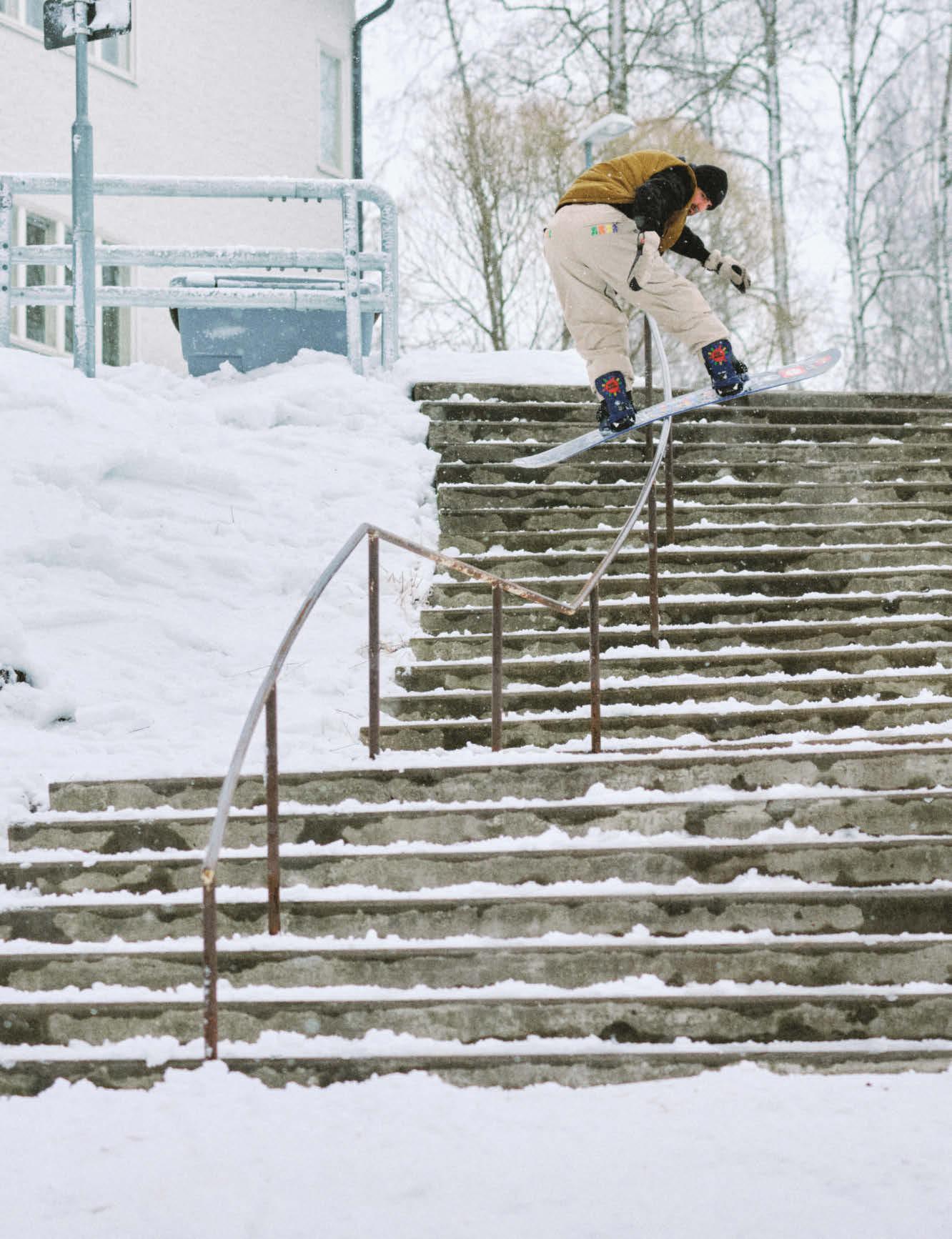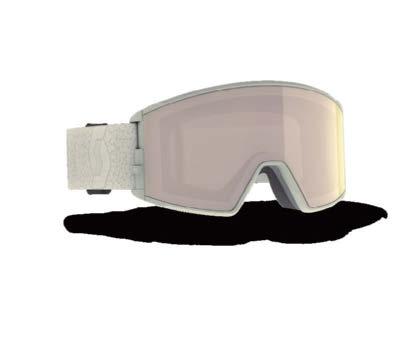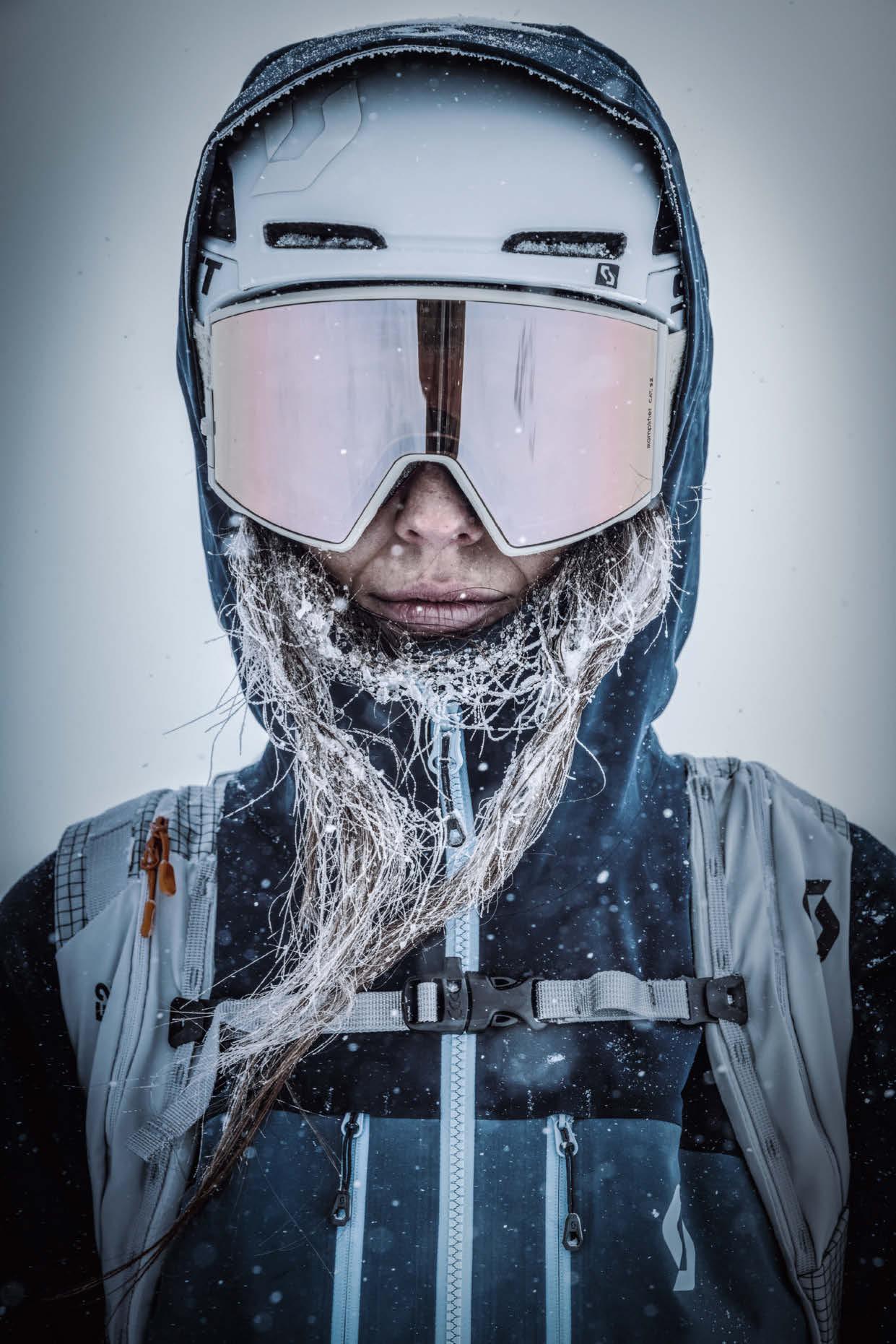












Need to shift a bulky load? The Cargo Hybrid is the environmentally friendly solution you‘ve been looking for: simple, easy to ride and endlessly versatile. Powered by Bosch‘s fourth generation drive system and featuring an EPP foam carrier, it‘s the best excuse yet to ditch the car.
CUBEBIKESUK / www.cube-bikes.co.uk
 CUBE CARGO HYBRID
CUBE CARGO HYBRID

If you’re on an upwards trajectory in life, your next challenge is usually bigger and more impressive than your last. In this month’s issue of The Red Bulletin, we speak to stars from a variety of fields of excellence, from the stage to the slopes, to discover how they’ve managed to hit new heights.
The London-based photographer, who has shot musicians including FKA twigs and Kendrick Lamar, was in her element at our shoot with Nova Twins for this month’s cover feature. “It was really fun,” Smith says. “Nova Twins had a really great energy and sense of style – I love their clothing designs.” Page 30

Having begun by performing in London pubs as teenagers, self-starting duo Nova Twins (page 30), aka Amy Love and Georgia South, are challenging stereotypes to create a unique space for themselves in the alt-rock scene. We catch up with the outspoken band backstage in Brixton at their biggest-ever gig – their final date in a long but rewarding year of touring – to find out how their uncompromising approach has won them fans including Elton John and Tom Morello.
After winning an Olympic gold, multiple world championships and setting (and resetting) records at a furious pace, it might seem as if triathlete Kristian Blummenfelt (page 52) doesn’t have much left to prove. But, as the Norwegian tells us, his next test will be something no one else has even attempted before.
And we hit the powder with American snowboarder
“I’ve known Ben Ferguson for a long time, and I’ve enjoyed watching him develop into one of the best snowboarders on Earth,” says the Oregon-based journalist and longtime editor of Snowboarder magazine, who wrote our feature on Ferguson’s film Fleeting Time

“The production was an epic documentation of two seasons with Ben and his handpicked crew of riders. I loved every second of it.” Page 42
Ben Ferguson (page 42) as he pushes his high-octane career to the next level –progressing from starring in his idols’ films to directing them in his own.
Enjoy the issue.

8 Gallery: highlights from global photography contest Red Bull Illume, including drench warfare in a Dutch skatepark; the stark face of a Chilean environmental disaster; kitesurfing in the Netherlands, and trees company in the frozen forests of Utah
15 Tech, no; classics, yes: four tracks guaranteed a rewind from British DJ icon Carl Cox
16 SWG3: the Glasgow venue whose punters really bring the energy on a Saturday night
19 motherEarth International: promoting natural expression for the sake of our planet
20 Griffin Post: the adventurer who reclaimed exploring’s lost past
22 10IronWomen: challenging the gender imbalance in Ironman
24 Cariad Lloyd
The comedian and podcaster on confronting grief with laughs
26 Lady Blackbird
The ‘Grace Jones of jazz’ takes flight at last
28 Mondo Duplantis
Mental hacks for the champion pole vaulter and beyond
30 Nova Twins
Meet the gnarly British duo who are shredding rock stereotypes and kicking down doors in the music industry
42 Fleeting Time
Behind the scenes of professional snowboarder turned filmmaker Ben Ferguson’s globe-spanning epic

52 Kristian Blummenfelt
The Norwegian is a colossus in the world of triathlon – but there’s one challenge he has yet to conquer
62 Frankie Perez
The New York photographer and B-Boy opens his portfolio
75 Northern delights: trekking on the Norwegian island of Senja is off the grid and off the charts
80 Wild style: don’t stray off-piste without this ski-touring gear
83 In the loop: the biking discipline where it’s not how you pedal but how you pump
84 AC75: the racing yacht that thinks it’s a plane and is set to fly at the 2024 America’s Cup
88 How to survive an encounter with a croc (no elastic band required)
90 Own a bike? Got a head? We’ve found the helmet for you
92 Playback time: the art of remastering classic games
93 Pet project: the Tamagotchi goes K-pop
94 Essential dates for your calendar
98 Outdoors wisdom from Semi-Rad
When Aaron Zwaal attends a shoot, it can mean one of two things. The Dutch lensman doesn’t only take pictures of athletes like BMXer Daniel Wedemeijer, seen here; since 2018, he’s worked as a military photographer for his country’s Ministry of Defence. (We’re all about rides, not rifles, so you’ll have to visit his website for that.)
Shooting Wedemeijer – with a camera – earned Zwaal a semi-final place in the ‘Energy by Red Bull Photography’ category of Red Bull Illume.
“Daniel asked me to take a photo for a flyer for a BMX event,” says Zwaal, “but we made the most of the shoot while we were there. We were blessed with a dry skatepark and some puddles, which resulted in this close tyre slide… and a wet camera.” aaronzwaal.com; redbullillume.com
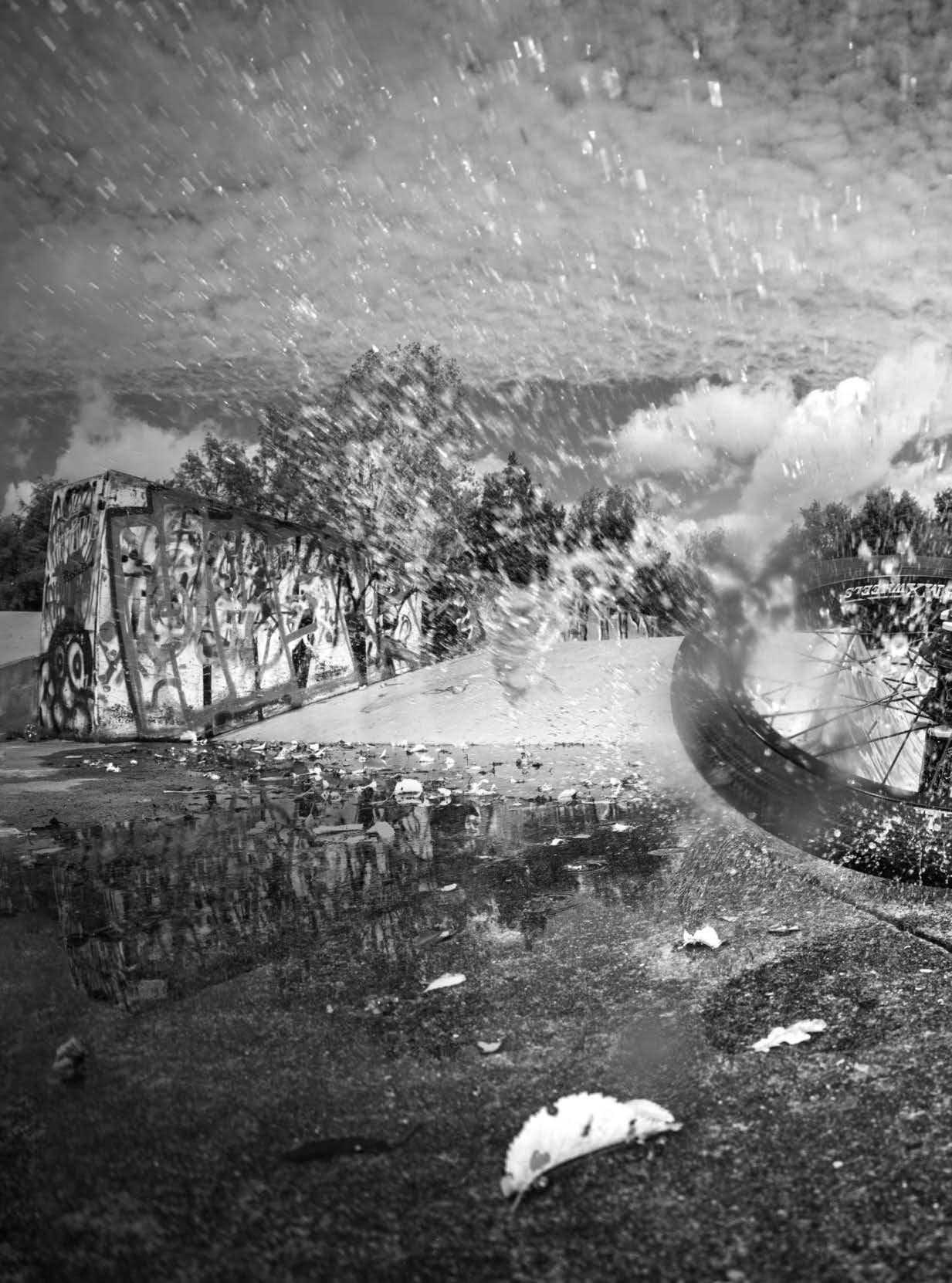

Outdoor sports photography isn’t only about capturing the gnarliest ride or most audacious aerial stunt; sometimes it can highlight global problems. Take this photo of Chilean athlete Hernán Rodríguez climbing in Cajón del Maipo, a gorge close to his nation’s capital, Santiago. The image featured in a campaign by outdoors brand Patagonia on the environmental impact of the Alto Maipo Hydroelectric Project, a widely opposed initiative that diverts water from the Andes through 70km-long tunnels. “It’s killing and drying up this valley,” says photographer Patricio José Díaz Rios, whose shot earned him a semi-final place in the ‘Emerging by Black Diamond’ category of Red Bull Illume. “The environmental campaign [by Patagonia] is trying to protect the valley, the rivers, the local people, and the multiple outdoor sports that are possible [here].” redbullillume.com


Rein Rijke’s global photographic project The Last Line, featuring pro kitesurfer Roderick Pijls, also has environmental destruction as its focus.
“[The title] refers to the last line Roderick can surf, because all the places we visit are affected by human interventions that cause climate change,” explains the Dutch lensman. When the pandemic hit, they were temporarily forced to go local, but this was no hindrance for Rijke:
“Kitesurfing the Waddenzee with low tides has been on my list to visit for a long time. It’s a salt-marsh wilderness, and the high and low tides have a great influence on the area. That gives a very unique perspective from the sky.”
The project won sizeable acclaim from Red Bull Illume; this shot was a semi-finalist in the ‘Masterpiece by SanDisk Professional’ category. zoutfotographie.nl; redbullillume.com

Working with a friend has its merits: there’s the companionship, the camaraderie, the suffocating familiarity… (Joke.) Wisconsin-born photographer Noah Wetzel and pro snow-sports athlete Conor Pelton have skied together for more than a decade, and from this friendship great things have sprouted. Like this image – a ‘RAW by Leica’ semifinalist in Red Bull Illume. “Aspen trees are my favourite,” Wetzel says, “and utilising wireless flashes allows one to create compelling and unique imagery. On point as always, Conor aired through the tight gap in darkness – and fogged goggles – and skied cleanly out of the frame.” noahdavidwetzel.com; redbullillume.com
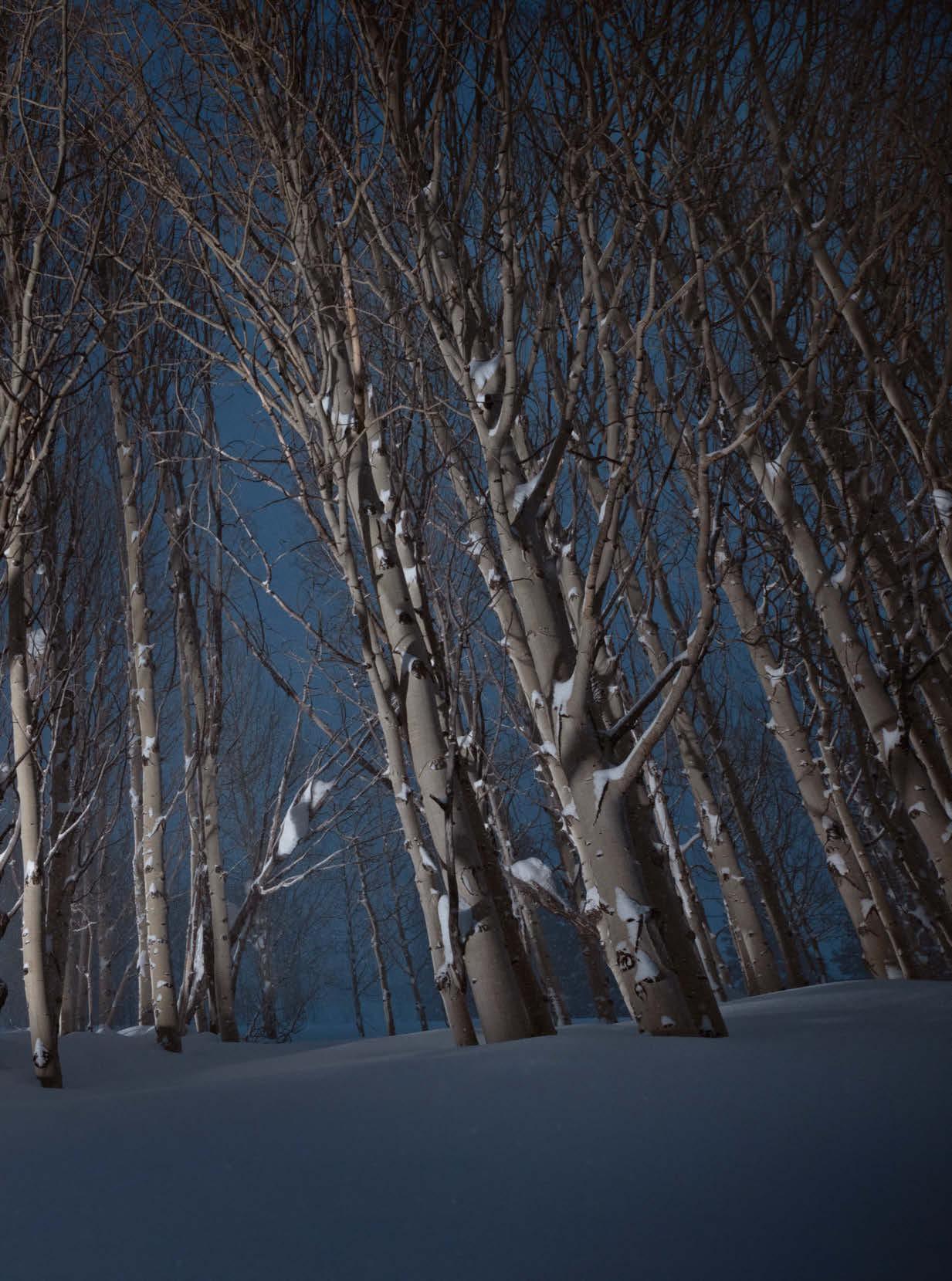

The iconic British DJ on the tracks that helped shape his musical journey
Carl Cox exploded onto the DJ scene in the late ’80s and has become British dance-music royalty. Over the past four decades, the now 60-yearold DJ/producer has performed at the Houses of Parliament, seen in the Millennium behind the decks twice (in Sydney, then again after flying to Hawaii), and closed Ibiza’s Space nightclub with a nine-hour set. Though best known for spinning house and techno, Cox says his music is inspired by a range of genres. “I take elements from everything I’ve listened to and create my own sound,” he says. Here, Cox picks some of the tracks that have stayed with him.

Carl Cox’s new album Electronic Generations is out now; carlcox.com
Idris Muhammad

Could Heaven Ever Be
Like This (1977)
“A lot of people don’t know I was a dancer before being a DJ. I remember hearing this track in a club and it drew me to the dancefloor. It just took me. I danced my ass off from beginning to end, and I never wanted it to stop. I wasn’t interested in football, girls, nothing, only that moment with the music, which made my life complete at that particular time.”
David Bowie
Golden Years (1975)

“I got exposed to this through the radio. When I first heard it, I thought David Bowie was Black; I thought someone with a voice like that could only be Black. Then I saw him perform the song on Soul Train, a Black TV show with Black artists, and this skinny white guy comes out with different coloured eyes and messed-up teeth. It was so soulful and meaningful. It broke down barriers and glued everything together.”
Mike Oldfield
Tubular Bells, Parts One and Two (1973)

“Even before hearing this, I was intrigued by the concept. I first heard it in a record store and didn’t really get it, but I bought it anyway so I could digest it at home. I invited some school friends over and played it to them – nobody moved or said anything. Then I played Part One again and everyone was blown away. It’s probably one of the most beautiful pieces of music I’ve ever heard.”
That’s the Way (I Like It) (1975)
“This is a very positive record. It’s a song that has got me through lots of ups and downs in my life. I got divorced many years ago, had my home broken into a few times, car stolen, all that kind of stuff… Not everything goes your way, but put this record on and, for one moment in your life, you forget about everything – KC makes it alright. It’s always been synonymous with my life.”
 CARL COX
CARL COX
This Glasgow nightclub is cutting its carbon emissions by upping its bpm

There’s nothing quite like surrendering to the beat and losing yourself on a packed dancefloor. While it might not be possible to bottle that rapturous feeling, one club in Glasgow has found a way to harness the energy of an epic night out in another way: by capturing dancers’ body heat and using it to power one of the world’s most innovative renewable heating and cooling systems.
Every year, 250,000 people pass through the doors of Glasgow arts venue SWG3 to view exhibitions, watch live music acts and attend club nights. But since last October these visitors haven’t just served as punters, they’ve also played a role in powering the building.
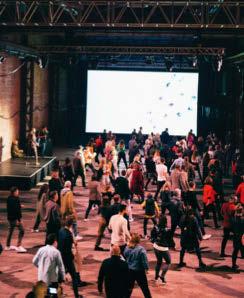
The BODYHEAT system is the brainchild of David Townsend,
founder of geothermal energy consultancy TownRock Energy. After spending the first decade of his career “nerding out over how to address climate change using rocks”, Townsend combined his love of music and his knowledge of geothermal energy. “When you’re clubbing, it gets very hot. A lot of these places aren’t particularly well cooled; even if they are, that heat is just dumped out into the air instead of being reused. The same venue would then burn gas the next day to heat up the place. That just seemed silly.”
His solution was to build a system that stores clubbers’
expelled body heat in 12 200mdeep boreholes beneath the venue. This captured energy can then be reused to heat or cool the building either instantly or in the days, weeks, months or even years to come. Townsend compares it to “charging a thermal battery”. He continues, “If someone is just idling, sitting on a couch watching TV, they might generate 100 to 150 watts in waste heat. But when someone is dancing hard, they could generate 500 or 600 watts. So if there were 1,000 people dancing hard for five hours, we could heat 83 houses for five hours.”
For SWG3, the BODYHEAT system presented a means of achieving its goal of net-zero carbon emissions by the end of 2025. “I was very conscious that we operated out of these old warehouse spaces that don’t perform well environmentally,” says SWG3’s managing director, Andrew Fleming-Brown. “The idea that our audience could be a source of energy, it kind of blew my mind a little bit. But when you put yourself in that hot, sweaty club environment it quickly starts to make sense… With BODYHEAT operating fully, our annual carbon use should reduce from 120 tonnes to 70.”
This particular system is bespoke to SWG3 and took three years and 17 design drafts to perfect, but there is scope for similar systems to be used in nightclubs and venues all over the world. Going forward, sensors are being installed at the Glasgow venue with algorithms that could monitor energy generation over specific club nights or even DJ sets.
Boiler room: guests work up a sweat at SWG3’s BODYHEAT launch event
“Very soon, we’d have sufficient instrumentation that would allow us to compare DJs,” says Townsend. “You could get in Tiësto versus David Guetta, or Skrillex versus Showtek, and see who could heat up the most houses in a night.” swg3.tv



Introducing the new standard in electric road and gravel bikes: the Solace eRIDE. Quiet, e cient and with a near zero drag motor, the Solace is a highly versatile do-it-all endurance e-bike.
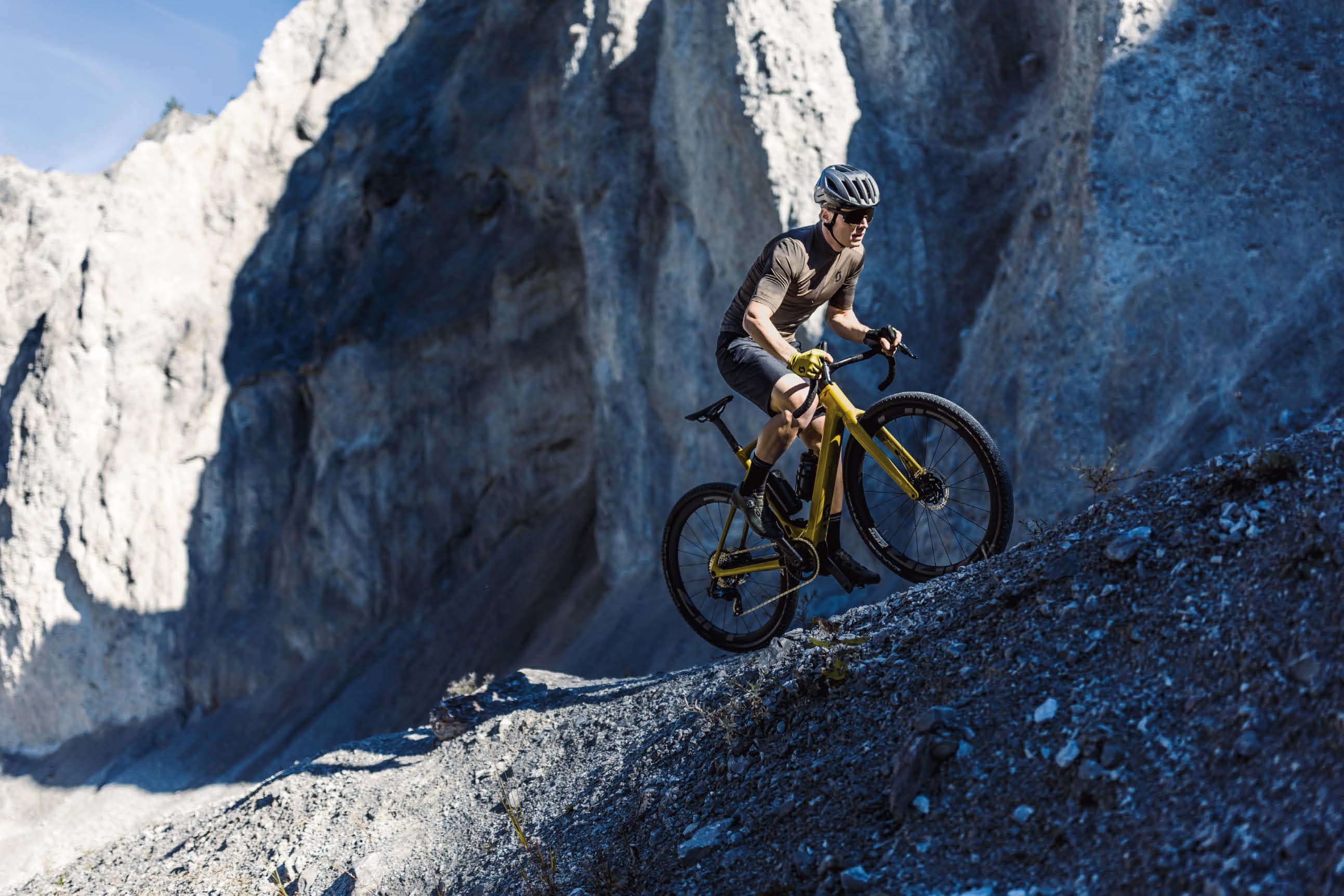


MIPS ROTATIONAL IMPACT BRAIN PROTECTION SYSTEM
• 2-WAY ADJUSTABLE SCREWLESS VISOR
• TLD PRECISION FIT SYSTEM WITH 3 HEIGHT SETTINGS
• 14 HI-FLOW VENTILATION PORTS
• FULL WRAP IN-MOULD CONSTRUCTION
• EXTENDED COVERAGE MTB TRAIL HELMET
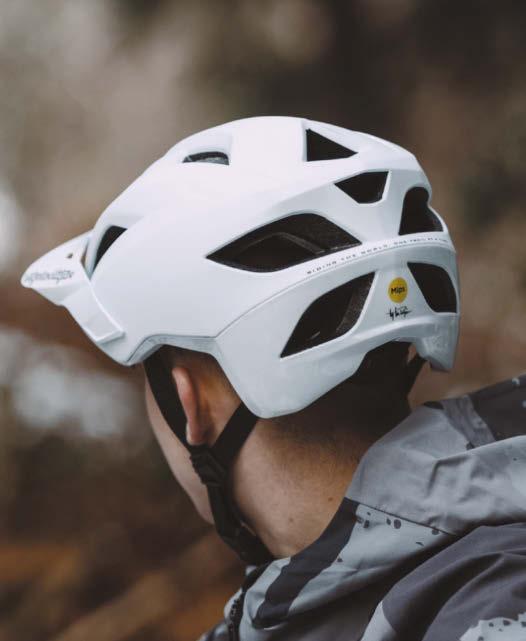

• DUAL DENSITY EPS
• ANTIMICROBIAL COMFORT LINER
Five bodies dance across burnt brown grass in the aftermath of the UK’s 2022 heatwave. Almost 10,000km away, in Taiwan’s Hualien County, a line of dancers in matching red robes move in unison before a diminishing coastline. And in the village of Bahía Creek in Argentina’s Río Negro province, a woman emerges from a lake, her hair plastered across her face. As she walks through the landscape, her long white dress becomes ensnared by more and more strands of plastic, which drag behind her, pulling her back.
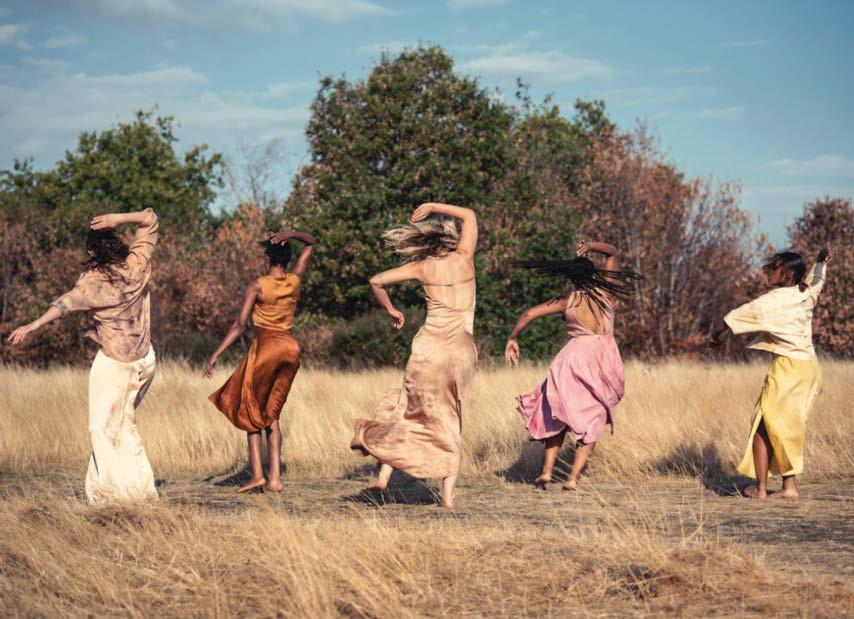
These are just some of the performances in Better Late than Never, a collection of short films funded by the British Council. The films, along with a podcast series, are part of the motherEarth International project conceived by filmmaker Josie Dale-Jones and her theatre company ThisEgg, and developed with producer Sekeenat Karim. Made in collaboration with dancers, filmmakers and creatives in the UK, Mexico, Brazil, Ukraine, Taiwan, Denmark Argentina and Indonesia, Better Late than Never is an emotional response to the climate crisis that explores how all of us are
connected to the emergency, even if regional issues differ.
While Dale-Jones and Karim led online workshops in filming, sound, choreography and creating sustainable costumes, all the performers were given full creative licence. “Dance as a medium is expressive,” says Karim. “There are certain things that cannot be expressed through words, but through movement you can understand how people on the other side of the world are feeling. Eco-anxiety is real, and people are really starting to experience it. It was important for these films to empower people but not create a scare that stops anyone connecting with the subject.”
Using the medium of movement, the project explores factors such as consumerism, oil mining, water extraction, coastal erosion and deforestation, with the aim of highlighting and clarifying nuanced aspects of the climate crisis. “We go from exploring the effects of the UK’s hottest year on record to examining how clean water has been extracted by corporations in Mexico,” says Karim. “I feel strongly that the arts are a good way for people to understand.
There’s no corner of the planet unaffected by the climate crisis. This collection of artists from all over the world have united to inspire global action
It’s accessible, compared with blogs and articles that aren’t always easy to penetrate.”
Launched during and shown at COP27 in Egypt last November, Better Late than Never has also had screenings in the UK, Argentina and Indonesia, with plans for more this year. And the podcast series further explores the climate events expressed in each country’s performance. “We want to show that climate change is everyone’s battle,” says Karim. “Having different locations and showing each country’s priorities, to understand the differences in how we view things, was integral. Because when it comes to the climate crisis, what’s mine is yours and we’re all in this together.” motherearthinternational.org
How a mission to a remote glacier uncovered a lost slice of history
On the penultimate afternoon of Griffin Post’s seven-day mission last August on the vast and remote Walsh Glacier, deep inside Canada’s Yukon Territory, it looked as if his expedition had failed. This was his second attempt to find a cache of equipment left behind by the famed explorer Bradford Washburn in 1937, but after six days in the unforgiving landscape of ice and rock, hope was fading.
“That last evening, the mood was pretty sombre,” says Post, a pro skier and adventurer. “I’d come to terms that we weren’t going to find it, that it was time to let this project go and move on.”
It was a project the 39-yearold Austrian-born American had
University of Ottawa had a breakthrough. She noticed two gaps in a moraine –the debris that builds when two glaciers come together – and concluded that they corresponded with glacial surges much larger than predicted. This meant that despite months of studying historic photos, satellite data and maps to calculate where Washburn’s camp may have been, Post might be looking in completely the wrong place.
“The crew had worked so hard,” he says. “I think we’d each walked 100 kilometres over the past six days, but we had to run it to the bitter end. We got up early and went two kilometres further than the furthest initial estimates.”
Within half an hour, they found goggles and a fuel canister that were undoubtedly from the 1930s. With their helicopter en route, Post asked for more time. Then came the proof that Medrzycka was right and the cache had shifted 20km from its original position.
“We all saw it at the same time,” Post says. “Stretched out over the glacier, all this debris strewn out over about 100 metres. We were just so excited. We couldn’t believe it was actually happening.”

been pursuing for two years since reading Escape to Lucania, the book by author/ mountaineer David Roberts about how Washburn and fellow explorer Bob Bates became the first people to summit 5,226m-high Mount Lucania, Canada’s third-tallest peak. Freak weather conditions had prevented the men’s plane from returning, forcing them to make an unplanned descent by foot. In the event, 400kg of equipment was abandoned and then lost… until 85 years later Post became obsessed with the idea of retrieving it.
Miraculously, at the 11th hour of the mission, glaciologist Dorota Medrzycka from the
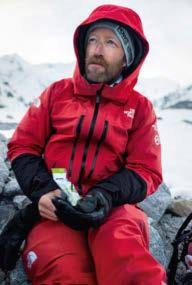
In addition to the invaluable data provided about glacial movements resulting from climate change, the greatest find was Washburn’s Fairchild F-8 aerial camera and two motion-picture cameras, which are now being analysed by experts to determine whether their films can be developed.
But for Post the mission had extra meaning: “Seeing the equipment they were using was so humbling. The fact they were able to climb this peak… When you’re staring history right in the face, it’s awe-inspiring.”
Griffn Post’s team will release a feature flm on their mission later this year. Find out more at griffpost.com
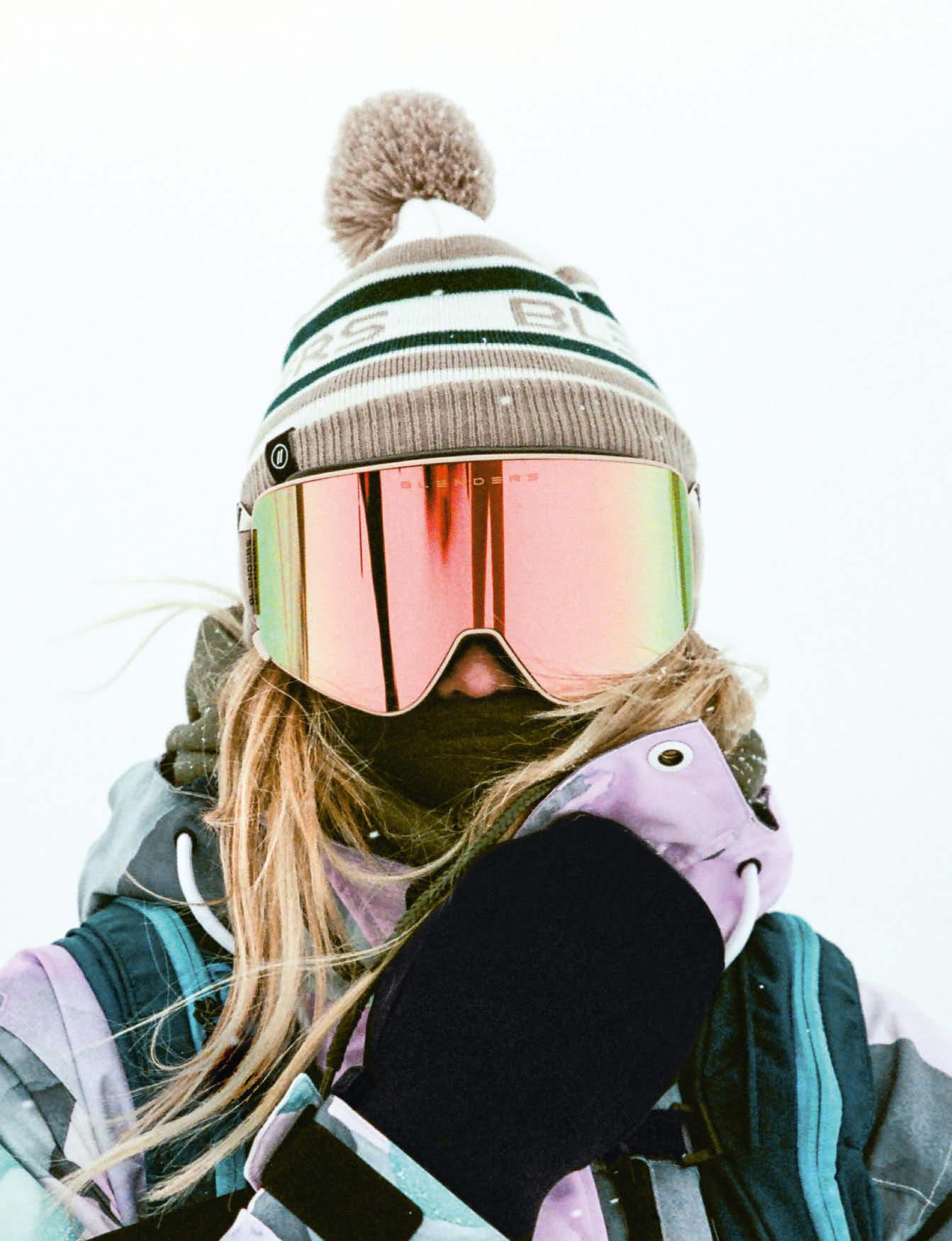
10IRONWOMEN
These female athletes from London are on a mission. Their goal: to end the gender imbalance in the gruelling world of Ironman

The day before Elena Lopez was due to compete in her first-ever Ironman triathlon, in 2019, she got her period. “It was like, ‘Oh God!’” she laughs. “But it happened to one of the other girls, too. We just had to deal with it.” It may not have been ideal timing, but luckily Lopez had a group around her who understood exactly how she felt: the 10IronWomen.
When the 10 running-club friends from London signed up together for that first Ironman, they faced more than just the challenge of one of the world’s toughest triathlons: female competitors were firmly in the minority. “The percentage of women taking part in Ironman was small, around 13 per cent,”
says Lopez (pictured, front row, second from left). “So we created an Instagram account and documented our process to encourage other women.”
The 10IronWomen include professionals with careers in everything from architecture and psychotherapy to finance – Lopez, 33, is co-founder of a property management company – but none had taken on anything like an Ironman: a 3.8km open-water swim, 180km bike ride and 42.2km run. “Some of us didn’t have a bike, and some hadn’t swum in open water,” Lopez says. “I would have struggled without the group, because the training can be daunting. You start doubting yourself.”
Ultimately, nine of the women completed the 2019 Ironman in Barcelona – one of them had to pull out because she was pregnant – and the hard work paid off. “You realise you are capable of so much more than you think, both mentally and physically,” says Lopez. “The experience taught me to be more resilient. When you’re having a dark moment on race day, you remember that it won’t last for ever. That applies to life situations, too.”
Despite their success at the race, the 10IronWomen still felt the gender gap keenly in Barcelona – “It did feel like we were surrounded by men,” says Lopez – and decided to set themselves an even bigger goal: to get the Ironman gender split to 50:50.
In addition to growing their online community, they now offer advice on everything from bike maintenance to race nutrition, and organise regular training events. After taking part in last July’s Cotswolds Classic triathlon – gender split: 40 per cent women, 60 per cent men –the group plan to return to the Barcelona Ironman this year, and in bigger numbers. “It made such a difference to see so many women on the course at the triathlon last summer,” says Lopez. “It would be so good to have an Ironman with that vibe.”
Given the name of the race, perhaps the gender disparity is unsurprising, but Ironman is open to everyone, and Lopez believes the bigger issue is representation. “I don’t think they necessarily need to change the name,” she says. “It’s more about the way they market the race. If you see people who are like you, you can aspire to that. That’s what we are trying to do with 10IronWomen. We weren’t professional athletes; we had to learn these disciplines. And if we can do it, anyone can!”
10ironwomen.com

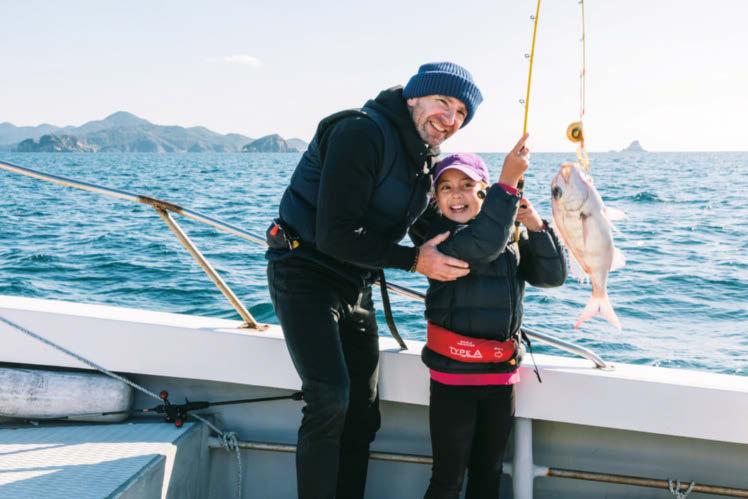

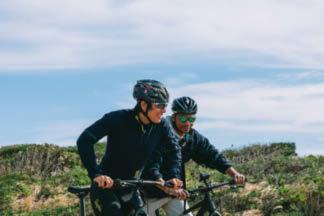




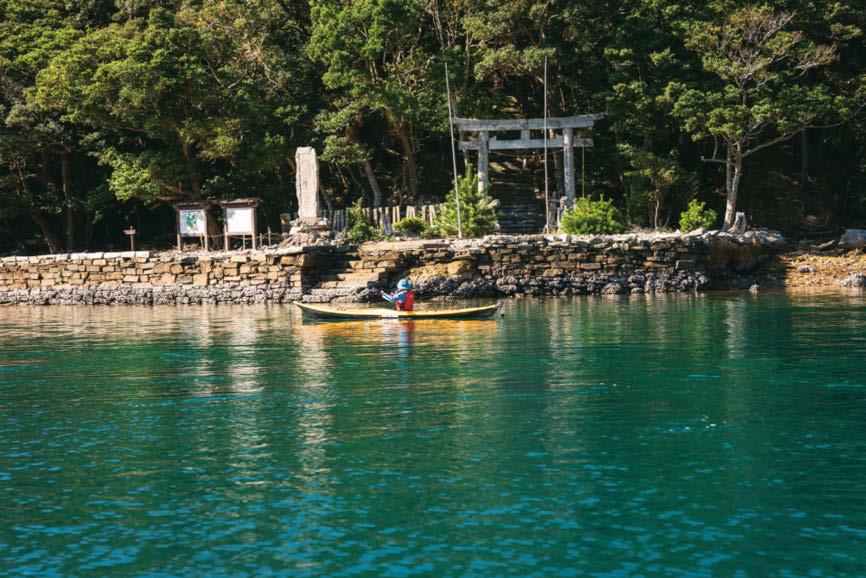

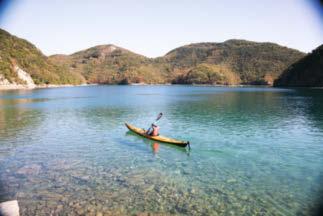

Finding the funny in grief is not only a very natural human response, says the London-born comedian and podcaster, but it’s also a celebration of life
WordsFor many, breaking into a fit of giggles in the immediate aftermath of losing a loved one would be embarrassing, guilt-inducing and/or plain inappropriate. But for comedian Cariad Lloyd it’s a completely natural response.
Over the past six years, Lloyd has had more than 200 conversations about death – and laughed through most – on her award-winning podcast, Griefcast. Although she admits she initially thought the idea of chatting about grief each week was “terrible – who would listen to that?!”, thousands have subscribed to hear her talk to writers, actors, activists and fellow comedians including Ed Byrne, Adam Buxton, Aisling Bea, Robert Webb and Sara Pascoe about the people they’ve loved and lost.
Not only has the podcast given the 40-year-old from north London an opportunity to explore her own experience of grief – Lloyd’s father died of pancreatic cancer when she was 15 – but listeners have been keen to open up, too. “You start very quietly asking, ‘Does anyone else feel like this?’ And you get such a reaction from people saying, ‘Yes! Yes! Yes!’”
Now, Lloyd has written a book, You Are Not Alone, which she describes as “a loose roadmap” to dealing with grief and all the complicated feelings that come along with it... especially that awkward laughter.
the red bulletin: Did you explore death or grief in your stand-up or improv work before Griefcast?
cariad lloyd: Yeah, they came up a lot! But they were very hidden. I did character stand-up when I began,
and I performed an Edinburgh show that was very successful, but I never twigged that all the characters had dad problems – either dead dads or men who wouldn’t come into the room. I had a character called Andrew who was a seven-year-old stand-up whose dad had run away to Dubai because of some financial fraud. And another character, Alison, was a magician’s assistant whose dad was the magician, but he was in the next room and never came on stage. Afterwards, it was like, “Wow, I stood on stage talking about a man who’d gone into another room that I couldn’t go into, and I always said, ‘He’s gonna come back,’ but he never did.” I mean, psychology 101! So it leaked out, but it was always done in character. I never spoke about what happened in the real world until I started the podcast.
How has your comedy background helped you facilitate conversations about death and grief?
It’s twofold. I’m an improviser at heart – that’s the thing I love doing most. Improv is about connection and listening, so I think 10 years of that accidentally trained me in interviewing. It’s all about building conversations and “yes, and”-ing. The other thing that helped was that, being a comedian, I specifically wanted to talk to other comedians. I didn’t want the show to be too depressing. I wanted to be around other people who would crack a joke when it got awkward or sad. Then it would never be too intense. You’re trying to create a balance and remember that everything is going to be alright. My big goal with the show was that you’d listen to it for
an hour and feel better by the end. I didn’t want people to feel worse and more grief-y.
Do you think death and humour are natural bedfellows?
I think they are. Obviously it depends – we all have very different situations and some grief is absolutely tragic. There’s no humour in some losses. But I think grief is an absurd feeling. It’s absurd that you can feel so many emotions at once. It’s absurd that someone can be here and then not be here in a second. It’s a very natural human reaction to laugh at it, because there’s an absurdity to the fact that we exist here and we make this whole world and we live our lives but actually, at any minute, we can stop working. Humour and death go hand in hand. When you laugh, your body takes in loads of oxygen, and I do think there’s a survival aspect to that. Your body is like, “You’re not dead. You’re still here. You’re still alive.” It pulls you back.
What about when we feel guilty or awkward for laughing or finding things funny after the death of another person?
You should be happy about being alive. That’s a brilliant thing. That matters. They don’t get to laugh any more, but you do, and you should feel happy about it. I don’t know a single person who hasn’t had some incident at the funeral or the deathbed or the burial where they’ve absolutely pissed themselves laughing… It’s that thing of laughing at life still existing, things still going wrong, still being late for something. Life is full of these moments, and these things don’t stop happening just because somebody has died. Doctors don’t stop burping just before they tell you someone has died. The cleaner doesn’t stop hoovering right after your parent has died in the room. Life goes on. That’s what the world is telling you: you will laugh again. We feel bad because we think it means we didn’t love that person, but it doesn’t mean that at all.
Cariad Lloyd’s book You Are Not Alone, published by Bloomsbury, is out now; cariadlloyd.com

“You should be happy about being alive. That matters”
After years as a session vocalist, the LA-based singer stunned the jazz world with her raw vocal power on her 2021 debut album. Here, she talks fate, freedom and the shock of success
Words STEPHANIE PHILLIPS Photography CHRISTINE SOLOMONSometimes everything you need to know is in a name. LA-based soul singer Lady Blackbird’s moniker references the jazz-era greats she’s already been compared to – legends such as Billie Holiday and Nina Simone. Listen to her 2021 debut album Black Acid Soul and those comparisons are quickly explained, as, at times, her emotive growl of a voice has the power to render the listener speechless.
Lady Blackbird has paid her music industry dues. Born Marley Munroe to an evangelical Christian family in Farmington, New Mexico, she trudged the circuit for years as a session singer, performing everything from alt-pop to Christian rock. Her big break came after she began working with friend and Grammynominated producer Chris Seefried, recording her vocals a cappella and letting her backing band build the music around her. The first result of this was her interpretation of Nina Simone’s song Blackbird
Despite being recorded a year earlier, its release in 2020 coincided with the immediate aftermath of George Floyd’s murder, bringing a sombre contemporary context to the song about Black womanhood.
As Lady Blackbird readies herself for a new stage in her career, the ‘Grace Jones of jazz’ talks about things finally falling into place…
the red bulletin: What role has music played in your life?
lady blackbird: It is my life, in the truest sense: I believe this is exactly what I was born to do. There’s not a memory I have that doesn’t involve
singing. My happiest moments, when I’m at my most relaxed and I’m my most open and honest self, are on stage, performing. I kind of suck at everything else. [Laughs.] I’ve had a lot of different jobs, but this one’s my true love. It’s not work for me.
Why did you choose the name Lady Blackbird?
It wasn’t part of the plan to go by a different name. We were in the studio listening to Blackbird, which was inspired by Nina’s song [recorded in 1966], and somebody just said it. It just happened. I went, “Hey, Lady Blackbird,” and it stuck. I’ve been doing this for so long, and when you when you want something so bad, sometimes you grip it too tightly and you choke it out. With this, things were unfolding so easily.
Is Black Acid Soul a genre? How would you describe it?
Chris [Seefried] actually coined that one. We’d just started writing, and in so many different genres and styles we were pretty much all over the map. When we posted things, he’d hashtag them ‘#BlackAcidSoul’. So it started as our own kind of subgenre. And when we were looking for album titles, we were like, “Hey!” We thought it was the coolest thing.
It’s been a long slog to get to this place. How does it feel to see such an upturn in your career?
It’s still quite shocking, in the best way. I’ve been doing this for so long: trying to get meetings with labels; having an album complete but never come out; taking cover gigs at hotels to pay the bills; hoping a few people show up, and having my best friends
come out to support me, then being happy if five of them are there… On the road, when we started playing these shows, it was 300 people, then 500 people, 1,200 people, and I’m going, “Oh my God.” It’s an amazing feeling. It blows me away.
A big turning point was the release of Blackbird, which coincided with the emergence of Black Lives Matter. Did all the focus on the single at a time of such heightened feelings bring any pressure?
No, I won’t say I felt any pressure. The album was finished and we were starting to play around town, and then COVID happened. We were holding on to it, going, “What do we do?” The fact that [Blackbird] was released at that time was completely unintentional. For me, it was just finally being able to release something we’d worked so hard to put together, and choose the perfect tunes that I could really sink my teeth into. It felt so nice to finally be able to do that, despite what all the circumstances were. To have released that album, and for people to have caught onto it and supported it through such a time, that’s really important to me.
Is it important to you that your music reflects your identity as a queer woman of colour?
You hear a little bit, like the message in Woman, which is on the Deluxe Edition of Black Acid Soul, or a song like Beware the Stranger. The original song [recorded by all-female vocal group Krystal Generation in 1971] was titled Wanted Dead or Alive, and we flipped the gender [in the lyrics]. It’s the little things here and there. They’re never forced or pushed. It’s just honest in that this is who I am, and if that comes out, it comes out.
What do you hope your music can do for people?
I want them to feel a sense of freedom – the freedom I experienced making it. And then I just want them to be entertained. To come exactly as you are… freedom in every sense of the word.
ladyblackbird.com
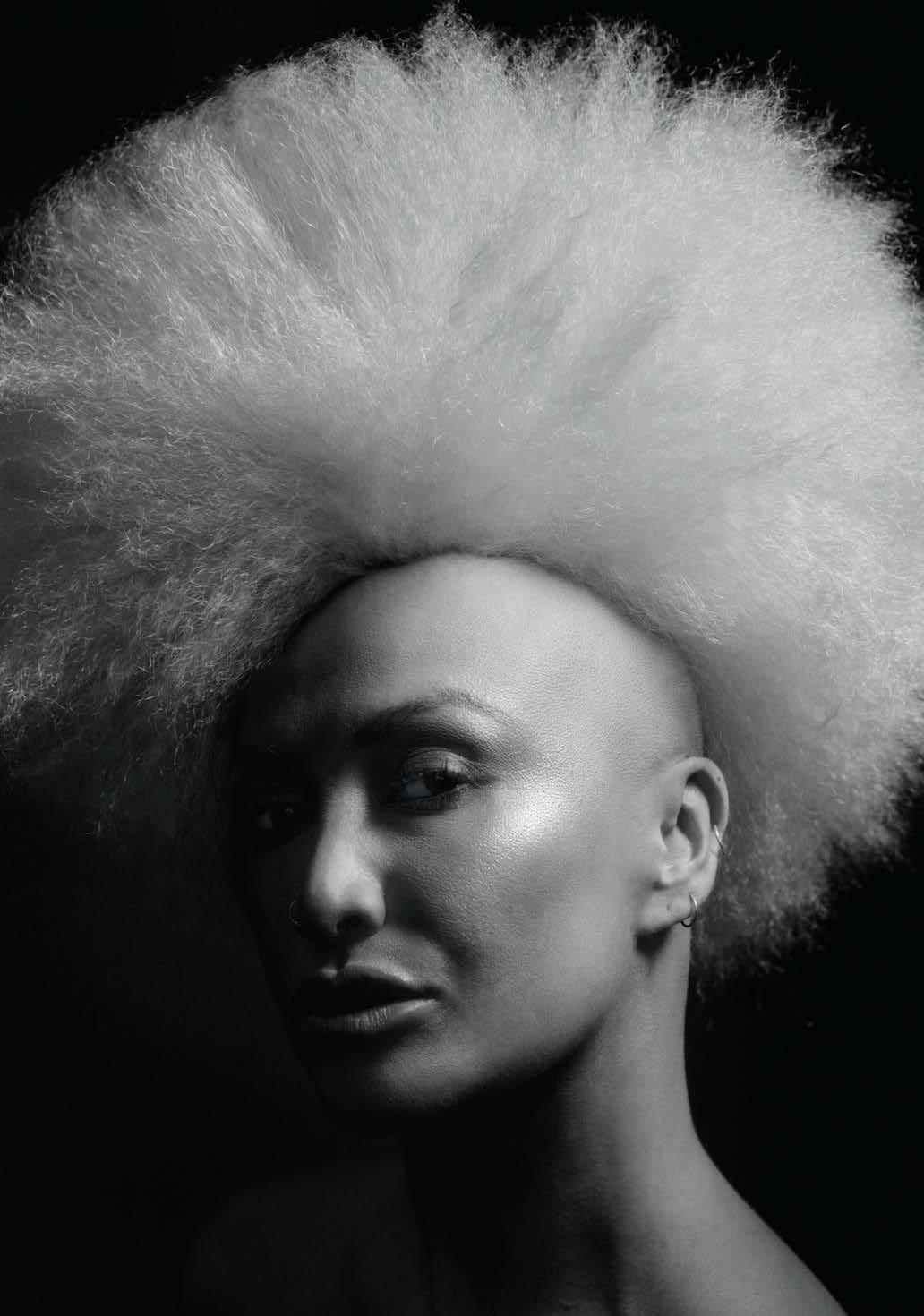
“I believe that this is exactly what I was born to do”
That’s when I get the most nervous or have the most self-doubt. The best thing I’ve done in the past few years is start playing golf. I haven’t had a hobby in a long time, because I was so focused on pole vaulting. I needed to find a way to clear my head for a few hours or maybe a whole day.
How does your mental strength benefit your life outside sport?
At 23, Armand ‘Mondo’ Duplantis is at the top of his game. Last July, the American-born Swede broke his own world record in the pole vault at the World Athletics Championships in Eugene, Oregon, adding that hardware to his gold medal from the Tokyo Olympics. In this conversation with sports psychologist Mia Stellberg for Mind Set Win, a new podcast on the mental tactics behind sporting success, Duplantis discusses his approach – and how it can apply beyond the world of sport.
the red bulletin: You recently broke your own world record. Can you take us back to that moment? mondo duplantis: It’s hard to explain, because it all happens so quickly – it takes a little while to comprehend what’s just happened. It’s easier to reflect on later, because in the moment everything is just so crazy and euphoric. There are these few moments in my career that I’ve had thus far – the world record, Olympic gold – where things don’t necessarily feel real. You’re on such an adrenaline high, it’s almost like you’re having this out-of-body experience.
What is your optimal headspace prior to one of these world recordbreaking performances?
It’s important to understand the things you can’t control and just go out there and do whatever you can do under whatever circumstances the day gives you. I know it’s not every day I’ll break the world record.
I might not even win every day, but I’m going to make sure to leave everything out there on the track.
Is there anything you want to improve on the mental side? When I was younger, I was a poor loser. That was good in some ways – I was never satisfied, and if I lost, that was just unacceptable. I was really motivated, but I think I didn’t handle it like a pro in a healthy way. I can now cope a lot better with losing. I understand more now that there are other things in life that matter. I couldn’t really understand that two years ago; I felt like pole vault is the only thing that matters. Now, if I have a bad practice, I’m going to be bummed about it, but I can set myself to the side for a bit. And I’m able to be a decent friend or boyfriend nowadays. But there are things to work on – I think I still dwell on things a little too much.
That sounds like resilience – how to bounce back from certain disappointments. And improving your resilience impacts your dynamic with your discipline… It’s a fine balance, because you must have both. You’re not going to find people who are great losers who also have the resilience. But I try to balance it out.
How do you cope with all the expectations that people have of you? What would be your advice for people struggling with that? It’s still a work in progress, but I trust my own abilities when I’m out on the track. It’s more a problem when I’m at home and I have time to think about everything in my head.
I think sport teaches you a lot of good lessons. It teaches you how important preparation is. So, no matter whether it’s school or a meeting or anything, just prepare for it. There are certain situations where winging it is good, when you don’t overthink and let things flow naturally. But there is this balance you have to find where you must prepare for things and train your body and mind to do the things you want it to do. And when that happens, you let it all flow out.
How would you suggest others go about building mental strength?
I think it’s really important to set goals. It sounds simple, but people just don’t do it. You don’t have to have these goals where you’re the best in the world at something, or be famous. But if you’re going to do something and you want to do it at a high level, or the highest level you can do it, then you have to know what you want to do and set goals. They could be little goals, little check marks to make sure you’re in the places you want to be. But I think it’s very important that before you do something you need to know what you want to get out of it.
redbull.com/MindSetWin
Words NORA O’DONNELL
The Swedish-American pole vaulter has the physical prowess to break world records, but the secrets to his success are more mindful
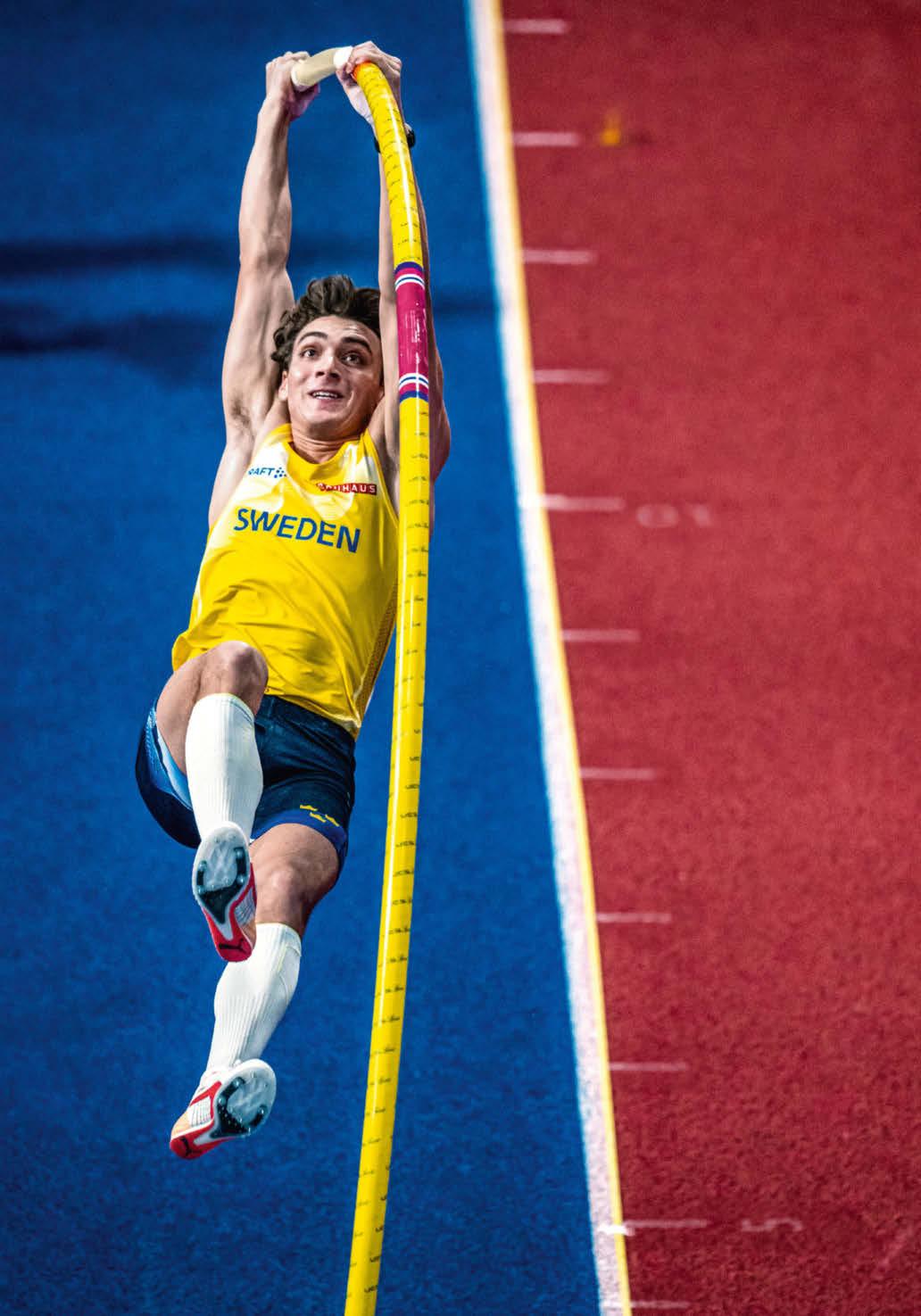
“I make sure to leave everything out there on the track”
After a stellar year of success, genre-blending British duo NOVA TWINS are rewriting the rules of alternative music and revitalising rock. We head backstage at the band’s homecoming gig to talk respect, representation and gnarly bass riffs
Words LOU BOYD Photography STEPHANIE SIAN SMITH

n an unseasonably sunny Saturday in November, the queue of people outside south London music venue Electric Brixton is rapidly growing. They’re here to see Nova Twins, aka Amy Love and Georgia South, one of the most electrifying live acts on the UK music scene, and the diversity of ages, genders and sartorial looks in the 1,500-strong line reflects the duo’s inclusive, genre-busting appeal. With a sound that spans punk, rap, pop, rock, metal, R&B and more, Nova Twins have been likened to everyone from Rage Against the Machine to Cypress Hill and Missy Elliot during their stratospheric rise in popularity over the past two years. If the broad spectrum of artists they’ve been invited to support in the past 12 months – from stadium fillers like Bring Me the Horizon and Prophets of Rage to Yungblud, Enter Shikari, Skunk Anansie and Sleaford Mods – is any indication, no corner of the alternative music scene is immune to the band’s charms.
And they have dedicated fans. The expanding queue outside Electric Brixton snakes all the way down the main road and up a nearby side street. The doors don’t open until 7pm, but some fans have been camped out here since midday, chatting, eating sandwiches and drinking from cans of cider. Amy Sober, at the head
of the queue, travelled down early in the hope of meeting the band and asking them to write some lyrics on her arm, which she’d then have tattooed. “I want the line ‘From Persia to Nigeria, London to Jamaica, our ancestors were sailors, crossed over the equator,’” she says. “Cleopatra is such an important song for me.”
Around the back of the venue, Nova Twins are disembarking from a taxi to prep for their sold-out gig. They’ve had a busy few months. “What a crazy time,” lead singer and guitarist Love exclaims, laughing and theatrically slumping on bandmate South’s shoulder. “We’re a bit overwhelmed.” This will be their third show in as many nights; the pair have travelled up and down the UK over the past 48 hours, playing shows in Glasgow and Manchester before driving to London in the early hours. But as they greet today’s team, neither reveals any sign of weariness. Their faces immaculately painted in statement Nova Twins makeup, the pair are dressed in heavy black boots, handmade tartan and animalprint miniskirts, and blazers. They jump out of the car and excitedly greet everyone with smiles and hugs, making sure they remember everyone’s names. Then bassist South wraps a huge zebraprint faux-fur coat around her shoulders and the duo stride into the venue together.
In person, Nova Twins are chaotic and hyperactive, their personalities perfectly mirroring the playfulness of their personal style. Love, the elder of the two, is poised and charming, while South is sweet and animated, bouncing between people with an infectious enthusiasm. Among the organised chaos of gig prep, they frequently huddle up to chat, whispering jokes and making each other laugh. It’s the kind of easy bond that comes from having spent years together.
The pair met as teenagers, through South’s brother, and felt a connection straight away; their origin story is more akin to a romcom than a music profile.
“I was introduced to Georgia’s family and we just got on like a house on fire,” says Love. “I went to her house one day and we clicked immediately.”
“You got snowed in!” South interjects, beaming broadly.

“Yes,” Love continues, “and we thought the trains might have stopped running, so I stayed the night and basically never left.”
On that first meeting, South and Love bonded over a shared love of music. Love had been writing and performing as a
“People would tell us all the time, ‘You should be a band’”
Amy Love
 Written in the stars: Georgia South (left) and Amy Love first met when they were teenagers, introduced by South’s brother
Written in the stars: Georgia South (left) and Amy Love first met when they were teenagers, introduced by South’s brother

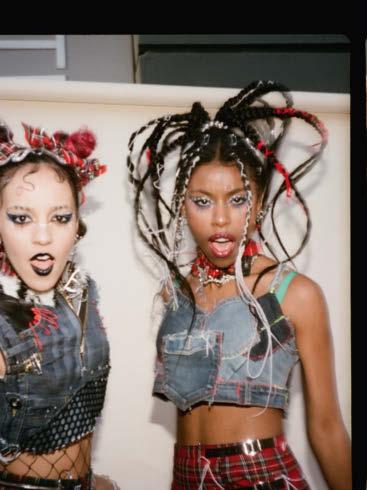
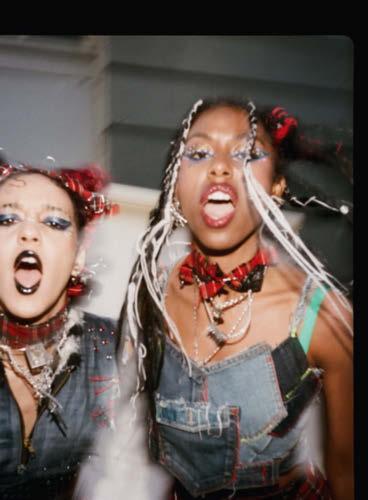


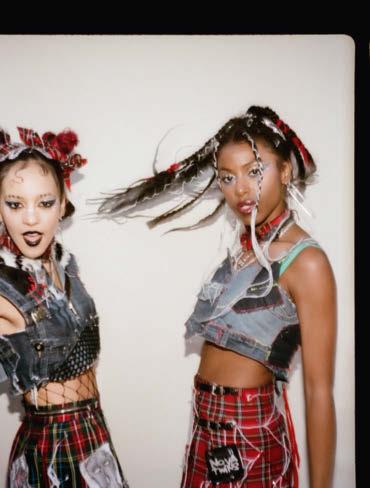
Fits for purpose: (right) bassist South on stage at Electric Brixton, wearing one of the eye-catching stage outfits the duo designed and made themselves; (opposite) Nova Twins’ individual and distinctive sense of style is integral to their appeal, and they now have their own fashion label, Bad Stitches
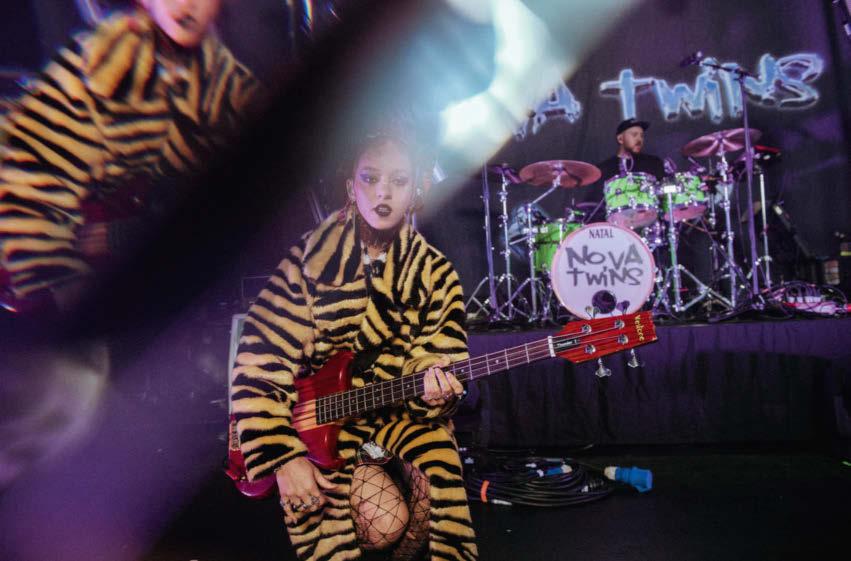
solo artist and was drawn to South and her musical household. “Everyone in Georgia’s family is musical,” says Love as they both laugh. “It’s true! Your mum, dad and your brothers are all musicians! You were all always playing music in the house – it was great.” They didn’t think to form a band of their own, however; Love had a solo project on the go, and South was already in a local band. “But we always had this kind of connection and affinity, and we’d gravitate towards each other anyway,” says Love. “People would tell us all the time, ‘You should be a band,’ and we’d awkwardly say, ‘We’re in other bands already.’ But, of course, all those people were right. It was obvious to everyone but us, and soon we decided we were going to be a thing.”
They officially became a duo in 2014 and hit the ground running. Sewing their own outlandish stage outfits from scratch and filming DIY music videos on phone cameras with the help of South’s mum, the teenagers soon became known fixtures of the southeast London openmic scene, playing at well-known live music spots such as The Fox & Firkin and the (now sadly closed) Ravensbourne Arms in Lewisham. After independently
releasing their first song, Bassline Bitch, online in 2015, Nova Twins caught the attention of indie label Robotunes and were soon signed. In August the next year, they released their debut, self-titled EP.
“Our sound was there from the start,” says South. “When we wrote our first song, it was just my distorted bass with Amy’s punky vocals. We had those elements straight away and knew it was fresh and interesting, like nothing we’d stumbled across before. That made us excited to push on. We really didn’t go out for two years; we were in our own bubble together, writing, rehearsing, just getting really into it.”
Fast forward to 2020 and the culmination of that hard work: the band’s blistering debut album, Who Are the Girls?, which was released on Spotify that February, just weeks before the world
went into lockdown. This could have spelled disaster, but instead the record became one of the success stories of the pandemic. Though unable to tour, the pair’s high-octane songs, with their empowering lyrics and heavy riffs, captured the imagination of music lovers worldwide. Along with a new-found audience of passionate fans came messages from industry greats including Elton John, who invited them onto his Apple Music podcast – “We were like, ‘Fuuuuck!’ There he was, just sat on FaceTime, a legend in a Gucci tracksuit,” South laughs – and rock legend Tom Morello, who proclaimed that Nova Twins were the “best band you’ve never heard of”.
Following the breakout success of Who Are the Girls?, the band got to work on a follow-up, Supernova, set for release in 2022. “We were pretty nervous,” admits Love. “Because of the pandemic, Supernova didn’t really feel like a second record… more like a second first record.” They needn’t have fretted: the album lived up to its name, launching the duo to another level. Universally acclaimed by critics, the album earned Nova Twins a plethora of
“Often, we’d be the only POC band on a festival line-up”
Georgia South

”I daydreamed about touring these songs. Of course I’m jumping around!”
Georgia South
 Fired up: Nova Twins get the crowd moshing at Electric Brixton on the final 2022 date of their Supernova tour. Note the giant lights spelling out ‘NOVA’ behind the duo
Fired up: Nova Twins get the crowd moshing at Electric Brixton on the final 2022 date of their Supernova tour. Note the giant lights spelling out ‘NOVA’ behind the duo
nominations for awards such as the Mercury Prize and NME’s Best Band from the UK and Best Band in the World, with wins including Kerrang!’s Best British Breakthrough and Music Week’s Women in Music 2022 New Artist Award.
Supernova is a punchy body of work with tight hooks and expertly crafted lyrics squeezed into neat three-minute tracks. Written during the pandemic and at the height of the Black Lives Matter movement, it’s straight-talking in its message about Nova Twins’ struggles as women of colour in the music industry (Love is of Iranian and Nigerian descent; South’s ancestry is Jamaican and Australian). “Coming up in the rock genre, we didn’t see many faces like ours,” says South. “Often, we’d be the only POC [people of colour] band on a festival line-up. People would tell us we’d be more successful if we became more pop, or less heavy and alternative.”
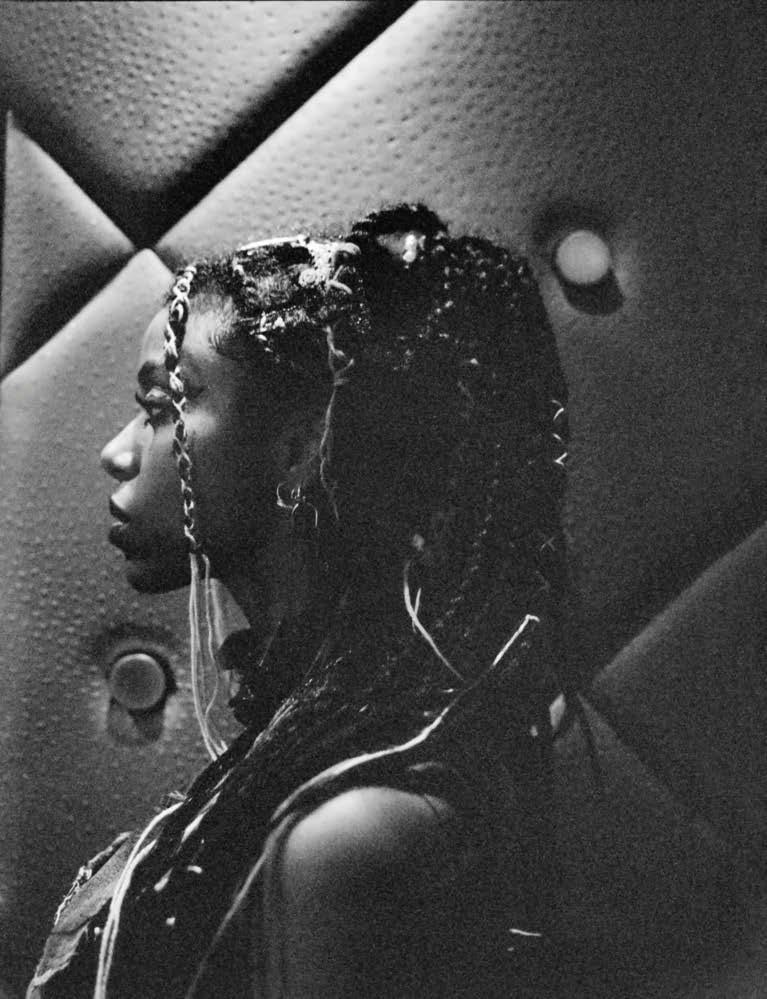
Supernova flips a middle finger at such comments: “Look me in the face –say you’ve never met someone like me,” challenges the opener, Antagonist. Second track Cleopatra joyfully celebrates the band’s mixed-race identity: “You can buy your looks, but you can’t change your genes, I’m a straight talker, fucking say what you mean,” Love sings. “Blacker than the leather, that’s holding our boots together, if you rock a different shade, we come under the same umbrella.” The latter track was written in response to the negativity surrounding Black identity during those months, and a desire for more public pride and positivity. “We wanted that song to celebrate who we are, and to be a statement of pride of where we come from,” says South. “We hope it encourages people from all walks of life to act and feel the same way, too.”
During the pandemic, while looking for more ways to respond to the events they were seeing unfold in the US, Nova Twins launched Voices for the Unheard, a playlist of alternative artists of colour, on their Spotify artist profile. “It’s a way to highlight POC creators and say to our audience, ‘These are artists you should be listening to – they’re amazing,’” says South. The playlist then became an interview series on social media, hosted by the band. “Those interviews were about letting musicians tell their story and their journey,” South says. “It was interesting that they could be from America or the
UK, but everyone’s stories of how they felt coming up were very similar.” She and Love spoke to musicians including Skunk Anansie vocalist Skin, Noisettes frontwoman turned solo star Shingai Shoniwa, singer-songwriter Connie Constance and Liverpool-based metal
band Loathe about their experiences of being artists of colour in the music industry. “There were all these shared experiences,” says South. “Stories [about situations] like not being booked at a festival because they’d already picked one POC band. Stories of being told, ‘Oh, you’re not indie, because you look like this,’ or, ‘You’re not rock, because you have a massive ’fro.’ Just so many similar stories of not being understood.” The series pushed Nova Twins to take matters into their own hands and, at the end of 2020, they wrote an open letter to
“There was always a kind of affinity”
the organisers of the MOBOs – an awards event that celebrates music of Black origin – calling for the addition of an alternative/ rock category. “We are Nova Twins, a band of two mixed-race girls from southeast London and Essex who shout through distorted mics and play gnarly bass riffs,” they wrote. “We want to use our platform to raise the voices of the unheard, diversifying the space for alternative POC bands, but we can’t do it alone. We need trailblazing, influential platforms like [the MOBOs] to back us and look ahead to a more diverse future for music.”
It was a powerful statement, and one than didn’t go unnoticed; they soon received an invitation to a meeting with MOBOs founder Kanya King, and in 2022 an ‘alternative’ category was created – with the Novas among the first nominees, of course.
“That started because someone joked, ‘Have you ever been up for a MOBO yet?’ and we all laughed like it was this ridiculous idea,” says Love. “But then we stopped and thought, ‘Why not?’ The reason why we really struggled as a band in rock music to begin with was because people didn’t acknowledge where rock comes from. It’s rhythm and blues! It’s inspired by Black music!” This is a point made in their MOBOs letter: “People often don’t know that rock’n’roll was in fact largely originated by a Black woman,” they wrote. “Starting her career in the 1930s, Sister Rosetta Tharpe went on to inspire household names through the decades. You can see and hear her influence in the works of Little Richard, Chuck Berry, Elvis Presley, Tina Turner and Jimi Hendrix… Her guitar-playing technique also had a major influence on the development of British blues in the 1960s. We all owe her a huge debt…”
The new MOBO category is a victory for the representation of POC women from rock’s past and present, the band point out, but more importantly it paves the way for artists of the future. “This will open up doors for young POC artists who might want to explore different genres,” says Love. “It’s so good to see younger POC alternative bands really excited about the category,” agrees South. “It’s like finally we’re included, and people are so excited for the future.”

And as The Red Bulletin went to press, it was announced that Nova Twins had been nominated in two categories at this year’s BRIT Awards: Group of the Year and Best Rock/Alternative Act.
Tonight’s London show marks the end of the Supernova UK tour for 2022 (it finishes proper in Brighton on March 4, 2023) and is a bit of a homecoming for the band, who started out performing in pubs just down the road. Nova Twins’ family and friends will be in attendance at Electric Brixton – not only the biggest venue on their tour but, amazingly, the 90th gig they’ve played in an epic year. South is buzzing around the venue with nervous energy as they prepare to sound check, and Love is already feeling emotional about the end of this chapter. “Sometimes it’s hard to take things in when you’re always on the go. But I definitely think in this moment, especially after the gig is finished, we’ll take it in,” she says. “We’ve been a band for a while now and
“We had our sound from the start” Georgia South
we’ve worked so hard to get to this point. It’s amazing seeing how the work we’ve put in is now paying off.”
Witnessing Nova Twins backstage at Electric Brixton, it’s evident how much control they have of every element of their image and production. Barely five minutes after arriving, both are deep into the technicalities of tonight’s show. South is talking to the stage crew about the placement of the pyrotechnics and lights, while Love discusses outfit choices with The Red Bulletin’s photographer. The duo, who have always created their own matching stage outfits, now have a fashion label, Bad Stitches, so choosing the right look is of the utmost importance. “We’re DIY at heart,” Love says. “We’re still an independent band, signed to an independent label. So when it comes to the lights or sound, we’re going to be all over every single part of it, because only we know how it should sound and look.”
Seven hours after South and Love’s arrival at Electric Brixton, the front doors open and concertgoers fill the main arena and balconies. The diversity of the audience sets this night apart from your typical rock show. There are fathers

with their sons, teenage girl gangs hanging off the railings at the front, some people attending on their own, couples wrapped around each other by the bar… and all are fizzing with excitement. By the time the lights dim, the whole room is roaring. Four giant standing lights at the back of the stage flash in sequence – N-O-V-A – and a wall of fire shoots into the air as South and Love bounce on stage and rip into their first song. The crowd instantly parts to create the first mosh pit of the night. By the second track, both women have jumped off stage and are playing in the pit alongside them. “Everyone gets in the pit at our shows,” says Love. “It’s lovely to see women, non-binary people, a mixture of older men and women, as well as younger ones. We always keep an eye out for everyone’s safety, but if you know our band, you know what we stand
Afterglow: exhausted hugs for Love and South at the end of an unforgettable gig in front of 1,500 ecstatic Nova Twins fans, including friends and family
for: respect, no matter where people are from, what they look like, or what their gender is. Everyone deserves respect.”
The duo play a pitch-perfect show, Love’s powerful vocals offset by her cocky frontwoman presence and South’s energy unfaltering as she launches herself around the stage for the entire set. “When we were writing in lockdown, we’d always imagine how it would feel to be in front of a crowd,” South says. “In my bedroom I’d think, ‘This will be the drop in this song,’ and I’d daydream about touring it!” So of course I’m jumping around! That’s now my reality. It’s the biggest release.”
As the duo command the stage in front of an adoring, sell-out crowd, it’s clear they’ve arrived. And, in an industry still littered with obstacles, South and Love believe they have what it takes to carve out their own place in the world of music. “We’re so lucky to have found each other,” says South after the gig, looking over at Love. “We’re determined, we motivate each other, and we don’t complain. We’re so lucky to be in this duo, to trust and respect each other’s ideas. I know that whatever we come up against, we’ll team together. We’re going to fucking do it.” novatwins.co.uk
”If you know our band, you know we stand for respect“ Amy Love

Pro snowboarder Ben Ferguson nails the biggest challenge of his career so far with FLEETING TIME , one of the most talked-about snowboarding films in years
Words TOM MONTEROSSO Photography AARON BLATT
Rise and shine: American Olympian Hailey Langland, shot here in Lake Tahoe, California, has one of the most memorable trick sequences in Fleeting Time

Pro snowboarder Ben Ferguson’s directorial debut, Fleeting Time, opens with a montage of his two-year journey to create a snowboard production for the ages. A grandfather clock stands nestled below a valley of looming peaks caked in powder, glacial crevasses diving down into the depths of the abyss. A surgeon inserts an arthroscope into a knee, cleaning out cartilage and debris from years of abuse in pursuit of podiums and glory. The clock tick-tocks ominously. In crash after crash, snowboarders slam into the ground, their limbs flailing. A rider detonates a plume of powder, exiting at terminal velocity. An avalanche releases, carrying a rider off a cliff in a waterfall of snow. “Oh my God,” says an anonymous voice over the walkie-talkie. A guitar riff cuts the tension as the action starts. Snowboarders fly through the mountains, moving at lightning speed, sending off massive drops, pinning down near-vertical spines, stomping gigantic tricks and riding out into the valley below as helicopters circle overhead to bring them right back to the top. Then the clock is set ablaze, sending orange flames up into a grey afternoon sky. It’s a visual representation of how
time is short and inescapable, and also a nod to the climate crisis – an existential emergency that requires global action before time runs out.
“At its simplest form, the clock’s always ticking,” says Ferguson of the film’s title. “Time is fleeting. We had two years. You use it wisely. If you use it poorly, you waste a bunch of time – and money. And then, [on a] darker note, you think about the environmental crisis we’re going through. I’m not sure how much longer we’re going to be able to do the things I’ve been lucky enough to do, so take advantage of those times.”
To date, the 27-year-old American athlete has certainly made the most of his time on a board. He came up as a snowboarding prodigy, skyrocketing his way into the elite junior competitive ranks. During Ferguson’s formative years, that was the formula for success: regional contest wins would lead to national recognition, which could ultimately – if the talent was there – culminate in global superstardom. But his calling has always been in the mountains.
Ferguson grew up in Bend, Oregon, in the Pacific Northwest, riding Mount Bachelor, a veritable playground of natural terrain littered with wind lips, side hits and perfect slopes for riding powder. Though the competitive route brought him international acclaim, Ferguson
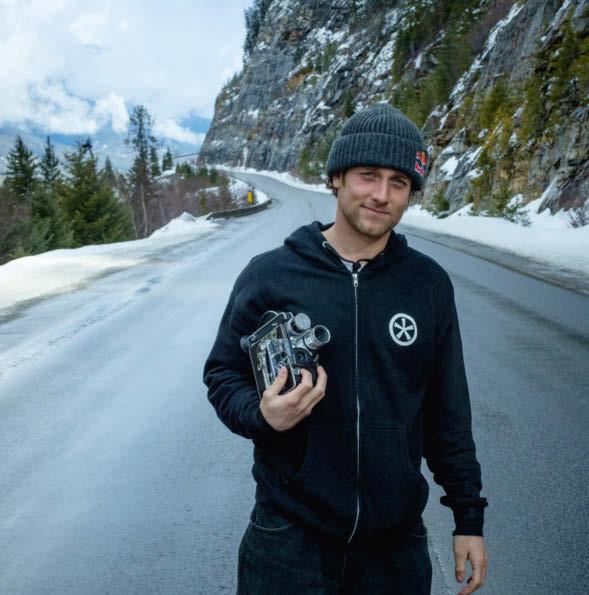
“I wanted to make a movie that gets people excited to go and snowboard”
 Moving mountains: Ferguson and his crew shot in locations across the world – including this spot in Jackson, Wyoming – over a space of two years; (opposite) the director of Fleeting Time in British Columbia
Moving mountains: Ferguson and his crew shot in locations across the world – including this spot in Jackson, Wyoming – over a space of two years; (opposite) the director of Fleeting Time in British Columbia
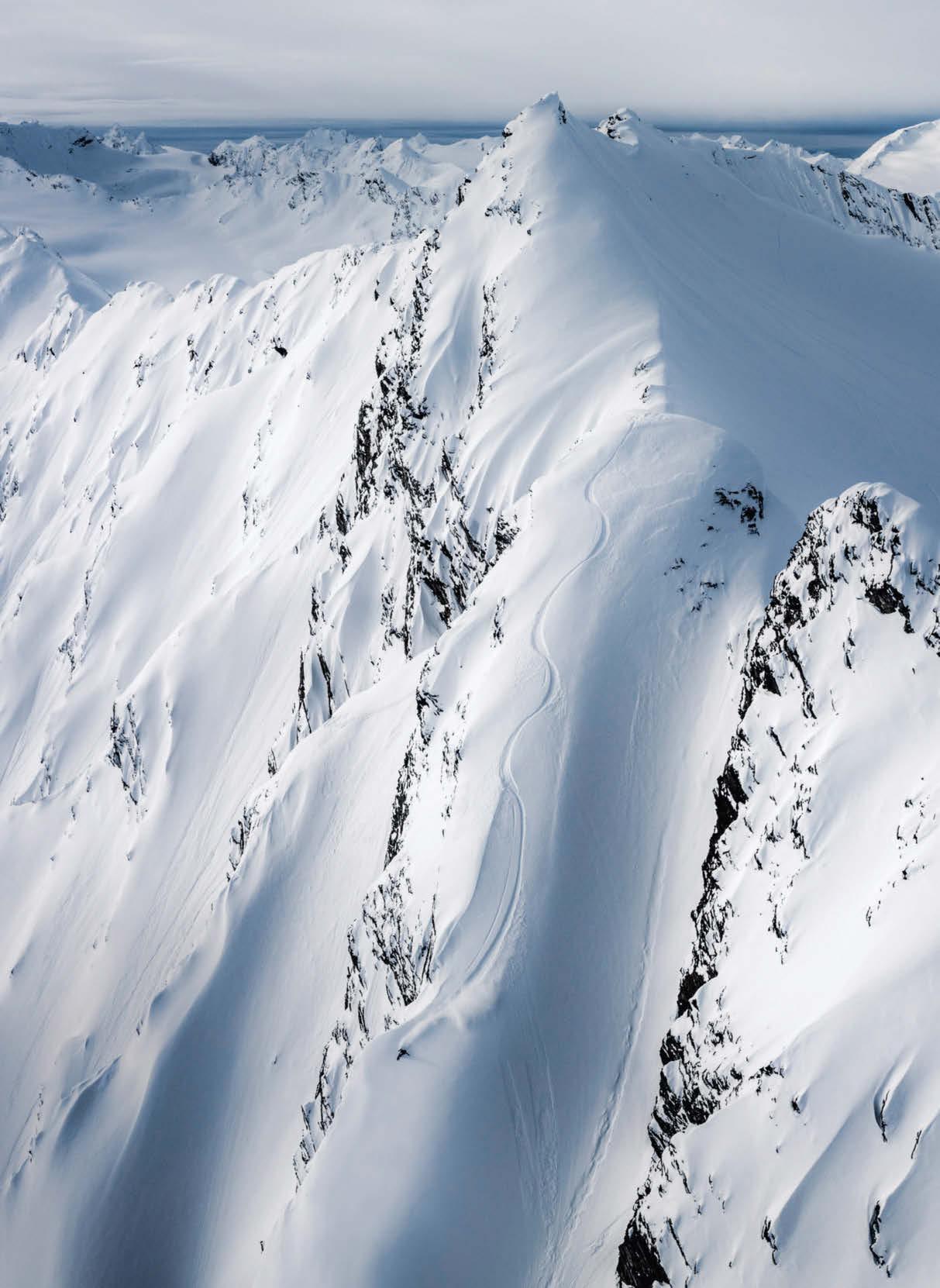
”When you have T Rice out, you’re going to look to him for what he thinks you should do”
All on board: (right) the pro riders catch a chopper to the next filming location; (opposite) after two years of filming, the crew ended their adventure on the near-vertical 1,200m runs of Valdez, Alaska
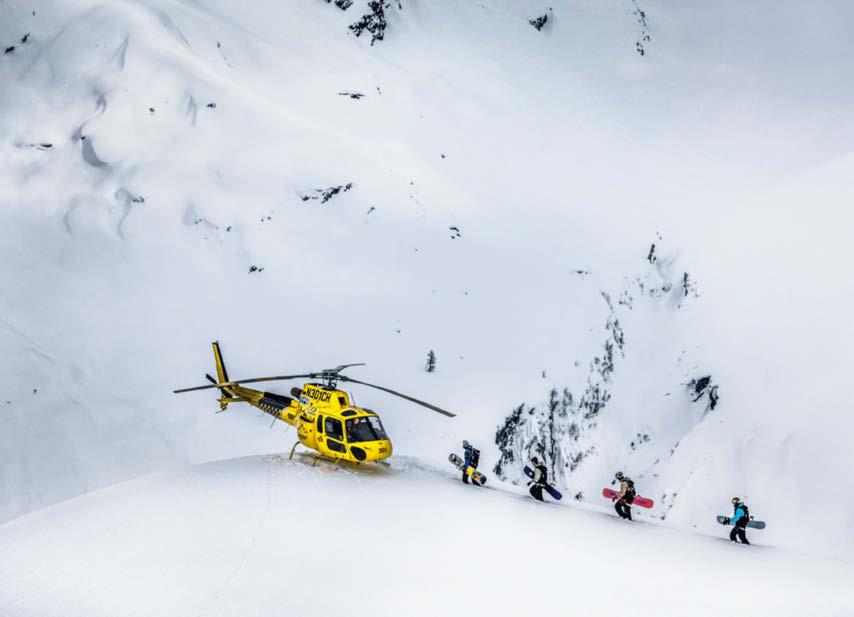
walked away from it after placing fourth at the 2018 Winter Olympics. It wasn’t that he didn’t like contests; he wanted to evolve. His true passion was calling him from outside the ropeline – the fleeting nature of time was already on his mind.
“That was the next step [for me], figuring out how to be a backcountry snowboarder and how to film video parts,” Ferguson says. “If I continued doing halfpipe contests, that would’ve just limited the time that [I had] available to deepen my craft, to take that next step. If I did two more years of contest riding, that’s two more years that I didn’t use to figure out what zones to go to, or how to snowmobile.”
In episode one of About Time, a Red Bull TV series about the making of the film, Travis Rice – one of his childhood idols and the most influential backcountry snowboarder alive –recalls his invitation to a then 19-year-old Ferguson to come out to Jackson, Wyoming, and join the shoot for his own snowboarding epic, The Fourth Phase (2016): “I remember calling him up and he was just going into X Games. I was like, ‘Dude, do X and then get your ass to Jackson asap, right after the contest.’” Ferguson drove through the night to film with Rice and learn from the master, but the younger rider quickly impressed the crew. “I remember Ben dropping
in and cracking a beautiful method,” Rice says, “and that kind of set the precedent for the next three weeks. That month was the first time we got to spend ample time in the backcountry together, and he showed up. Some of the clips he got are still completely A-plus-worthy.”
In 2019, Ferguson partnered up with long-time friends and fellow pro riders Sage Kotsenburg and Red Gerard to make Joy, a film following the trio’s exploits throughout the winter. On the film’s release, Ferguson was heralded as the next big thing in backcountry riding and was moving quickly toward the pinnacle of his second career in professional snowboarding. With the success of Joy came another opportunity for Ferguson to film, this time with directorial duties and the chance to be the project’s anchor. Fleeting Time was an ambitious project with multiple locations around the world and a schedule to shoot over
Fleeting Time was an ambitious project with many locations around the world
two consecutive winters. “It’s a big project,” Ferguson says. “There was a lot of pressure to perform, to make this thing good from the get-go.”
The pressure mounted during the first year of filming, when Ferguson injured his knee while riding in Jackson Hole. Professionals know that injuries are an unfortunate part of the job, but, rather than feel dejected, Ferguson felt driven to overcome this obstacle and finish his film. After going under the knife during the summer, he emerged on the other side ready to film for the second year. In the end, the injury was just a minor setback on a long and arduous journey.
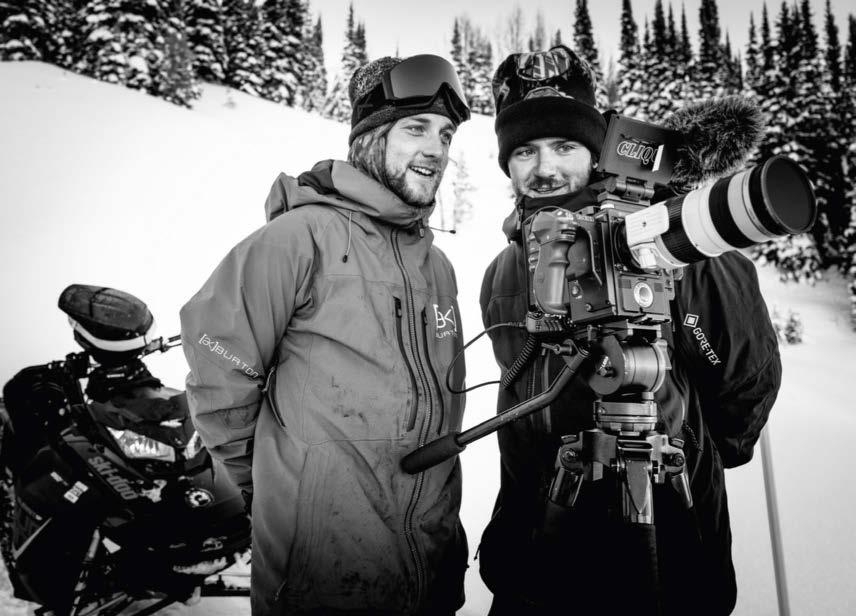
“I was willing to put the work in, and that’s all I focused on,” Ferguson says. “But it was nerveracking. I knew that I had this two-year project [I was] in the middle of, and I had to continue to bust ass for the next year. It really [drove] me into getting healthy and getting ready for the winter.”
The crew is vital to the success of any filming project, and part of Ferguson’s progression from being a featured rider in a film to directing his own was hand-selecting a roster of athletes who he trusted in a backcountry setting. The cast of Fleeting Time includes X Games and Olympic medallists as well as backcountry royalty, an intermingling of specialisms that reflects Ferguson’s time spent in both worlds. Film icons such as Austin Smith, Mikkel Bang and Travis Rice are teamed with competitive superstars including Red Gerard, Mark McMorris and Hailey Langland – a full spectrum of riders. “It all just naturally happened,” Ferguson says of assembling his talented crew. “Nothing felt forced. It just fell into place, and everybody got along really well.”
Langland emerges as one of the stars of the film. Fresh off a flight from the Beijing Games in February 2022, the two-time Olympian and X Games gold medallist powered up to British Columbia to join the crew in Whistler and found herself standing atop a massive jump on a bluebird day in the high alpine of the Coast Mountains. What happened next is one of the most talkedabout tricks of the last few winters – and a standout clip in Fleeting Time
“It was just a surreal feeling,” says the 22-yearold Californian of that moment. “I was so nervous,
Freeze frame: Ferguson (left) with assistant editor Malachi Gerard; (opposite) “Nothing felt forced. It just fell into place, and everybody got along really well,” says Ferguson, shot here near Lake Tahoe
”The clock’s ticking. Time is fleeting. We had two years. You use it wisely“

“There was a lot of pressure to perform, to make this thing good from the get-go”
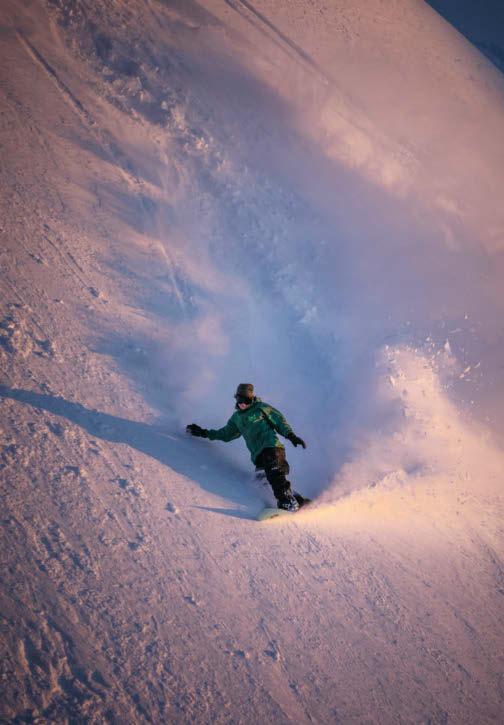
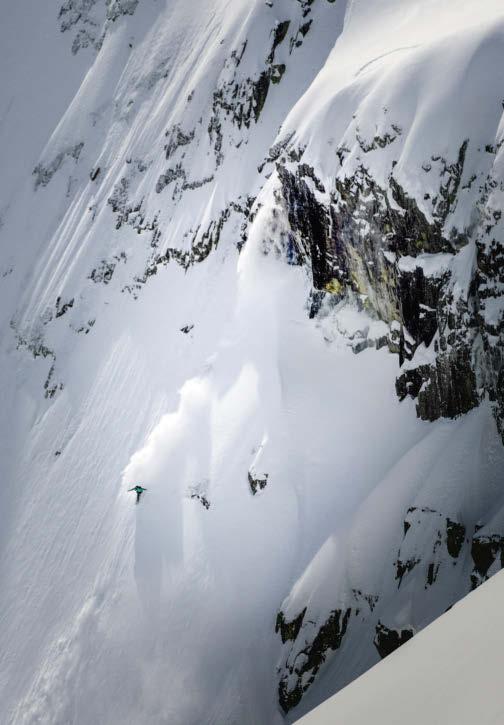
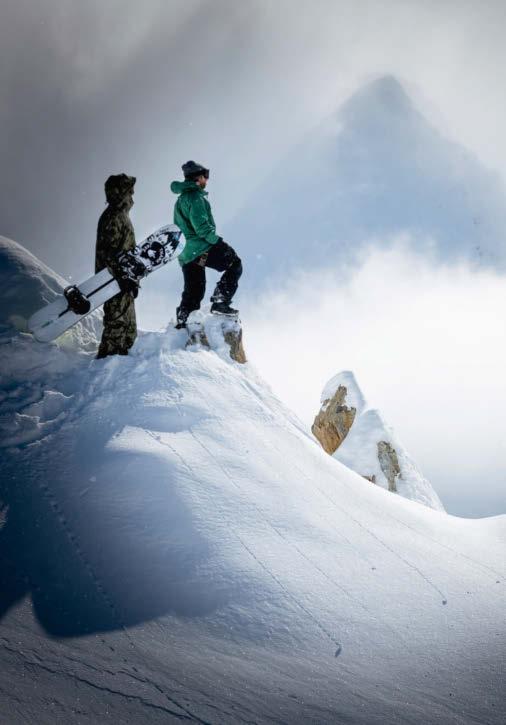

but as soon as I took off and I grabbed my board, I was like, ‘I’m going to land this.’ It took everything in me to stand it up and ride away, and I could hear everyone cheering. Now, being able to sit back and reminisce on that moment, I’m superproud of myself, and so thankful for the group I was with. They were so hyped for me, and they all came down and gave me big hugs. It was one of the best things I’ve ever done on my snowboard.”
Langland’s memorable trick sequence became “the front seven heard ’round the world” and landed her on the cover of US snowboard magazine Slush. “Hailey is such an amazing rider,” Ferguson says. “I think she’s on her way to being a badass in the mountains. She’s getting better at snowmobiling, too, and looking at terrain. It’s just her time.”
After two years filming in Idaho, Wyoming, California, Oregon, British Columbia and Japan, the crew ended their time in Valdez, Alaska – the epicentre of big-mountain freestyle snowboarding, with near-vertical 1,200m runs and real-life consequences should something go sideways. This is where things came full circle for Ferguson. Just a few winters before, he’d been driving through the night to meet up with one of his biggest influences, Travis Rice, and now here he was, spearheading his own film in Alaska, with Rice coming along for the ride.
“It was awesome,” Ferguson says of getting the opportunity to direct his idol. “He’s so experienced. Even though it was our project, when you have T Rice out you’re going to look to him for what he thinks you should do. He’s arguably the best snowboarder in the world. He’s doing stuff and you’re like, ‘I’ve got to up my game.’ He’s pushing it on the riding side, but he’s also a guide out there.”
During a long weather window in Alaska, the crew logged all the final footage and wrapped up their two-year mission to make an iconic snowboarding picture. “I wanted to make a movie that gets people excited to go snowboard,” says Ferguson. “You want to make a movie that people are going to watch before they go out and shred.” Fleeting Time is available to watch on Red Bull TV now. For more on the making of the film, check out About Time, also on Red Bull TV; redbull.tv

From a gold medal to multiple world titles and the fastest Ironman finish in history – over the past 18 months, Norway’s KRISTIAN BLUMMENFELT has rewritten what is possible in triathlon. But, says the 29-year-old, his biggest test is yet to come
 Man of steel: Kristian Blummenfelt, photographed for The Red Bulletin in his home city of Bergen, Norway, in June last year; (opposite) training in the saddle in central Bergen a month earlier
Words BRAD CULP and RUTH MCLEOD Photography EMIL SOLLIE
DANIEL TENGS/RED BULL CONTENT POOL
Man of steel: Kristian Blummenfelt, photographed for The Red Bulletin in his home city of Bergen, Norway, in June last year; (opposite) training in the saddle in central Bergen a month earlier
Words BRAD CULP and RUTH MCLEOD Photography EMIL SOLLIE
DANIEL TENGS/RED BULL CONTENT POOL
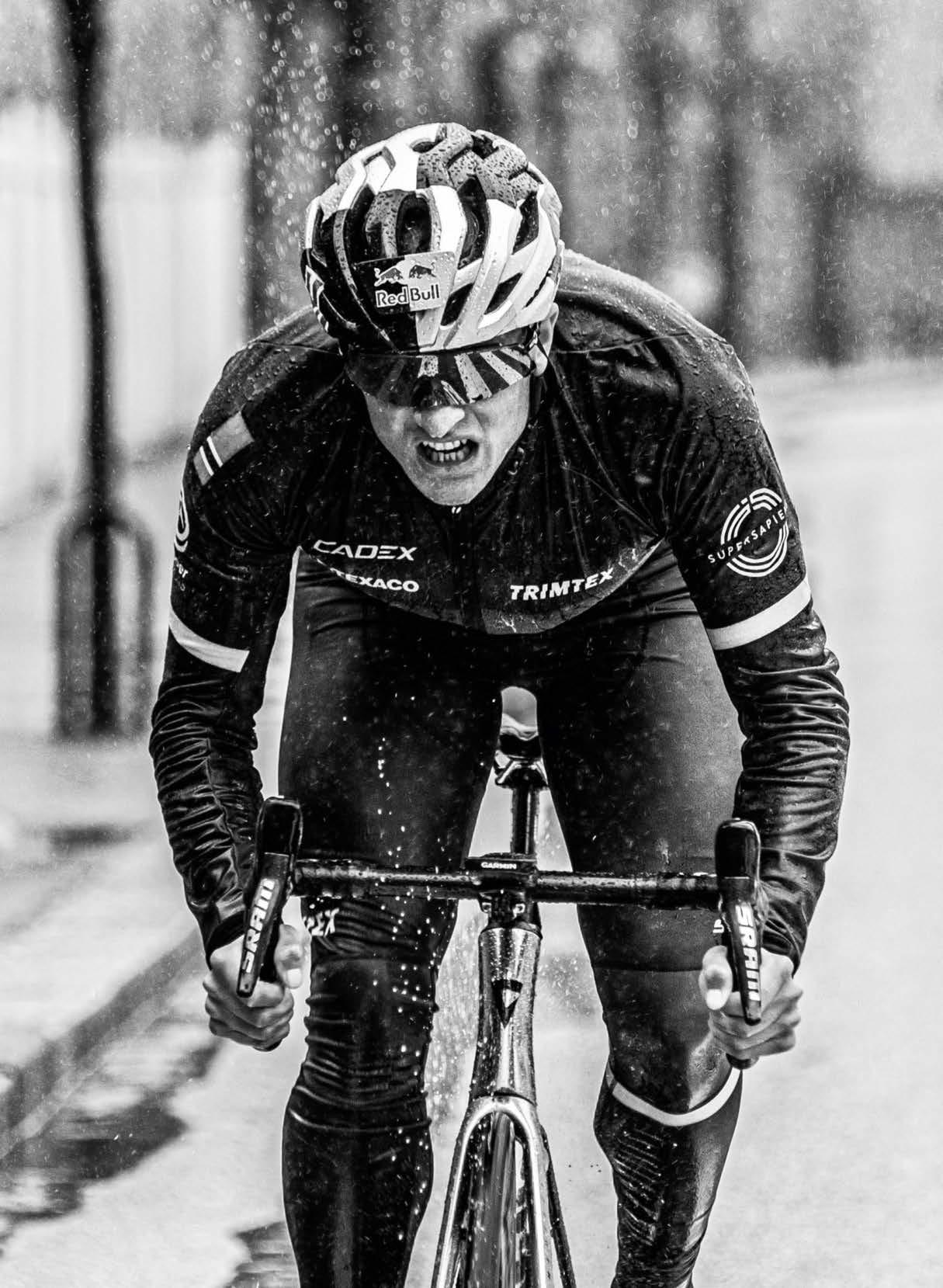
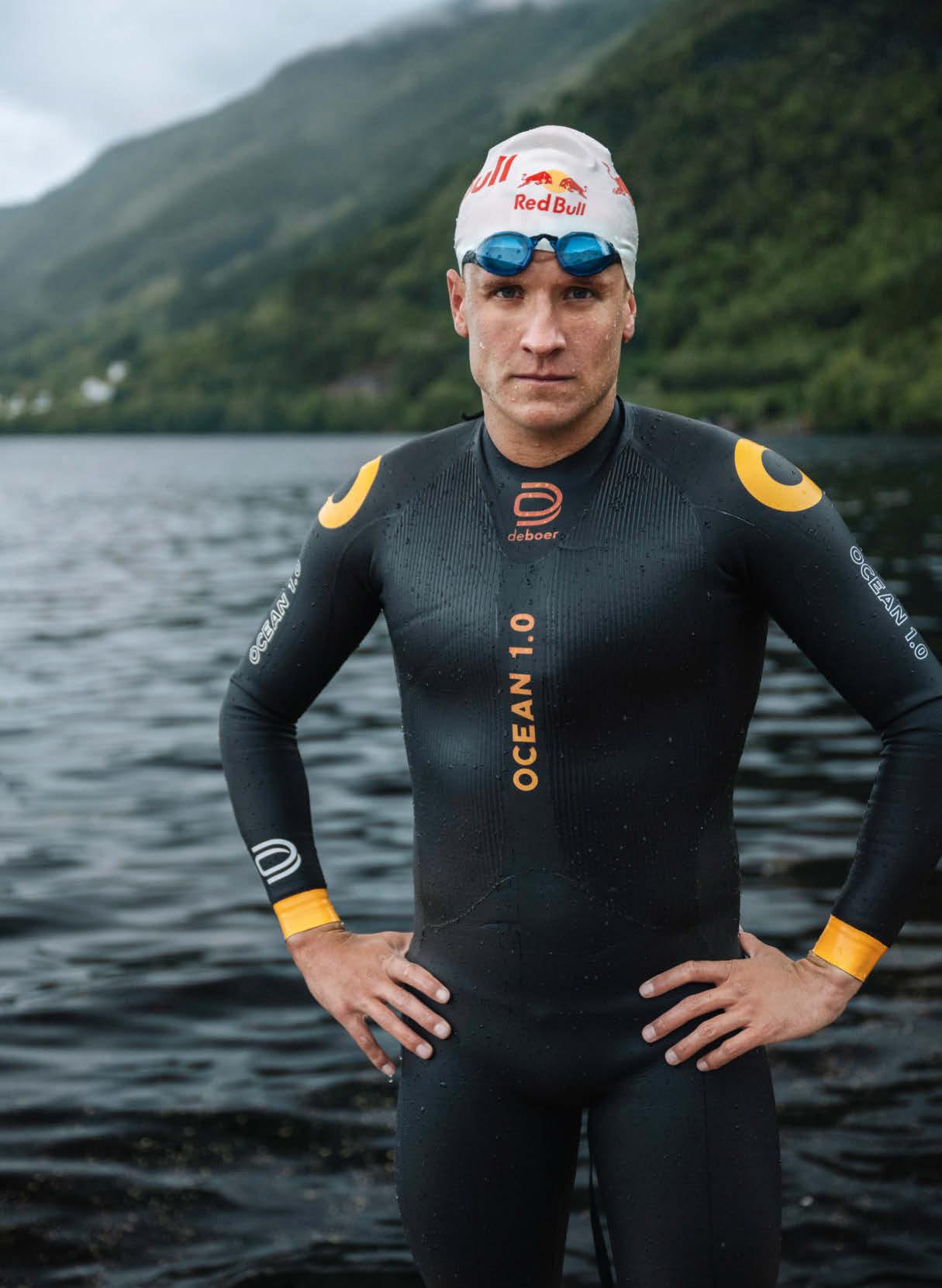
“I’m thinking about what I can do in the future; something no one else will be able to do”
It’s impossible to go anywhere but up from the city centre in Bergen, Norway. The old wharf is surrounded by seven small mountains, and the one nearest the city – Mount Fløyen – has a tram car that creeps its way to the top, transporting hundreds of cruise ship passengers every hour. Ironman and Olympic triathlon champion Kristian Blummenfelt knows the top of this mountain well, although he would never set foot on the tram. During the four or five weeks per year the athlete spends in his hometown, this is where you’ll find him cycling and running, almost always in the rain.

At the summit, just 100m from an outlook where tourists draped in plastic
ponchos snap pictures of the city from a lofty height of 400m, there’s a tiny brown barn where a handful of goats live. Blummenfelt, 29, used to joke that this was Jan Frodeno’s house, referring to the 41-year-old German who has dominated his sport for more than a decade and is universally considered the greatest triathlete of all time: the GOAT. But things can also change quickly in the world of triathlon, as Blummenfelt is proving.
Until May last year, Frodeno was the only triathlete in the history of the sport to have won both an Olympic gold medal and an Ironman World Championship – something once considered impossible because of how different the distances
Master stroke: the champion is training for his next challenge – the World Triathlon Championship in March Kristian Blummenfeltand styles of racing are. The Olympics are contested over a 1.5km swim, 40km bike ride and 10km run; an Ironman consists of a 3.8km swim, 180km bike ride and 42.2km run. Frodeno won the 2008 Beijing Olympic triathlon in a thrilling sprint finish, and then the Ironman world title seven years later at his second attempt.
While it may seem like an eternity in most sports, taking seven years to figure out an event that’s almost four times as long was considered a remarkably swift turnaround by triathlon standards, and many wondered whether such a feat could ever be repeated. That was until last May, when Blummenfelt won the Ironman world title at his first attempt, just nine months after standing atop the podium at Tokyo 2020.
But when Blummenfelt took the world title, there were two asterisks next to his achievement. Firstly, he won his Ironman World Championship in May 2022 in St George, Utah – a temporary home, due to COVID concerns, of the event that has lived in Kona, Hawaii, since 1978 and has essentially built the sport. The second asterisk resulted from the absence in St George of two of the only men with a legitimate shot of defeating Blummenfelt. One was Frodeno, who suffered a tear in his Achilles tendon. It was supposed to be the first race between the two, who have never met, nor even spoken. The other missing man was Gustav Iden, who knows Blummenfelt better than anyone else on the planet.
Two years Blummenfelt’s junior and also from Bergen, Iden is a two-time winner of the Ironman 70.3 World Championship – half the distance of a standard Ironman – and the pair spend upwards of 300 days a year training and travelling together. In Norwegian triathlon, everything is about the team, and the team are almost all from Bergen.
Located on the southwest coast and home to almost 300,000, Bergen is Norway’s second largest city and about as far removed from the rest of Scandinavia as is possible. Bergen is a bit of an oddity. There’s a Scandinavian sentiment known as hygge, meaning a desire to live a life of cosy contentment, but it’s not quite so prevalent in Bergen. The rainiest city in Europe isn’t exactly lacking in confidence or personality – locals like to say that they’re from Bergen first, Norway second.
“We talk like we’re the greatest people and city on Earth,” Iden says of his hometown. “Our football team is really bad [local team Brann spent last season in Norwegian football’s second tier before being repromoted to the top league, Eliteserien]. But we all say they’re the greatest team in the world. The confidence level is really high here and we’re very proud of that.”
Blummenfelt isn’t lacking in confidence either, but his isn’t directed outward in the way many Bergensers, including Iden, are famous for. He’s more of an introvert, and his teammates joke that he’s socially awkward –something Blummenfelt doesn’t refute. He doesn’t do small talk and claims his only fear is going on dates with women. “I’d be way more nervous going on a date than at the start of a world championship,” he says. “It would be nice to meet someone, but I wouldn’t sacrifice my sport for it – for now.”
Right now, Blummenfelt is fully immersed in his sport, which means three training sessions most days, and spending his few free hours consuming every ounce of triathlon content possible. He loves social media and reads almost everything that’s posted about him, keeping tabs on who believes in him and who doesn’t. It’s motivation, and it helps create an extreme tunnel vision focused on triathlon.
When he gets some time at home at the end of the day – whether that’s in his small apartment in Bergen or even smaller apartments in his favourite high-altitude training destinations of Font-Romeu, France, and Sierra Nevada, Spain – Blummenfelt sets a timer for two hours so that he has a reminder to shut everything down. If he has a momentary break from triathlon, it’s a few minutes of Netflix before bed.
“My favourite TV series is [dark US crime drama] Dexter, because of his
personality,” Blummenfelt says. “He’s obsessed with one thing. Just instead of murder, my obsession is triathlon.”
Blummenfelt was born the youngest of three children, in what he and his teammates joke is the rough side of Bergen. His father was a construction worker, his mother a nurse, and he and his two older sisters enjoyed a relatively normal middle-class upbringing. Neither of his parents were athletic, but like most Norwegian families they spent almost all their free time outdoors, hiking, skiing and camping as often as possible.
Swimming was the sport that made him fall in love with racing, and he was good but not great in a country not known for its prowess in the pool. Blummenfelt’s biggest limitation in the water was his height – just 1.7 metres –but he was remarkably efficient on land, routinely dusting his teammates when they would go out for runs as a means of cross-training. At the age of 12, he ran 10km in 36 minutes – a world-class time for a preteen.
Realising Blummenfelt’s greatest talents were outside the pool, a coach suggested he compete in one of the first triathlons in western Norway. Only 14 at the time, and the youngest of the 32 competitors, he finished first. While he wasn’t up against world-class competition, the ever-boastful Bergen was on a mission to produce Olympic and world champions, so the result caught the eye of the local sports academy.
Roger Gjelsvik is a mountain of a man with a booming voice and an eye for athletic talent. He wears many hats in Bergen, one of which is recruiting athletes with Olympic potential to Tertnes Toppidrett Sports Academy. Norway has a number of sports high- schools, where the best of the best can essentially start training like an elite athlete before they can even drive.
“There wasn’t really anything physical we noticed about Kristian. We could tell straight away he was different up here,” Gjelsvik says, pointing to his temple. “Sure, the big lungs and big capacity may help, but he was born with that toughness you can’t learn. He’s a Viking.”
Prior to Blummenfelt’s arrival in 2010, Gjelsvik had never recruited a triathlete to the school, and Norway hadn’t sent a triathlete to the Olympics since the sport’s introduction in the 2000 Summer Games. There were already swimmers,
“[Winning Ironman 70.3] was like a plaster on the sore, but I can’t get revenge for Hawaii outside Hawaii”
Born to run: Blummenfelt began long-distance racing at an early age – aged just 12, he ran 10km in 36 minutes
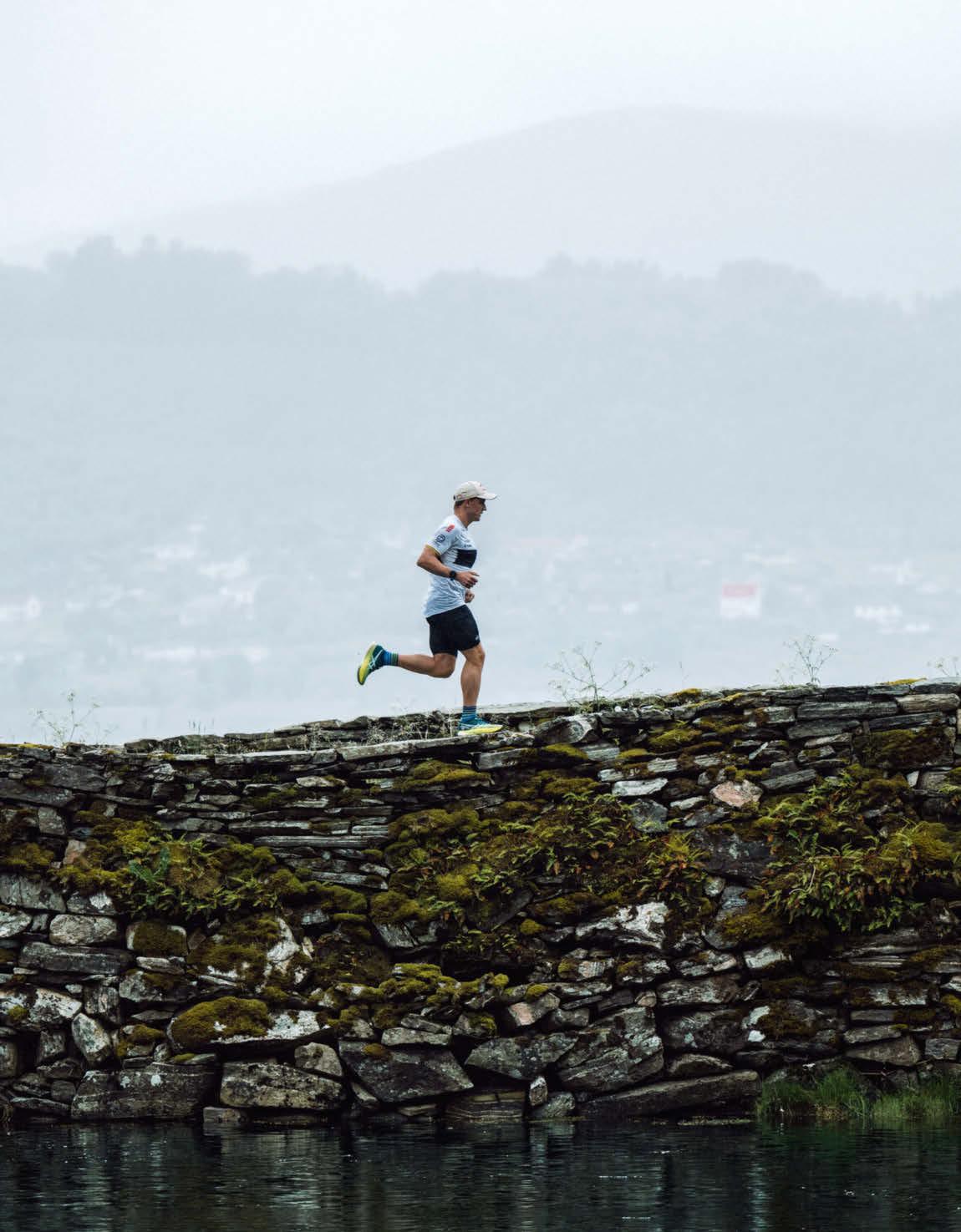
Riding high: Blummenfelt in training last May, with a glorious vista of his home city as a backdrop

cyclists and runners, so he was a perfect fit. Two years later, Iden was enrolled as well. The goal was simple but ambitious: produce an Olympic medal by 2020.
When sports scientist and triathlete Arild Tveiten was brought in to run the programme, things started happening quickly by triathlon standards, but still not quickly enough for Blummenfelt. Tveiten and Norway’s growing team of coaches designed a programme that adheres to strict testing and data science; anything that can’t be measured is thrown out. Blummenfelt was tasked to do a huge
amount of easy bike and run volume. It’s part of why he’s been able to do the seemingly impossible and perform well at all distances at once: he’s been doing Ironman-like mileage since he was 17.
After three years at Tertnes Toppidrett, Blummenfelt was one of the top-ranked juniors in Europe and was ready to pursue triathlon full-time, and he had the support of a new federation with a laser focus on getting one or two athletes to the top of the sport. There were months spent at altitude camps in the Pyrenees and the Alps, endless testing of both
body and equipment, and a new level of professionalism for pro triathletes. At the 2016 Rio Games, a 22-year-old Blummenfelt became the first triathlete to represent Norway in the Olympics, finishing 13th as the second youngest in a field of 55. From the outside, it was a monumental achievement for the upstart federation; for Blummenfelt, it was devastation. He’d finished on the podium at a handful of races in the build-up to Rio, so being so far removed from the medals felt like total failure. The post-Olympic depression that grips so many athletes
was very real for Blummenfelt, but it also helped create the monster that has taken over the sport today.
Emblazoned in gold letters on Blummenfelt’s prototype triathlon bike are the words ‘It hurts more to lose’. He’s not sure where it started, but at some point after Rio it became a mantra – one that pushed him to the most dominant and improbable 18 months in the relatively short history of triathlon.
“People love asking me how I’m able to dig so deep in races,” he says. “My
Kristian Blummenfeltanswer is always that the pain of not winning a race, or thinking that you could’ve gone deeper into the basement… that pain is what drives me in the race. I might have to suffer a lot for the next 10 or 15 minutes, but it’s never as bad as the depression I’ll feel for the next days, weeks or months if I don’t go there.”
In the five-year stretch between Rio and Tokyo, Blummenfelt’s only major win came in the final race of 2019 – the World Triathlon Grand Final in Switzerland –where he won on the top circuit for the first time. But he was now one of the handful of Olympic favourites. The three Norwegians in the 50-man field finished first, eighth and 11th. The other two –including Iden, who came eighth – were extremely disappointed with their result.
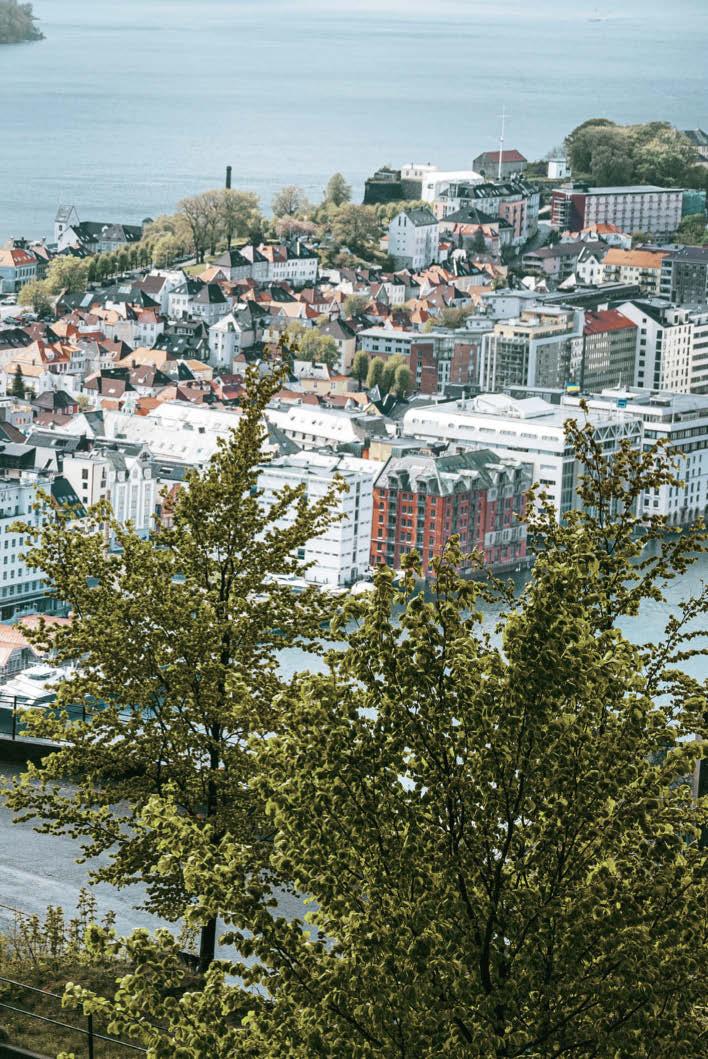
When Blummenfelt announced he’d like to win the Ironman world title after winning the Olympics, he was mostly mocked on social media. Only once in the 44-year history of the race has an athlete won on their debut, and never before had an athlete excelled at Olympic and Ironman racing at the same time. There was a linear progression every athlete before him had followed, but he and his team had the data to know they could perform the same three disciplines for a much longer duration. It was just a case of more testing and fine-tuning the pacing.
Part of what baffles people about Blummenfelt is his build. At 1.7m and 74kg, he’s often labelled as big for an elite triathlete; there are even fat jokes directed at him on Twitter. Frodeno, by comparison, is almost eight inches taller and only a pound or two heavier. Blummenfelt is putting an end to the long-held belief that long and lean is the only ideal body type for ultra-endurance sport. Both he and his coaches are quick to point out that the engine matters more than the exterior.
“I’m motivated by it,” he says. “I like getting messages on social media from people saying I helped them believe they could run faster as a big person. It’s funny. I’m coming from swimming, where I was always the small guy.”
In the 18 months since Tokyo, Blummenfelt has taken over the sport.
He followed the gold medal by winning his first World Triathlon Series title, making him the only athlete to win gold and a world championship in the same year. After the Ironman World Championship was moved to spring
“The pain of not winning, or thinking you could’ve gone deeper… that’s what drives me in the race”
having success over long-distance back again to short-distance,” he says. “If you said it two years ago, people would have said it’s not possible. But after the two years I’ve just had, going from short to long, people are more interested, less pessimistic. Me? I feel optimistic. I’m close to the front of the race right now.”
2022, he decided to make his Ironman debut in Cozumel in November 2021, covering 225km faster than anyone in history. He then, of course, took the world championship title in May. And in late October he won his second world title of last year at the 70.3 World Championship. It was at his Kona debut earlier that same month, however, that Blummenfelt suffered a rare setback. With the race back on the Big Island, and Iden with him on the start line (Frodeno once again pulled out due to injury), the stage was set for an epic battle between the teammates.
As ever, Blummenfelt dug deep. But despite finishing in what previously would have been record time, this time it wasn’t enough to take the win; not even to come in second. France’s Sam Laidlow finished ahead of him, and it was Iden who was first over the line, pushing Blummenfelt down into third. His win, three weeks later, at the 70.3 World Championships was no salve for the pain of losing in Hawaii.
“In the [Kona] race, I just had to go into battle and fight for that third place and make sure I didn’t lose it,” he says. “The last 10km is when it all comes together, and that was the big battle. I had been really looking forward to [competing] against the best guys in the world, and I just came a bit short this time around. After [Kona], I was just
extremely tired, combined with being disappointed, and relieved I managed to get on the podium and come away with something. I’ve never been that tired after a race – I was really digging deep, and I put in the best I had on the day. Afterwards, I had the 70.3 and there was the hunger of coming back, of using another race as motivation. It felt like a plaster on the sore, but it couldn’t undo anything – I can’t get revenge for Hawaii outside Hawaii.”
Blummenfelt says he’s continuing to use his defeat in Kona as motivation for the coming year as he embarks upon what he believes will be the biggest challenge of his career: defending his title at the Paris Olympics in 2024.

“When I was first doing long distance, there was no way back [to short distance] – no athlete has gone from
With the men’s Kona event being moved off the island again in 2023, Blummenfelt has had to shelve his desire for ‘revenge’ until 2024. Instead, his return to short distance begins with the Abu Dhabi leg of the World Triathlon Championship series in early March as he looks ahead to 18 months of hard work and pain. But, he says, he feels ready for it. “You’re always dancing between joy and torturing yourself,” he says. “Like with the training, you can do a month where you’re in this zone, where you’re pushing yourself to the absolute limit, but as long as you’re getting the response you want, it can be a beautiful balance of pain and joy. I try not to think of any of it as torture, more pushing boundaries in the numbers, doing things I haven’t done before.”
Iden will be by his side, putting in the hours to get revenge for his own equivalent of Kona – the Tokyo Olympics. And, despite Iden arguably having taken Frodeno’s place as his biggest competition, Blummenfelt says nothing will change in terms of their close-knit training regime. “Yes, I think Iden is the guy to beat now, maybe over the next decade, in long distance. But both of us appreciate the fact that we’re working together and having guys around who are improving the level of training. Especially with us moving the focus away from longdistance to short-distance into Paris. We are maybe not underdogs, but we’re not favourites to win. Paris is bigger than just a rivalry between me and him.”
For Blummenfelt, winning in Paris is about even more than reaching the top step of the podium. The multiple world champion has his eye on what he believes will be a more enduring achievement than any single victory – one he’s been working towards since he won gold in Tokyo. “To go from a short-distance to a long-distance title in a year, then back to short distance [in Paris], that will be very difficult to beat. It’s something that’s never been done before. I’m thinking about what I can do in the future; something no one else will be able to do.”
kristianblu.com
“Kristian was born with that toughness you can’t learn. He’s a Viking”
Roger Gjelsvik, Olympic coach


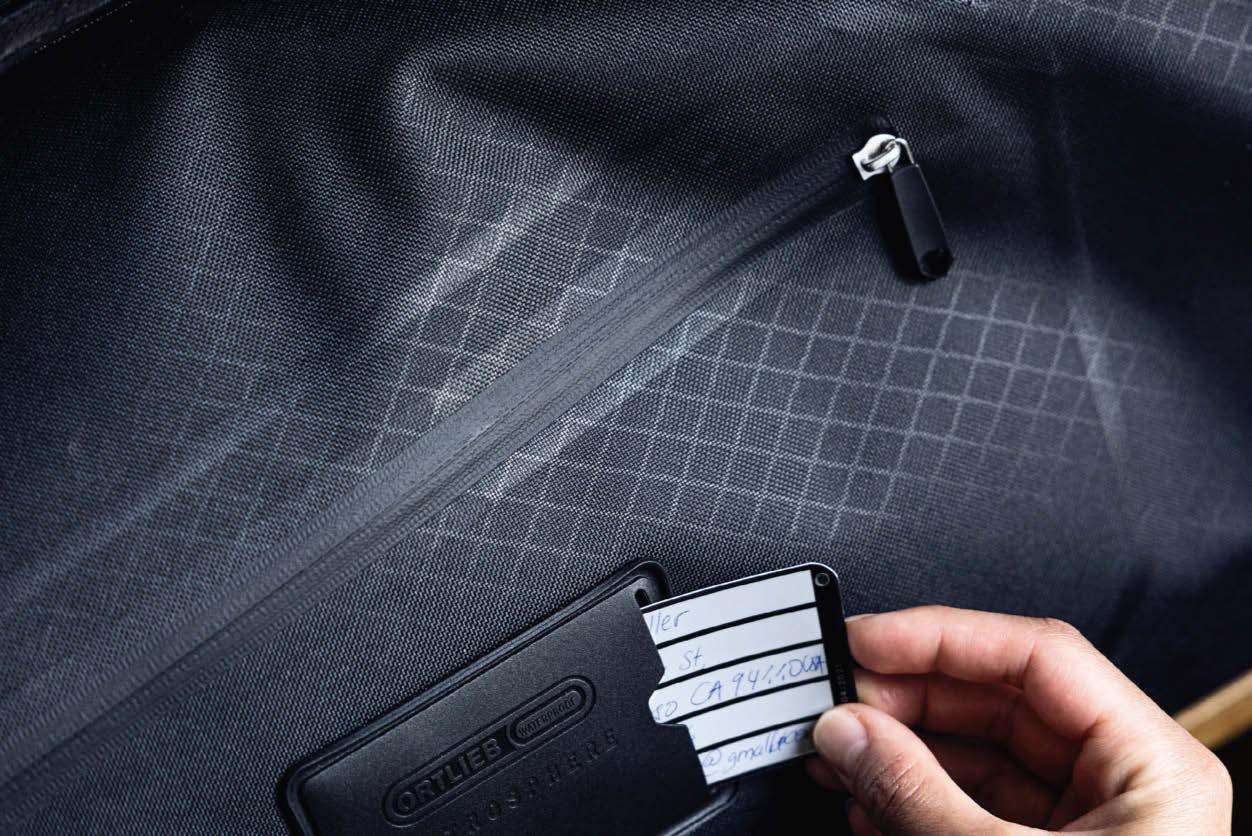
As a talented B-Boy himself, photographer FRANKIE PEREZ is perfectly placed to capture the spirit of breaking culture. Here, the New Yorker shares some of the most memorable moments he’s caught on camera
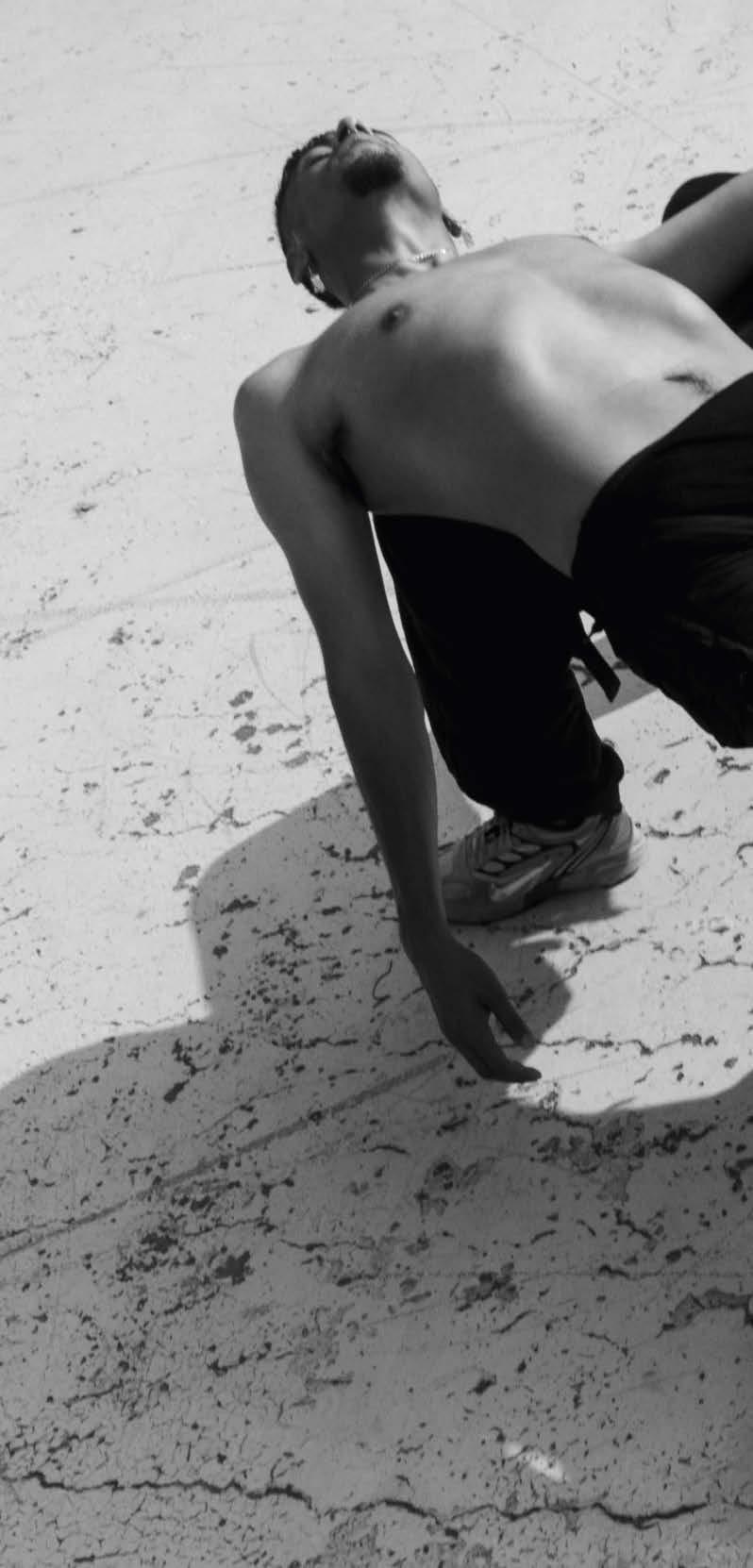 Words NORA O’DONNELL Photography FRANKIE PEREZ
Words NORA O’DONNELL Photography FRANKIE PEREZ
Body moving: the day after he won the 2021 BC One Cypher in New York, Perez shot B-Boys Mike the Titan (left) and Nebz as they worked through a routine.
“I didn’t give them direction,” Perez explains. “I just let them give me what they wanted in an organic way.”
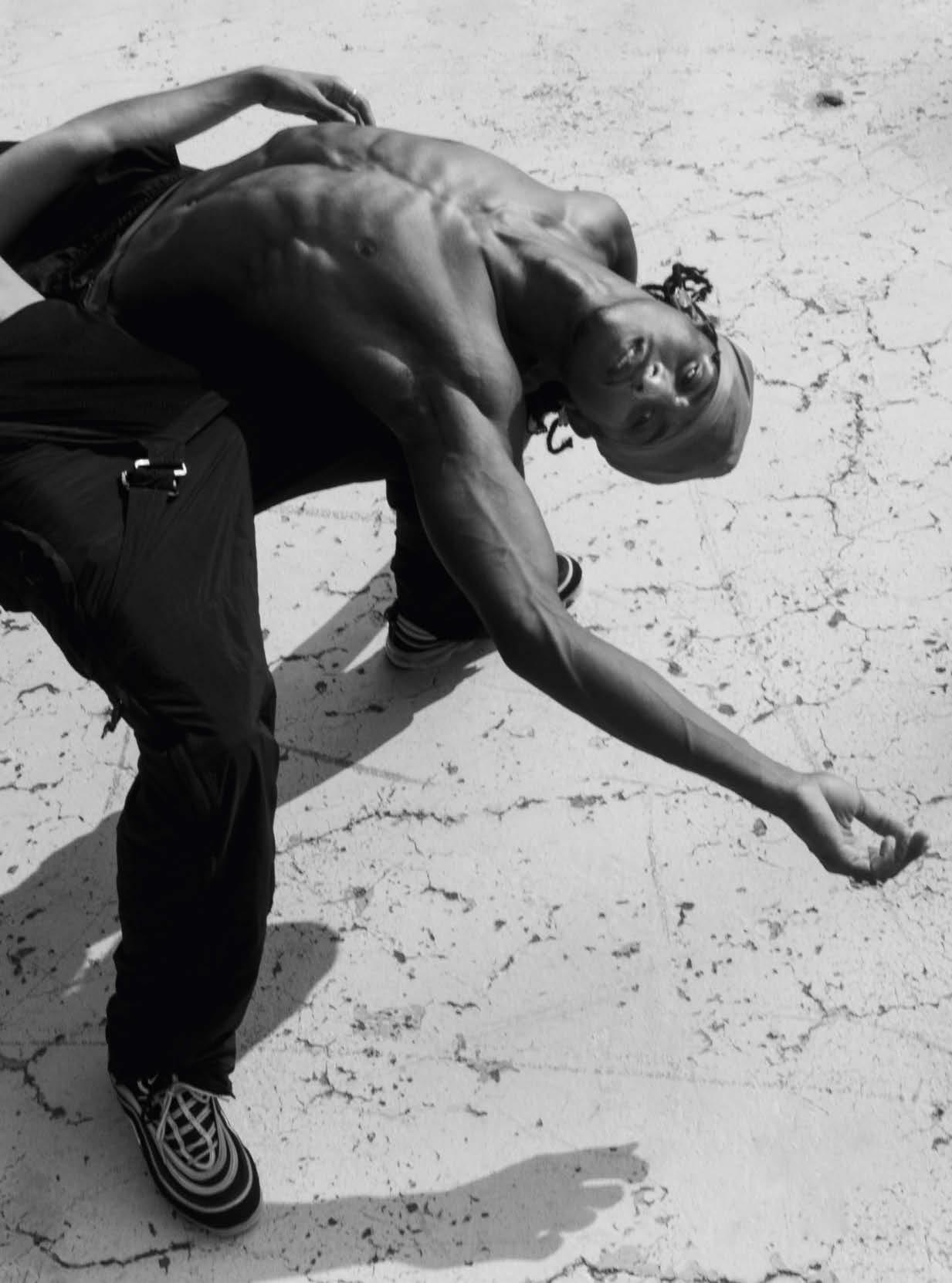 Frankie Perez
Frankie Perez
Photographer Frankie Perez vividly recalls the day when, as a 13-yearold growing up in Queens, New York, he frst witnessed someone breaking. “I was taken aback because it was such a new thing for me,” he recalls. “The rest is history.” After honing his craft as a B-Boy, Perez went on to win battles around the world, including the Red Bull BC One Cypher in New York in 2021. But these days he’s behind the camera as often as in front of it, and his perspective as a dancer with a keen eye for movement permeates his work. Last year, Perez released his frst book, See Me Up? It’s ’Cause I’ve Been Down, a collection of images that captures the world of street dance. “It was always part of the plan to bring breaking to the forefront of pop culture through my art,” he says. “I want to make something that people from the scene can be proud of.”
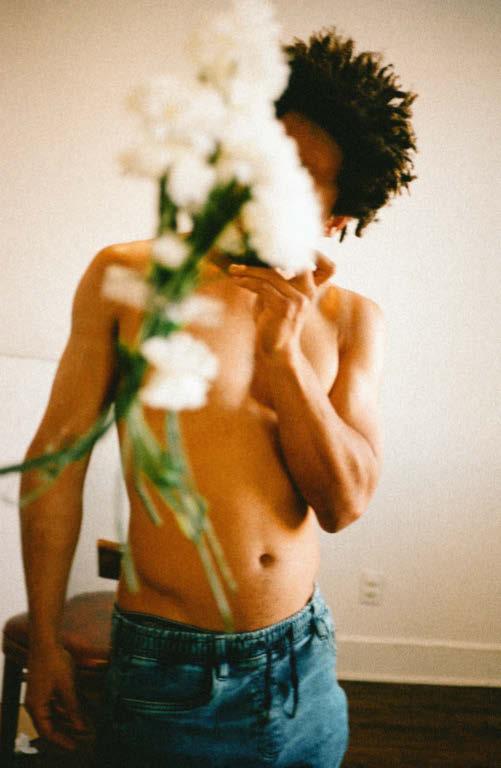
Follow Perez’s work on Instagram: @pluralist_
“I
Bloom time: “I had these flowers left over as props, and I was just messing around with them,” Perez says of this self portrait. just try to create as much as possible, whether I have an assignment or not.”Cutting edge: “Sometimes ideas for images just pop into your head,” Perez says. Like shooting a B-Boy with a sword, for instance. Here, Omen, a fellow member of Perez’s Supreme Beingz crew, executes the photographer’s vision in Orlando, Florida

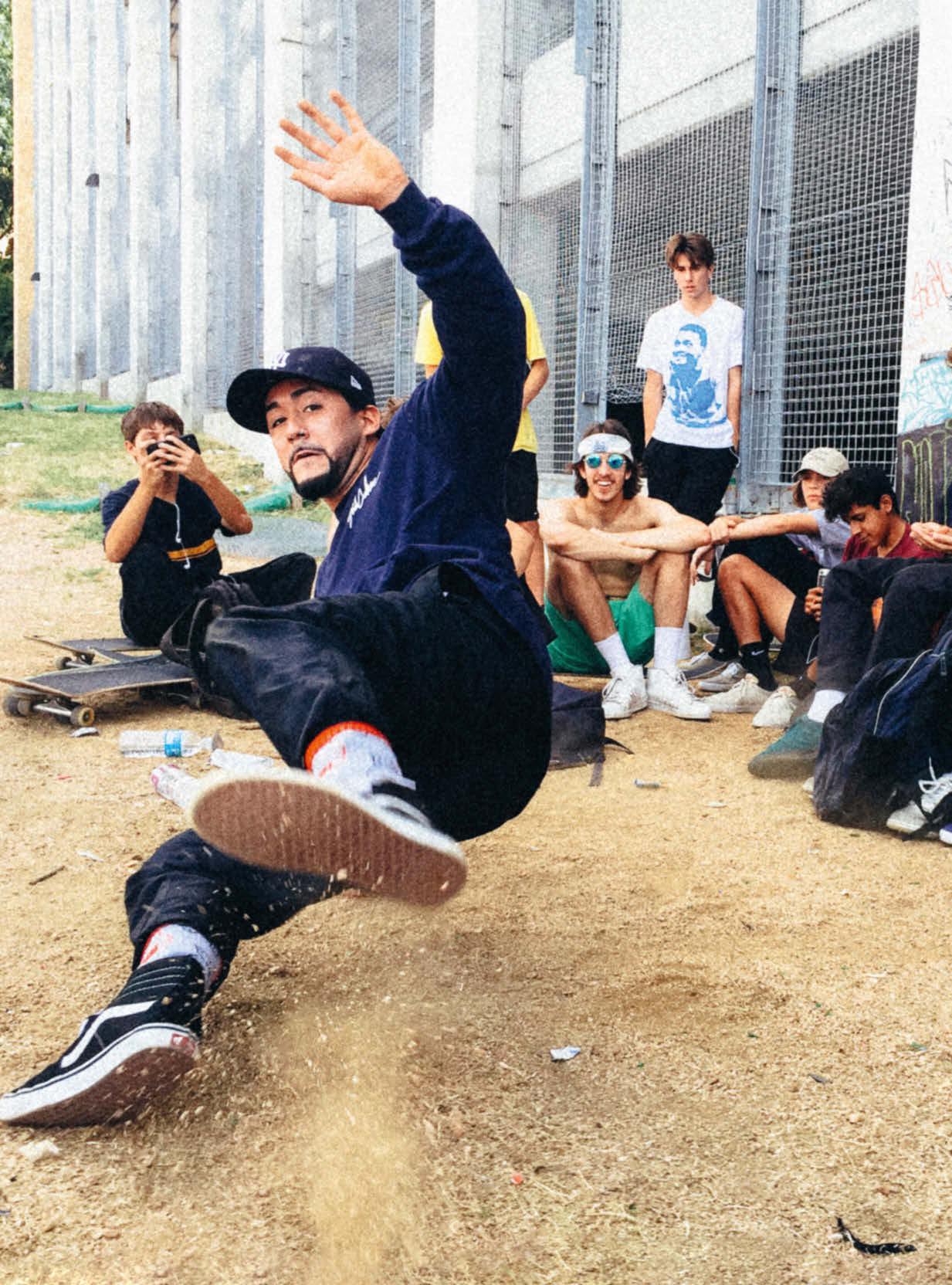
Dropping by: while shooting images for his book, Perez approached a group of skaters at a park in Austin, Texas, and asked if they’d like to be in a photo with Jay, a member of his Supreme Beingz crew. “It was super-spontaneous,” he says.
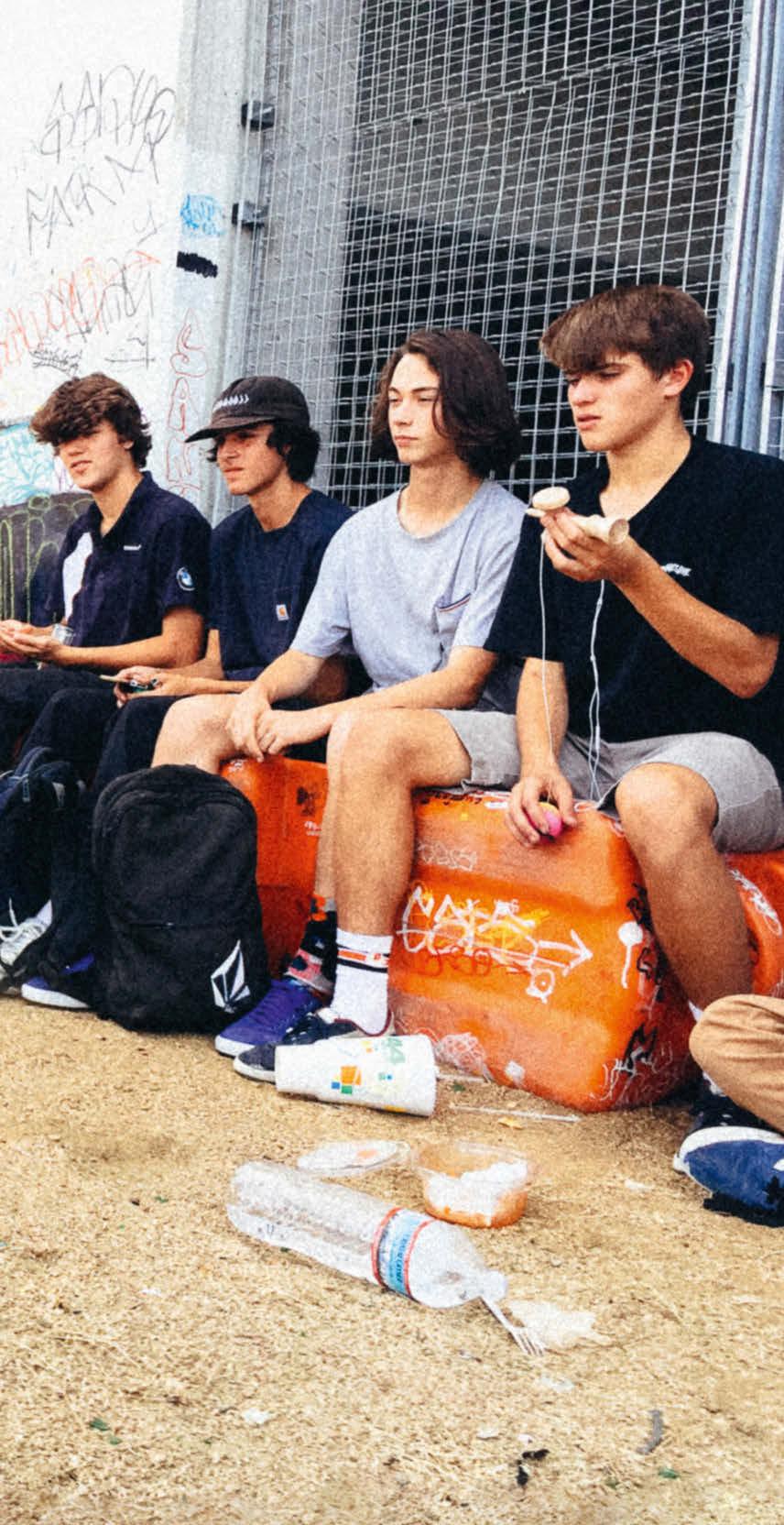 Frankie Perez
Frankie Perez
Field work: throughout Perez’s portfolio, there are nods to images he’s studied from the Dominican Republic, his family’s country of origin. This photograph, shot in Montréal, Canada, was inspired by a picture of Dominican farmers.
(Opposite) Flipping the script: the subject of this photo isn’t a breaker but a contemporary dancer.
“I wanted to show my breaking point of view on somebody who wasn’t a breaker,” Perez says.
“I was trying to exaggerate her movement to put my perspective on the images we were making.”

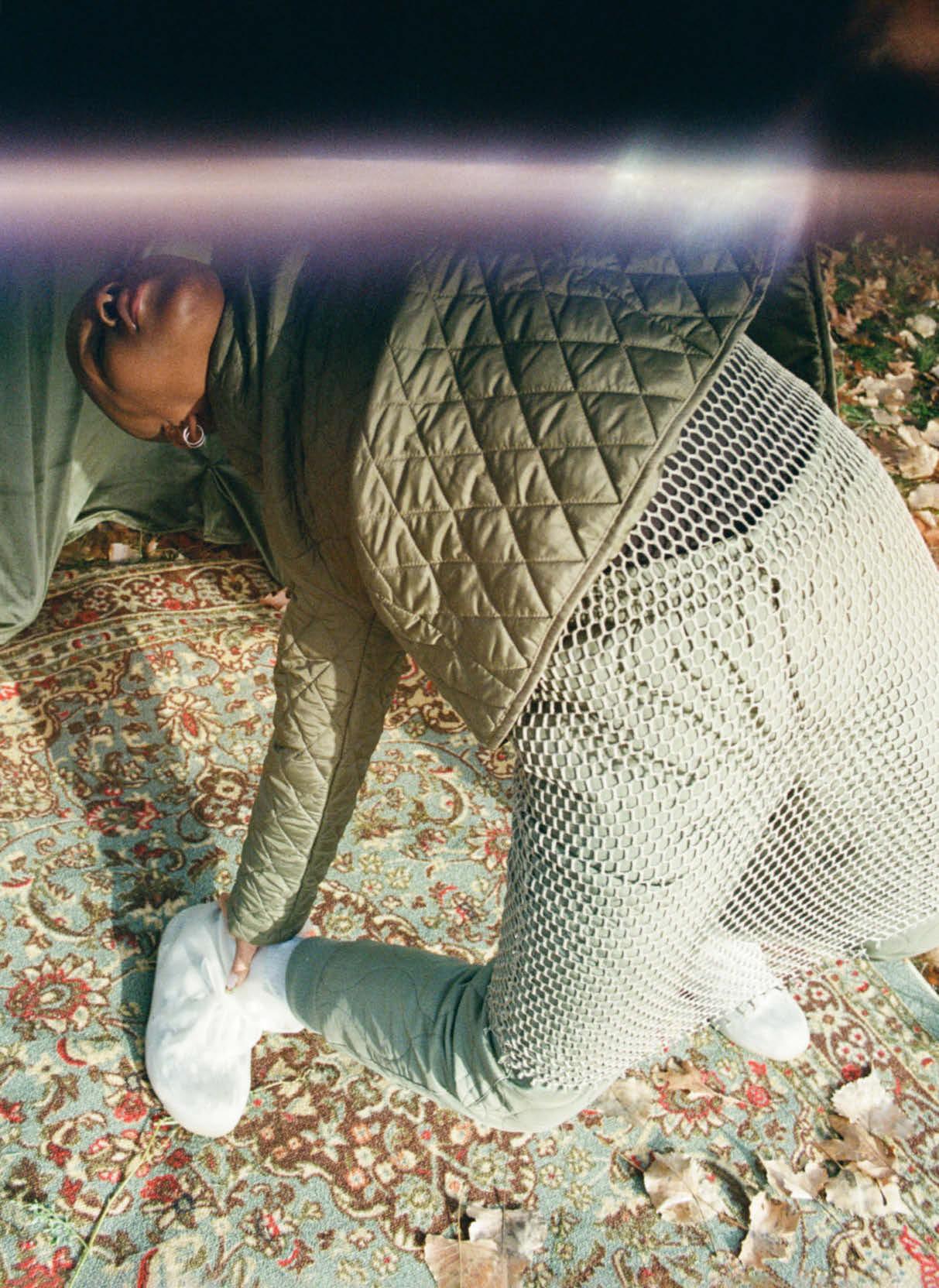

Fresh viewpoints: “I want to show the moments in between the breaks,” Perez says of this collection of images featuring Nebz, all shot in Astoria Park, Queens. Some of the images are screenshots from a video they filmed on the same day. “There’s a need to show breaking from different perspectives.”
(Opposite) Real deal: whenever Perez has the chance to shoot a major campaign – for Converse in this instance — he looks for opportunities to cast breakers. Here, B-Boy Fate of the Ground Illusionz crew serves as a model for the brand’s Fall 2020 collection.
 Frankie Perez
Frankie Perez
Depop and lock: Perez shot this image in Montréal as part of an international campaign for fashion resale platform Depop. “That was big for me,” he says. “One of my missions is to bring B-Boys to the forefront of pop culture.”
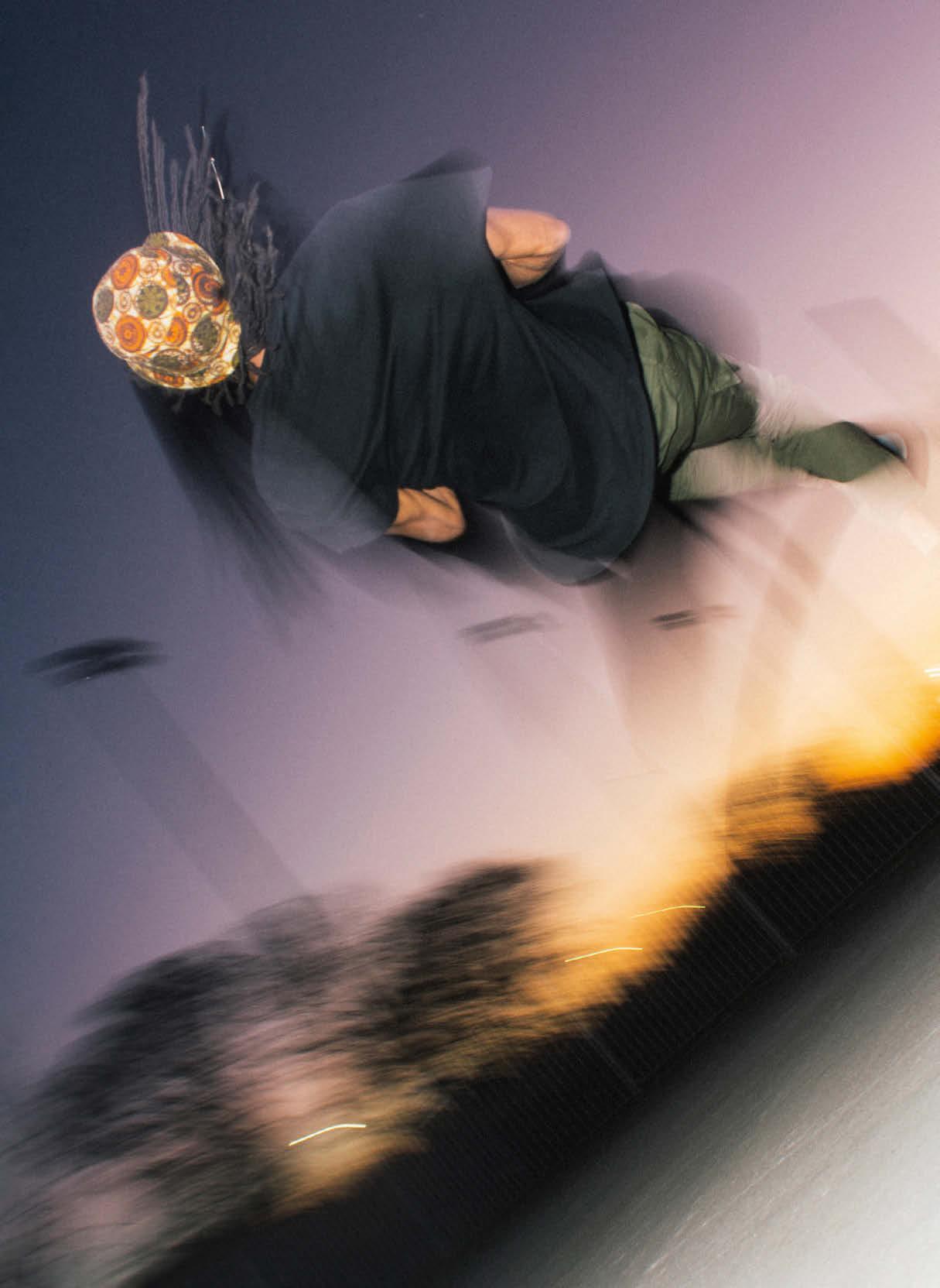
“On
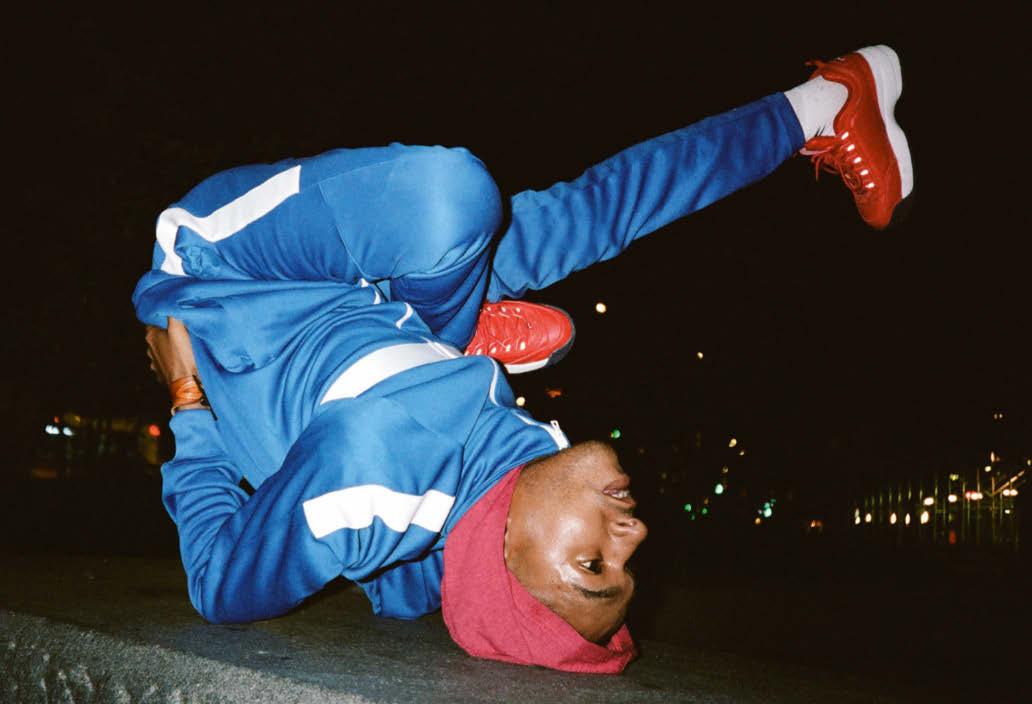
 (Above) Spin city: shot in Manhattan, this image of B-Boy Spinnerak – a childhood friend whom Perez first started breaking with –made the cover of his book.
a personal level, this is one of my favourite images I’ve ever made,” says the photographer.
(Above) Spin city: shot in Manhattan, this image of B-Boy Spinnerak – a childhood friend whom Perez first started breaking with –made the cover of his book.
a personal level, this is one of my favourite images I’ve ever made,” says the photographer.

Off-grid trekking on Senja, Norway
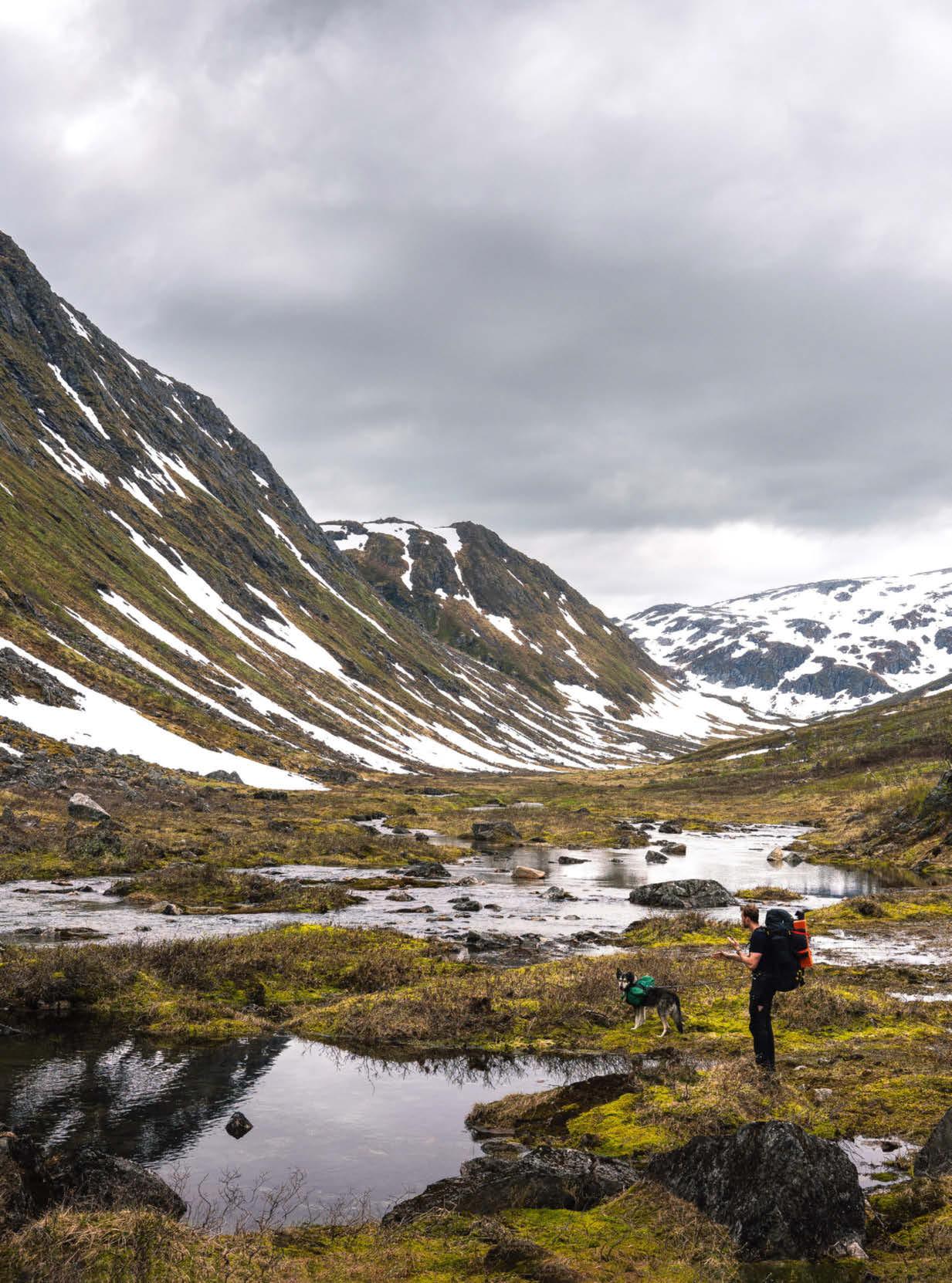
Iremove my boots and trousers to wade across the engorged river. The ice-cold water gnaws at my flesh with menace – payment for passage across. At points, I’m forced to hurl my pack and our working sled dog, Stein, across to my friend and photographer Tord [Karlsen] to save them from being swept downstream. Despite the freezing rivers, the air is clement, and the sporadic midsummer sun is warm against my face. For me, this is the greatest reward after an Arctic winter.
We’re on the second day of our fiveday, 100km trek from the north to the south of Senja, Norway’s second-largest island. Located around 60km southwest of my adopted hometown of Tromsø, at a latitude of 69° north, the island’s name is unchanged from the Old Norse meaning ‘to split apart’. From what I’d seen on my only prior visit, just two months earlier, it’s a fitting title. That time, I’d been to scout skiing locations but was met with a hostile landscape where the full force of the Atlantic beat a tune against the silhouettes of giants whose summits were obscured by sullen clouds. But Tord, who grew up just 50km southwest of Senja, on the island of Andøya, told me of its immense beauty – from rich plateaus and alpine summits to dense forests and enchanting lakes. Norway in miniature. I was sold.

The journey is unlike the more intense projects we’ve worked on, such as the rigorous sailing expedition from the Faroe Islands to Iceland to document plastic pollution on marine mammals in 2019, or freediving with sperm whales in the Arctic the following year. Our sole goal on this trip is to meander gently through the landscape, interweaving some bushwhacking with the Senja på langs – a 70km hiking trail that crosses the island. We would be doing so technology-free: no phone, social media or GPS. Averaging just 20km a day, we can take two-hour lunch stops and doze
beside rivers long enough for our socks to dry. This embodies a philosophy Norwegians call friluftsliv – free-air-life – which represents our innate need and connection to nature in the pursuit of greater happiness.
After collecting Stein, we turn off our phones and travel by ferry to Botnhamn, a village on Senja’s north coast. As we enter the calm, cod-rich fjord of Stønnesbotn, a lone Nordlandsbåt – a traditional fishing vessel resembling a Viking longship – rocks at its mooring. The island’s once-populous fishing communities have dwindled in the face of commercialisation over the past 50 years, with just 15,000 inhabitants left in an area just slightly bigger than
the Peak District. Walking south from Botnhamn, the feeling of remoteness is heightened by numerous abandoned and ramshackle homes.
Though it’s approaching 11pm, the sky is still bright – in fact, the sun hasn’t set for almost a month. We track into the Jurassic wildlands and camp beside the meltwater-heavy banks of Bukkelva. The foliage abounds with vibrant new life; after a winter in the Arctic, in a place devoid of vegetation, it’s almost blinding to see such colour again. A light breeze brings with it the scent of new growth. I’m reminded of England – the smell of cut grass and the warm days of spring – and surprised to feel such familiarity in the wilds of the Arctic.

“It’s mid-June, and the sun may be warm, but we still spot someone ski-touring on the ridgeline ahead –the only sign of human life during the crossing”
Hugh Francis Anderson, adventurer
Senja is a two-and-a-half hour drive from Tromsø, including a 45-minute ferry that departs from Brensholmen six times a day during summer. (Tromsø is a twohour flight from Oslo.) The west coast’s high granite peaks are a paradise for steep skiing in winter, while the interior’s gentle foothills and forests make it perfect for wilderness hiking. visitsenja.no
We rise early and continue southwest. While we may feel alone, the soft earth betrays the animals of the forest. Deer and moose droppings litter the pathway. The sky is alive with sounds: a wood dove calls; the cry of a bird of prey ricochets across the valley. The first swollen stream stops us in our tracks, an ice-cold crossing the only way forward.
As we cut southwest across Senja, we begin to rise, and winter still grips the ground above 350m. A keen fly fisherman, Tord is most excited about the trout in Langdalsvatnet. The lake, however, remains under a deep blanket of snow. We skirt its bank, every now and then plunging into slush up to our knees, searching for outcrops dry and
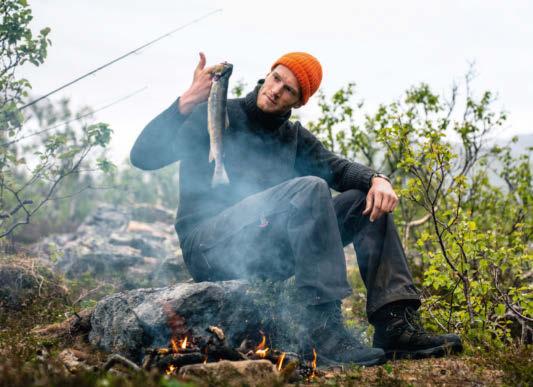

flat enough to set up camp. The following day, we reach our highest point on Istind – 851m – which remains trapped in winter. It’s mid-June and the sun may be warm, but we still spot someone skitouring on the ridgeline ahead – the only sign of human life during the crossing. During our migration through valleys and forests, I’d almost forgotten that we were on the edge of the North Atlantic. From Istind’s summit, the serrated granite walls reach like tendrils into the ocean – a result of the immense glaciers that existed here during the last Ice Age, 25,000 years ago.
We drop down and camp in Ånderdalen National Park, where marshland and ancient forests of birch, ash and pine adorn lakes in a vista more postcard Switzerland than Arctic Norway. It may be Senja’s only national park, but that hardly matters due to Norway’s famed allemannsretten – the right to access and travel across land even if it’s privately owned. It’s one of the
Three Arctic trekking tips
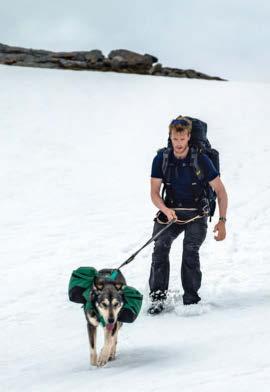
Find yourself
Brush up on your orientation skills to avoid getting lost, always have a GPS, and call 112 in case of emergency. Visit norgeskart.no for the most comprehensive topographic maps.
Pack smart
As the Norwegians say, “There’s no such thing as bad weather, only bad clothing.” From woollen base layers to a windand waterproof shell, pack for all conditions, whatever the forecast.
Break it up
When embarking on a multi-day trek with heavy packs, it’s wise to follow the 50:10 rule: hike for 50 minutes, rest for 10. This is a tactic employed by the Norwegian military, and you’ll be amazed at how much energy you still have at the end of the day.

reasons why I live in Norway, and why there’s such a deep connection to nature among Norwegians.
On our final night, I catch my first trout beside the banks of Trollvatnet, where moss, thick like a woollen blanket, engulfs the rocks and trees around. It’s quite an experience – to feel the bite, then the line go taut, and slowly reel in supper. Lying in our sleeping bags as a fresh breeze rattles the tent’s walls, Tord and I discuss how our awareness has changed since the removal of digital distractions. The summer is short here in the Arctic, and life surges with ferocity, but to witness the leaves of ferns, trees and berries slowly peel open day by day comes only by slowing down. And these are the details we ordinarily miss.
Hugh Francis Anderson is a British-Dutch writer who specialises in adventure and the environment, and a Fellow of the Royal Geographical Society. He lives in Tromsø, Arctic Norway. Find out more at hughfrancisanderson.com
“Our sole goal is to meander gently through the landscape”
Glacier, Mountain and Lake. Discover one of Austria’s largest ski areas with TOP snow quality. The Schmittenhöhe family ski resort with one-of-a-kind mountain and lake views plus ski-in ski-out directly to the Kitzsteinhorn glacier. www.zellamsee-kaprun.com/winter
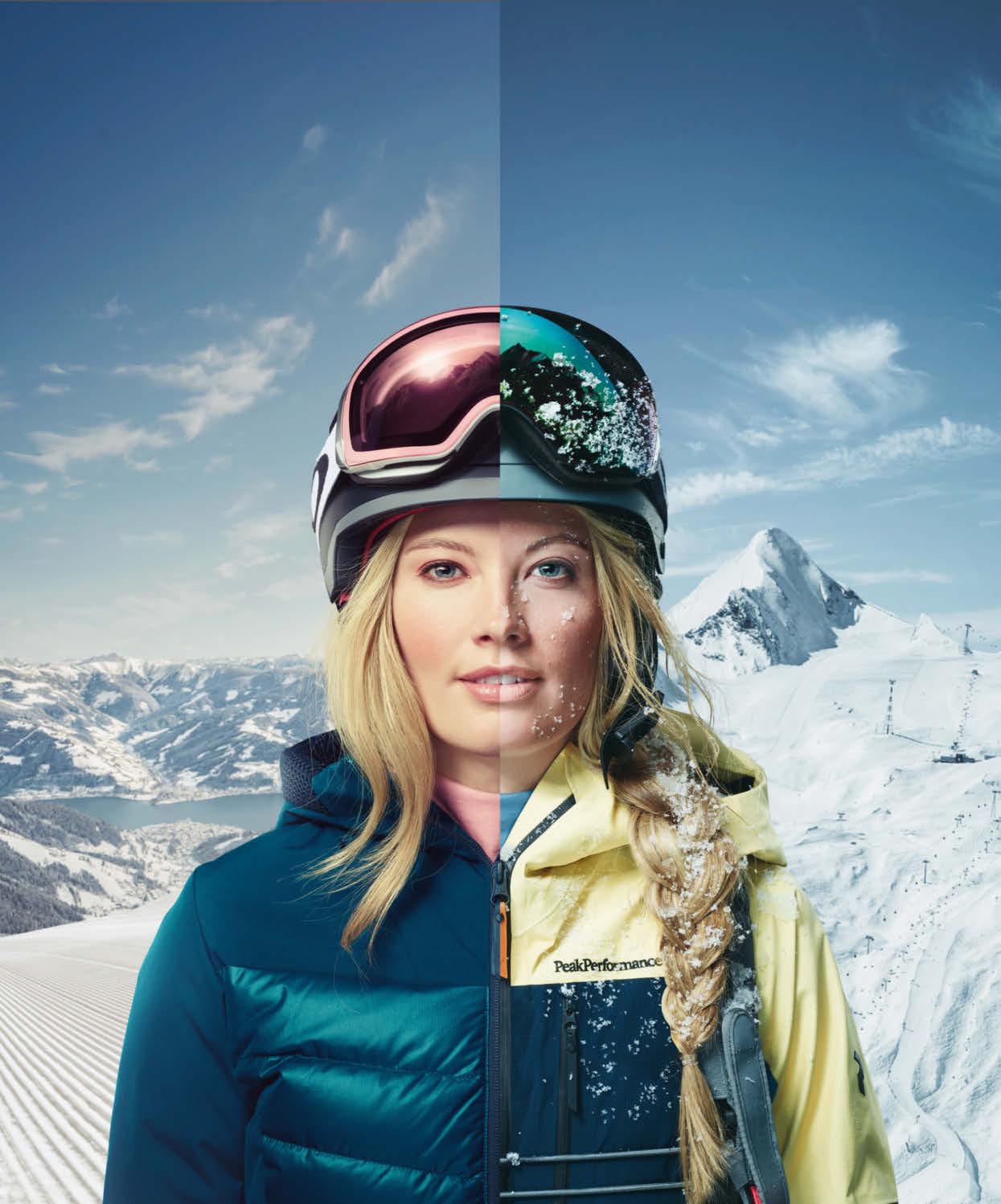
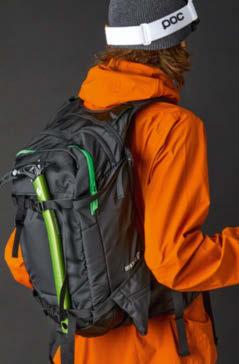
Adventurous skiers don’t stay on-piste – they head to the backcountry. Here’s everything you’ll need for your ski-touring trip…

Right: 66°NORTH Dyngja Beanie, 66north.com; POC Nexal Clarity Goggles, pocsports.com; RAB Khroma Kinetic Waterproof Jacket and Bib Pants, rab.equipment; K2 Mindbender 120 Ski Boots, k2snow.com; BLACK DIAMOND Dawn Patrol 32 Pack, Legend JJ Edition Gloves, Vapor AL Ski Poles and Helio Carbon 104 Skis, blackdiamondequipment.com
Below: as pictured right, plus BLACK DIAMOND Venom LT Classic Axe, blackdiamondequipment.com
ABS sidewalls improve edge hold, grip and dampness (the absorption of vibrations between ski and snow)

SwitchRelease technology in the wrist strap of the Black Diamond poles provides an additional degree of safety, allowing for a quick detachment if caught in bushes or trees
 Left and above: POC Obex BC MIPS Helmet and Dimension Avalanche Backpack, pocsports.com; 100% The Norg Snow Goggles, 100percent.com; HELLY HANSEN Elevation Infinity 2.0 Ski Shell Jacket, Bib Pants and Freeride Mix Gloves, hellyhansen.com; K2 Mindbender 95 Ski Boots and Mindbender 89Ti Skis, k2snow.com; BLACK DIAMOND Expedition 2 Pro Ski Poles, blackdiamondequipment.com
Left and above: POC Obex BC MIPS Helmet and Dimension Avalanche Backpack, pocsports.com; 100% The Norg Snow Goggles, 100percent.com; HELLY HANSEN Elevation Infinity 2.0 Ski Shell Jacket, Bib Pants and Freeride Mix Gloves, hellyhansen.com; K2 Mindbender 95 Ski Boots and Mindbender 89Ti Skis, k2snow.com; BLACK DIAMOND Expedition 2 Pro Ski Poles, blackdiamondequipment.com


Aga Pomaranska had immersed herself in mountain biking since moving from Poland to Edinburgh in 2006, and weekend rides on the offroad trails of Innerleithen –30km south of the city – saw her progress from a novice to competing in a handful of amateur races. But on this day in mid-2020, with COVID rules restricting her to Edinburgh’s limits, the 36-year-old was forced to look closer to home to get her fast and furious fix. The Skelf was the answer.
The purpose-built bike park, which sits in the shadow of Arthur’s Seat, includes a 160m-long course known as a pump track. An increasingly prevalent addition to skate and bike parks over the past two decades, the track is a loop of rollers – a smooth, wave-like obstacle comprising rises and dips – and banked turns known as berms. Tracks vary in length and can be constructed from dirt, asphalt or concrete, but the principle remains the same: riders propel themselves around the course by ‘pumping’ rather than pedalling – generating momentum using only gravity and on-bike positioning.
Pomaranska, who had never attempted a pump track before, decided to give it a go. “With mountain biking, I was mostly on a full suspension bike, so it was very forgiving,” she explains, “but this was a different style of riding – I needed to go back to basics.”
Last June, less than two years on from that first foray, she took to the Skelf’s track at the UK qualifying round of the Red Bull Pump Track World Championships. Racing against the clock, Pomaranska recorded the fastest time and secured a spot at November’s finals in Santiago, Chile, where she would finish 26th.
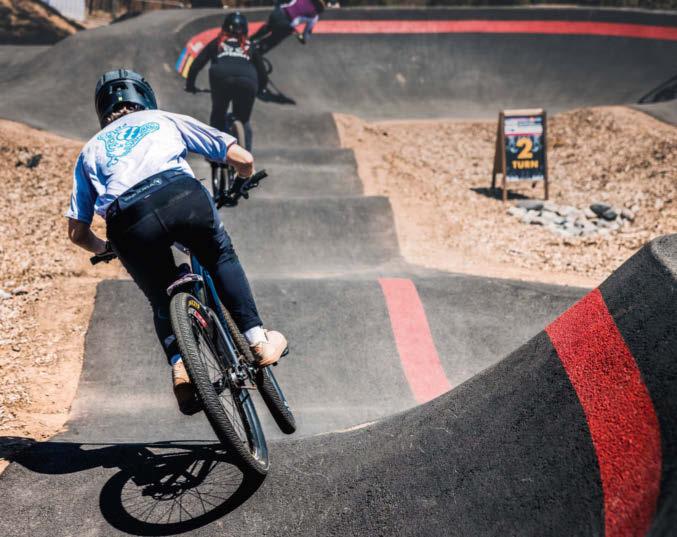

Although still perfecting her pump technique, Pomaranska clearly knows a thing or two about keeping those wheels rolling…
Before dropping in, get your positioning perfected, advises Pomaranska. While standing on the pedals, you need to be slightly crouched with your elbows and knees bent. “You never sit, but you don’t have locked knees and arms, either,” she says. “Be ready to move up and down.”
The main obstacle of the pump track is a roller. Gravity and momentum from the descent of one roller helps you reach the top of the next, but it’s possible to generate more speed by ‘pumping’ the bike. “I imagine it like jumping on a trampoline – if you want to go higher, you need to compress and bend your legs,” says Pomaranska. “When entering the dip, bend the knees to crouch down. As you come up, release them like a spring.”
and lows. But get them right and you’ll stay the course
Shifting your upper body weight – forward on the ups, back on the downs – adds more power to the pump. Counterintuitively, you’ll lose speed if you pedal: “There’s a bigger chance of hitting a pedal on the top of a roller, which can throw you off or slow you down.” Keep your feet level at three and nine o’clock, and use your pedals as a springboard.
Focus on the route you want to take rather than watching the path of your tyres, particularly when tackling turns on the near-vertical berms. “G-forces can be big. Stay strong, move your head and look towards the exit. Your body does the rest, and your bike will go [in the direction] you’re looking.” If you’re struggling, says Pomaranska, ham it up a bit: “Exaggerate the movement and get used to it.”
Not sure if you’re nailing it? The results will speak for themselves. “If you do it right, you’ll accelerate. If not, you’ll slow down.” Timing can be a problem for beginners, and a roller takes no prisoners if you are off the pace: “It’ll kick you off straight away like a pogo.” Find your nearest pump track at pumptrack.com
“Pumping the bike is like jumping on a trampoline”
Aga Pomaranska, pump-track rider
Countdown to the AMERICA’S CUP
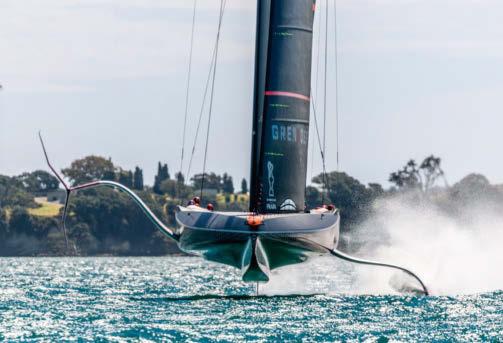

Just as an aeroplane wing has flaps at the back to create extra lift for takeoff, so too does an AC75’s foil, hinging upwards to get the boat out of the water. Once the boat breaks clear of the surface, the flaps line up with the rest of the foil, reducing drag.
Over the past 170 years, the America’s Cup – the oldest existing international sporting competition – has been about cutting-edge yacht racing: two rival yacht clubs (challenger and defender), pitting two boats against each other every four years on open-water courses. Each successive race has pushed the envelope in yacht design and technology. But with the 37th edition coming in late 2024, some argue that it’s now become less about sailing and more about flying.
That evolutionary leap can be pinpointed to November 21, 2017, when that year’s Cup winners (and therefore the team that got to decide the rules for the next America’s Cup – a tradition
The slender foils mounted on either side of the hull each weigh just over 1.2 tonnes, but need to support a vessel that, when fully loaded, weighs around 7.6 tonnes, and with far greater stresses on them when in motion. As such, they’re almost entirely constructed from high strengthto-weight carbon fibre.
Shaped primarily to promote early lift-off from ‘displacement mode’ (floating in the water) to foiling mode (in the air). Once up and flying, aerodynamics become vital. The top side of the boat is designed to minimise aero-drag. Where wind meets the front of the boat, the underside of the hull creates additional lift to help the foils do their job.
passed down from the sport’s inception) revealed the design for the 2021 boat, the AC75. Team New Zealand’s (TNZ) spectacular concept vessel would fly on one foil, with nothing else touching the water except the tip of the rudder. There were many who doubted it would work.

Yachts flying above the water on hydrofoils – similar to the wings of an aeroplane that dip into the water – have revolutionised the sport of sailing. And yet it’s a surprisingly old technique that has been around for more than 100 years and is now all the rage in Europe and America, where sailors in traditional boats have long been accustomed to turbo-powered dinghies whizzing past them at ridiculous
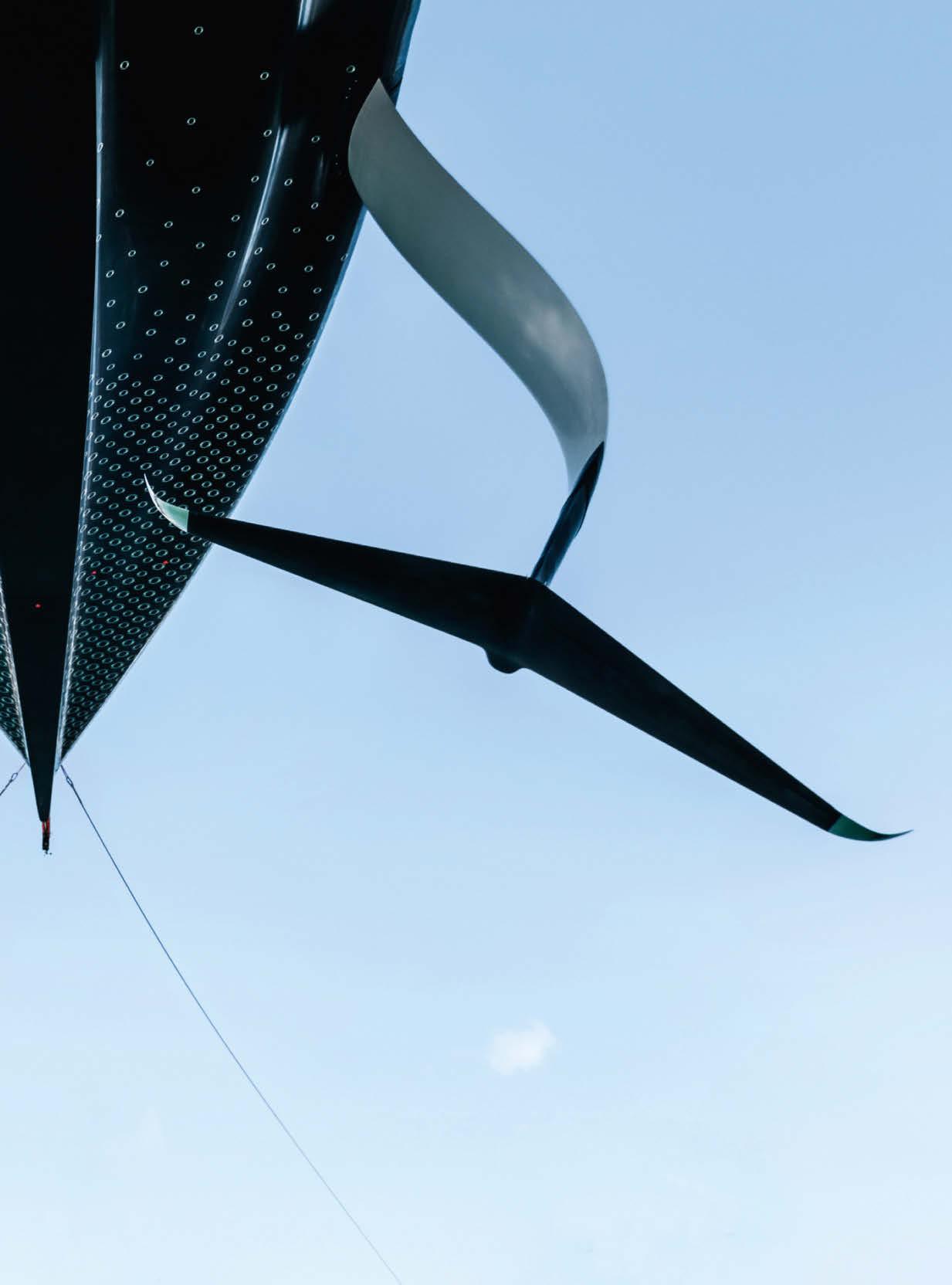
speeds. But the unimaginably fast AC75 class changed everything.
Travelling at up to 90kph in winds of 40kph, these rocket ships of the new foiling era have reimagined the very idea of a sailing vessel. Not only do they have canting foil arms on each side of the hull, but also no keel – the heavy structure underneath a boat that keeps it upright and counterbalances everything above the waterline. Without one, the AC75s have very poor stability and, much like a bicycle, can easily tip over when moving too slowly.
The 2021 Cup showed that the concept worked and, what’s more, could produce excellent grand prix sailing that’s more Formula One than old-fashioned yachting. So much so that the 2024 Cup in Barcelona will not only see TNZ’s second defence of the title it won in Bermuda in 2017, but will feature almost the same spec of boats, only faster.
Foiling has also transformed the nature of crew work in the Cup. Traditionally, the key role was the helmsman, and while that position is still hugely influential, a new discipline of ‘flight controller’ or ‘pilot’ now rivals it in importance. These sailors control the deployment of the foil arms and manipulate the position of the flaps on their trailing edges. It’s a dark art where fluid dynamics , which influence the hull shape when it is in the water, meet aerodynamics, which help determine the hull’s best profile when flying above it. A hybrid of sailing and aviation.
balancing act, then your boat speed begins to rumble and you get forward motion,” explains Scott. “Going from six to 10 knots is quite hard. Going from 10 to 14 is easier, but there’s still a bit to it. But from 14 to 40 knots, speed comes really, really quickly. That’s because the foils suddenly switch on and the sails are generating more and more power because you’re sheeting them on harder.”
The AC75 is unstable until it starts moving, and at low speeds it can even tip over. To use the stationary bike analogy, the foils provide a small amount of side-to-side stability, like training wheels.
Apply the brakes on a bike too quickly and you could be thrown over the handlebars. Same here. Get the trim of the foils slightly wrong and it’ll nosedive into the water. At 90kph, that can be catastrophic. With no seatbelts, you can see why the crew wear crash helmets and wetsuits.
Sometimes an AC75 will launch out of the water like a killer whale. This looks spectacular, but it’s not fast and it puts the boat at great risk, as the American Magic team found to its cost in the 2021 America’s Cup (pictured above), when a strong gust of wind struck the sails, delivering a sudden increase of power during a manoeuvre. When the boat slapped back down, the impact punched a hole in the hull and the vessel capsized. Amazingly, it didn’t sink and no one was injured, but it spelled the end for the New York Yacht Club’s campaign in Auckland.
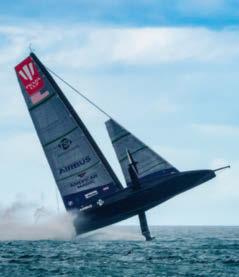
Giles Scott, a double Olympic gold medallist and head of sailing for the British America’s Cup challenger INEOS Britannia, says it requires a delicate combination of inputs to get the AC75 underway from standstill and to release its almost limitless power. The speed increases slowly at first, but then the boat will accelerate like an aircraft in a catapult.

“The helmsman, the pilot and the trimmers [who adjust the sails to maximise forward force] are playing this
Early on, AC75 sailors just wanted to fly in a straight line once they’d settled their boat down on a leg of the racecourse, but the focus quickly shifted to flying around corners as well. Now, they’ve reached a point that would have been considered absurd just a few years ago, where one of the worst things that can happen is to see the hull drop back into the water, or ‘fall off its foils’. At that point it becomes an old-fashioned sailing boat subject to enormous drag, its speed cut to a third or perhaps even a quarter of what it was achieving seconds earlier, as it pushes water around, trying to get back up on its wings.
It all adds up to a strange creature –part yacht, part upside-down aeroplane – that’s crazily fast and not seaworthy beyond inshore waters. And that’s new, too: the AC75s are the first America’s Cup boats in the competition’s history that you couldn’t use on the open sea to transport you from one place to another. They’re too delicate, too fast and too unstable for all but the tamest of conditions – you’d soon require the assistance of a lifeboat to get back to dry land. “There’s absolutely no way you’d think of doing that in an AC75,” laughs Scott at the suggestion of crossing the English Channel in one. “You’d total the thing before you’d got out of sight of land.”
But he also believes this revolutionary class of boats will exert a huge influence on future yacht design: “You’ll see boats that are a lot closer to the AC75 doing that sort of sailing.”
The buzz of sailing the AC75 is still thrilling to Scott even after several years of sailing them, but, he says, it’s never been about absolute speed. “The adrenaline is amazing, but ultimately it’s a game of delta speed,” he explains, referring to the difference in pace between you and your opponent. “In the Olympics, I raced at four-and-a-half knots in a Finn [single-sailed, singlehanded] dinghy, but if I was able to do that at a fraction of a knot faster than my competitors, I was happy. All we want to do is go faster than anyone we’re racing.”
“From 14 to 40 knots, speed comes quickly, because that’s when the foils switch on”
Giles Scott, INEOS Britannia
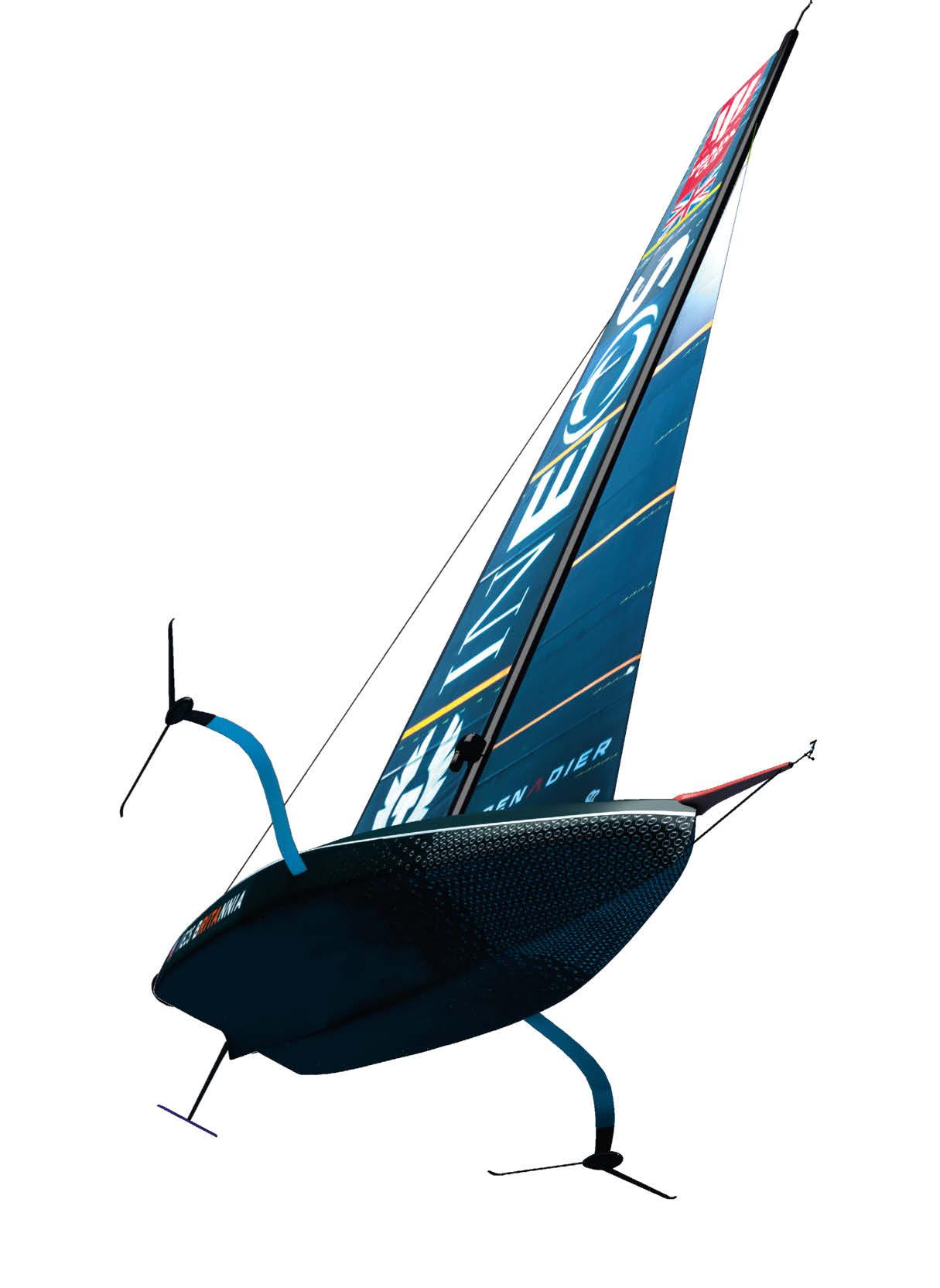
stress the animal out.” Next, get a pole and rope and lasso it over the top jaw. Then you can heave the croc out of the water: “Do it quick – you don’t want it rolling and smashing itself up.” On land, its mouth is closed with duct tape and a towel taped over its head, shutting down its sensory organs. You can then secure its back feet.
They say the person who feeds a crocodile is the one it’ll eat last. Here are a few –more practical – tips on surviving a croc encounter, from a man who protects them
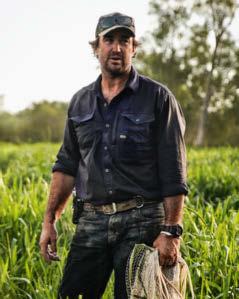
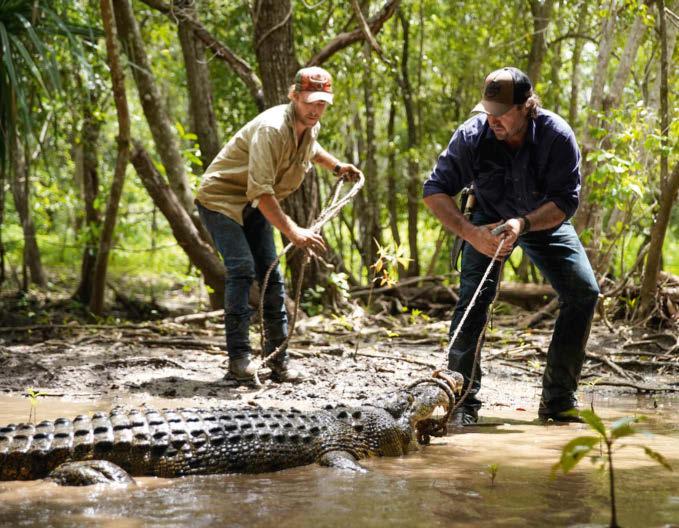
While many kids in the ’80s spent their free time watching cartoons, Matt Wright’s idea of fun was a little different. “I was catching wildlife,” says the now 43-year-old crocodile wrangler and conservationist, who was raised in Papua New Guinea and the Australian Outback. These weren’t your gardenvariety snails and frogs, either. “[There were] tiger snakes, brown snakes, death adders…” Wright says, listing three of Australia’s deadliest reptiles. Aged 10, he had a collection in his bedroom to rival most zoos.
Wright’s passion for wildlife grew; as an adult, he took a job as a mustering pilot, herding cattle with a helicopter. But his attention returned to reptiles.
“A crocodile’s favourite meal is cattle,” he says. “The station owners threw me in the deep end and I had to catch a few.”
Entirely self-taught, Wright had begun trapping small crocs at
16, with his first big catch at 21. He’s since caught “thousands”, the largest almost 6m long and weighing half a tonne.
Now, as presenter of his own Netflix show, Wild Croc Territory, Wright is educating
people on the conservation of his country’s endangered reptiles. Here, he shares some croc-catching techniques.
Risk assessment is key. Consider the environment, the size of the trap, the water, and how slippery it is, says Wright. “Don’t put yourself in a situation you’re not going to come out of.” Nowadays, he’s able to preempt a crocodile’s next move “nine times out of 10”. And on that 10th occasion safe ground is close by: “I only have to step back to be outside the zone where it’ll hit me.”
Hopefully you’ll never need to do it, but catching crocs is vital work for a conservationist. It starts with a baited metal trap. Setting it up in water helps the croc feel secure. “Don’t go in too fast,” he warns, “or you’ll
In Wright’s business, there are always close calls. His closest? “I had a tooth go through my chin. I was holding a 10-footer when it swung and hit me. Its mouth was shut, but it opened up my chin. That hurt. I haven’t been bitten as such. If I had, I wouldn’t have a hand.” Wright says you must embrace your fear: “Go in complacent and you’ll get hurt. I’ve had people with too much ego wanting to work with me. They’re a danger to my team and the crocodile, so they don’t get a job again.”
“You get tourists jumping into the worst places, where there are the biggest crocs I’ve ever caught. It’s about education – don’t swim in lagoons or rivers in the north of Australia or you’ll get eaten.” If you see a croc on land, you can walk calmly away. But if you’re in the water, get out. “They won’t run up the bank and chase you. They’re stealthy – they’ll wait for you to enter the water.”
Being an apex predator doesn’t help the crocodile’s image in the eyes of humans. “Many animals are misunderstood, and crocs are one of them,” says Wright. Climate change is impacting their habitat, though Wright thinks it’s unlikely they’ll go the way of their prehistoric ancestors. “They’re resilient. The only thing endangering them is rednecks trying to shoot them. If the world turned to shit, the last thing alive would be a crocodile.”
Wild Croc Territory is available to watch on Netfix now
“Crocodiles are misunderstood by many people”
Matt Wright, conservationist
ice cream cone right after.
paint pen to autograph a couple decks. He signed someone’s
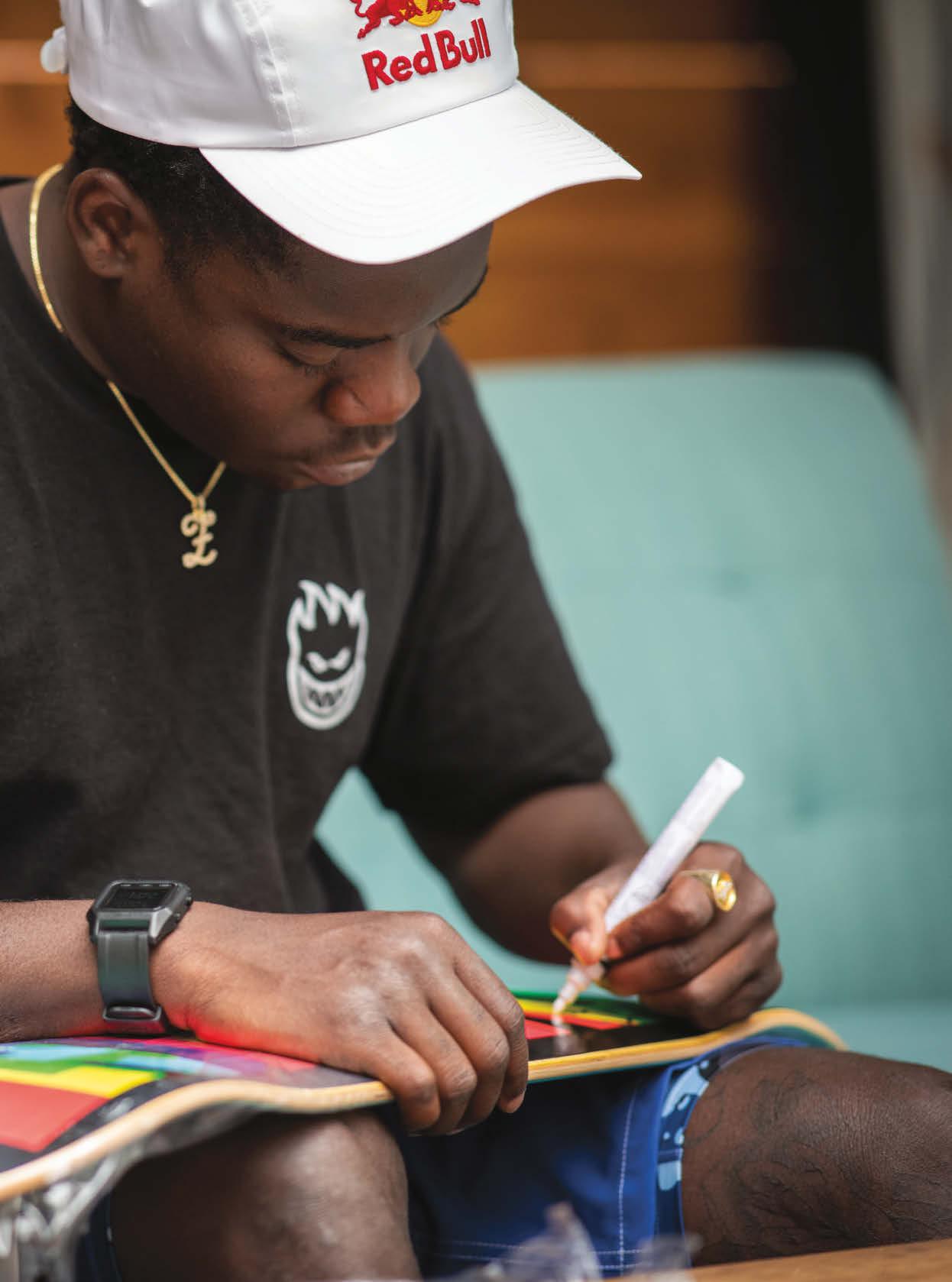
Miller’s Social Surf Club, Zion took a few minutes with a white
different type of stack. This stack was for the kids. At Zach
part, Zion is either hanging with the homies or working on a
Between international travels to stack clips for his next video
@zionwright @blabacphoto

Always wear a helmet. But all rides aren’t equal, so kit out your cranium correctly

Mountain bikers require a visor to block dirt and sun on the trails, and an elongated rear for impacts – the TROY LEE DESIGNS Flowline SE (top left; troyleedesigns.com) has all that plus MIPS brain protection and 14 air vents. For the commuter, looks are everything, both for style and for safety – the NUTCASE Vio Rozay (top right; nutcasehelmets.com) has a 360° LED system, a 200-lumen headbadge and is fully reflective. BMXers need to take the knocks and come back for more – modelled on retro skate helmets, the TSG Dawn Full-Cut (bottom left; ridetsg.com) is a tough polypropylene case with a shock-absorbing foam lining and ear protection. Road riders require speed and ventilation – the HJC Furion 2.0 (bottom right; hjchelmets.com) has an aerodynamic design with rear exhaust, giving back seven per cent of a rider’s energy.
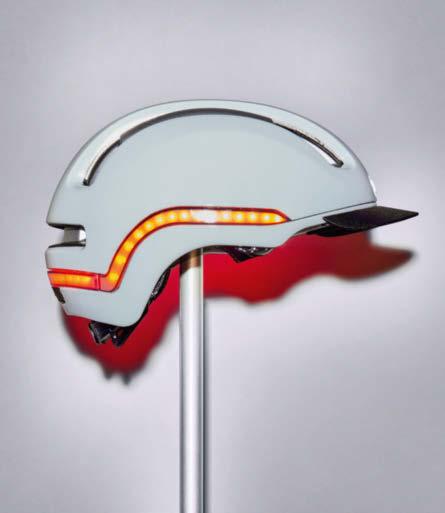
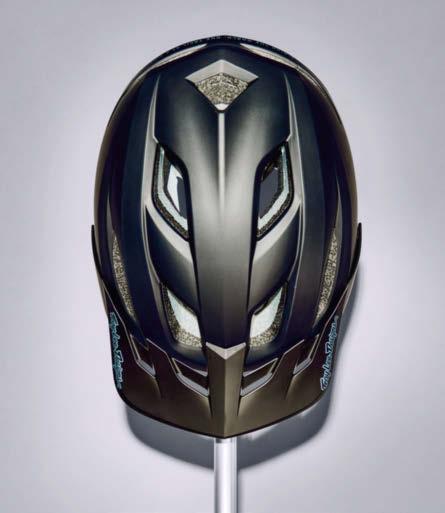
For time-triallers, speed is everything – the LAZER Volante (lazersport.com) is wind tunnel-tested for optimal air flow, with a tail space for holding ice or your long locks.
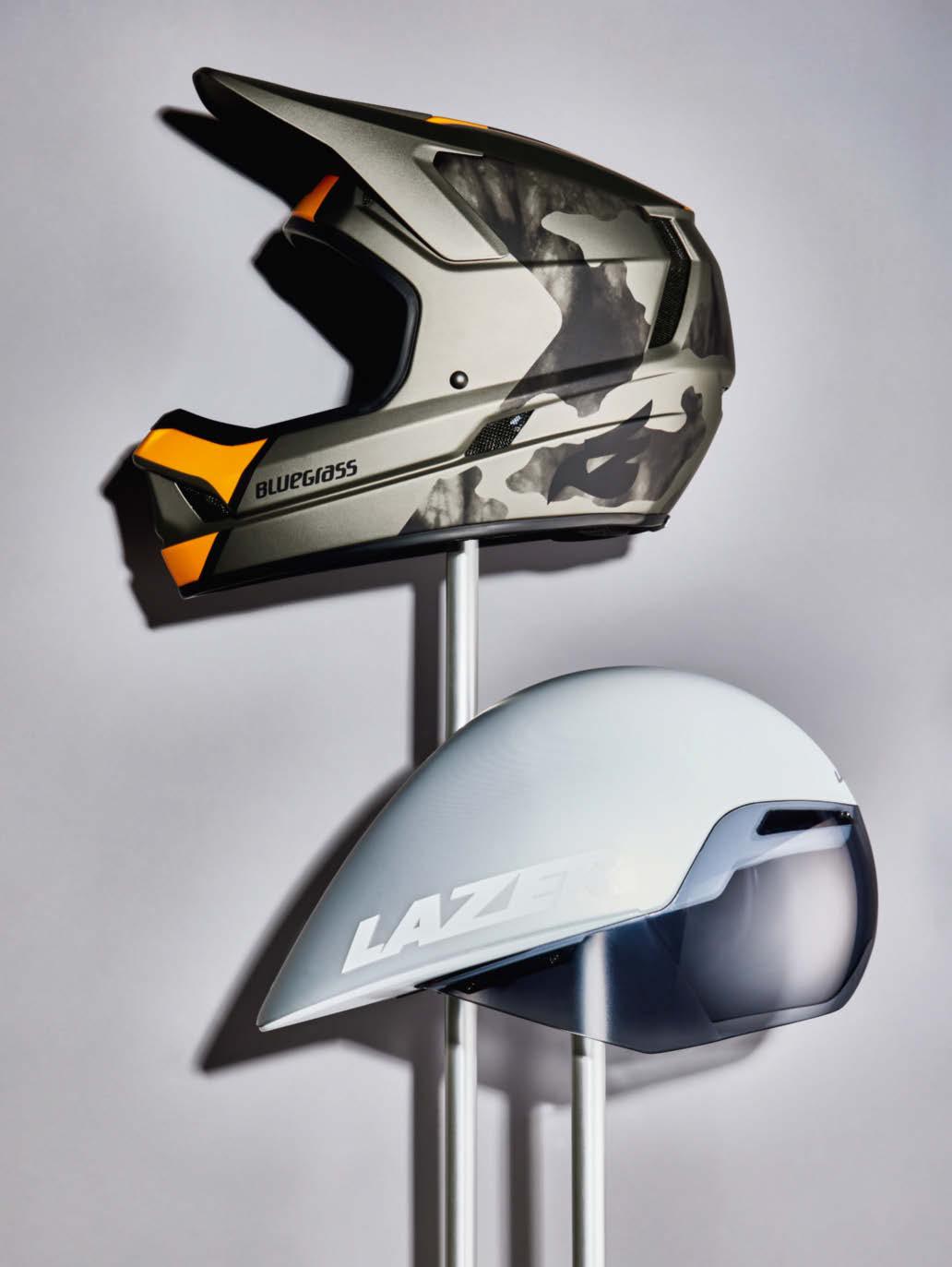
For hardcore MTBers, there’s the full-face helmet – the BLUEGRASS Legit (methelmets.com) has a composite fibreglass shell and antitwisting, safety-release visor.
Reissues and remakes of iconic games now rival new releases, but the process isn’t as simple as hitting copy and paste
Silent Hill GoldenEye 007 Final Fantasy VII. You’d be forgiven for thinking we were revisiting gaming history, but these are actually some of the most anticipated releases of 2023. It’s not a new trend, either; Tony Hawk’s Pro Skater and Resident Evil are two more turn-of-the-millennium titles that have had a glow-up for the latest wave of consoles. So, what is (mega)driving this desire to replay the past?
“We have our first group of people in their forties and fifties who were playing games 10, 20 years ago,” says Chris Payton, director of content for gaming developers Unity, “and they want to relive that – just like you might listen to an old album or watch a Led Zeppelin tribute band.” Previously head of art at independent games studio Rebellion, Payton worked on remasters of thirdperson shooters Rogue
Trooper and Sniper Elite V2
Unlike the pleasure of replaying old vinyl, rose-tinted memories are soon dashed
when an original console and game meet a modern monitor.
“When we think of retro games, we remember them being super-slick with great graphics, because they were at the time,” Payton says. “But output resolution for the PlayStation 2 was 640 by 480 [pixels], which is phenomenally low. On your 32-inch screen, it would look like a pixelated mess.”
Remastering is the answer, and if the original title is still selling well on online videogame distributors such as
Steam or GOG.com, it’s a cheap and guaranteed way for developers to cash in on this nostalgia-fest. “You’ll spend a few million dollars – a relatively small amount compared with starting from scratch – with the knowledge that your product will sell well.” These games are not just for the OG fans, either: “They get sugar-coated so a new audience can experience the same old gameplay.”
A game is created by three groups: the coders, the design team and the artists. For a remaster, the designers’ legwork is already done. “The underlying gameplay is the thing that makes it great, so you don’t want to mess with it,” says Payton. The coders set about making the game work on the new platforms, while the art team revive the visuals.

Sometimes, gameplay requires a rethink to fit today’s expectations. Final Fantasy VII’s

original turn-based, Dungeons & Dragons-esque combat system felt out of date even in its original release, so developers shifted to a hybrid set-up for the 2020 Remake (a 25th anniversary update, Rebirth, pictured, is due for release this year). In the new set-up, players can mash the keys Tekken-style or opt for more strategic (and damaging) menu-based attacks. “A modern market seeks more instant gratification,” explains Payton. “Some of my favourite games were turn-based, but they’re slow and frustrating when I go back to play them.”
Remasters don’t only have to factor in improvements in games consoles. “Fifteen years ago, all screens were 4:3 format,” says Payton. “Now, everything is widescreen.” Fortunately, developers don’t have to go about backfilling blank spaces that were previously off-screen: “Unlike in a film, where a set is built to match the camera, game environments are complete.” Instead, artists are able to focus on adding high-definition detailing that wasn’t previously possible.
Not all game remasters are controversy-free. Fans can be protective of how the game plays, its storyline, or, in the case of the 2020 PS5 reissue Spider-Man Remastered, the mask-free face of Peter Parker, which some thought was updated to look more like the latest actor to play him in the Marvel movies, Tom Holland. “There’s always a vocal minority who’ll kick up a fuss about small changes in design or art choices,” says Payton. “While you want your title to be commercially successful, you need to have the confidence to make bold decisions. A game is the sum of millions of design choices, and if there are just a few pulled out for critique you’ve done pretty well!”
“You have to be prepared to make bold decisions”
Chris Payton, game developer
Your custard tart-making boy-band fantasy just came true
BTS: so adorable you want to keep them as pets. Not our sentiments but those of toy firm Bandai America, whose TinyTAN Tamagotchis allow fans to nurture virtual versions of the Korean pop phenoms.
The Tamagotchi (Japanese for ‘egg watch’), a ‘digital pet’ housed in an ovoid, palm-sized video game, became a global hit when launched in Japan in 1996, selling 40 million units in the first two years. Its rudimentary gameplay – feed and train your charge to keep it alive – played no small part in this, and children clamoured to test their limited parenting skills.
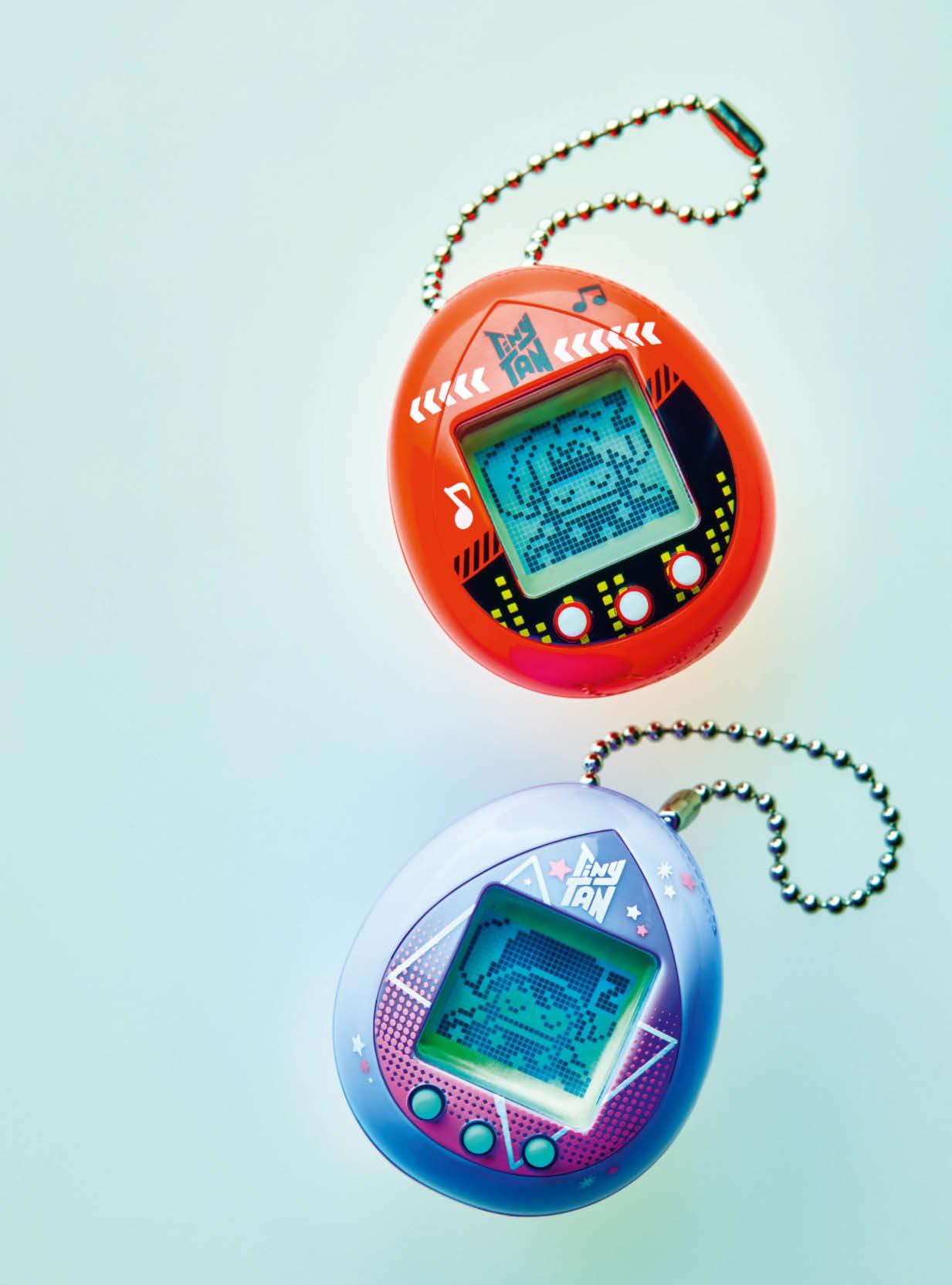
Named after BTS’s cartoon alter egos, the TinyTAN Tamagotchi offers two mini games in addition to the childcare chores: Dance! Dynamite!, a rhythm challenge, and Make the Custard Tarts!, an exercise in filling a pastry case. Keep your character happy and they’ll change outfits and hairstyles; neglect them and… well, this is BTS and they’ll never die, so instead you return to a ‘Magic Door’ for regeneration.
BTS’s fans, known as ARMY, can choose from all seven idols in either a ‘Magic Door’ or ‘MIC Drop’ version (both £19.99). Talking of armies, oldest band member Jin began military service in December. Can’t wait for new mini-games like Blast K-pop Into the DMZ! and Spot the Defector! bandai.com
These guys are sleeping right now, but, once awake, prodding the right buttons will keep them alive
Eat play love: the red ‘MIC Drop’ (with Suga) and purple ‘Magic Door’ (with Jungkook) TinyTAN Tamagotchis. Jin, J-Hope, RM, V and Jimin models are also available


Since 1976, this film festival in the resort town of Banff in the Canadian Rockies has judged each year’s best action-sports films before taking the winners on a worldwide tour. The 2023 showcase includes a ski-trek across a frozen Arctic fjord in A Baffin Vacation; highliner Rafael Bridi traversing between two hot-air balloons in Walking on Clouds (pictured), and Saving Glaciers, which tracks the retreat of Switzerland’s Morteratsch glacier. A reminder that if we don’t ensure the survival of our great outdoors, there will be nothing left to film. More than 50 locations nationwide; banff-uk.com

Perhaps you made it through Dry January without a splash, or maybe your spirits were dampened when you, um, dampened them with spirits. Either way, there’s no need to wait until Dry July or Sober October for another (alcohol-free) shot. Club Soda is part of the growing mindfuldrinking movement, holding festivals and pop-ups since 2017. Now, it has opened its first permanent venue. The shop sells more than 150 alcoholfree beverages, from beers and wines to kombuchas, but the bar is where the fun begins, with mixologists crafting mocktails and masterclasses hosted by mindful-drink experts. Hangover-free hedonism at its best. DruryLane,London;joinclubsoda.com
Maria Bertram Thomsen, Ylfa Rúnarsdóttir, Grace Warner and Nora Beck have a few things in common. The respectively Danish, Swedish (via Iceland) and US women are all rising stars in street snowboarding. They’re also the heroes of this all-female film, captured in Canada, Iceland and Finland, which opens hard with two solid minutes of them faceplanting off roofs and rails, and wrapping themselves around trees. Catch it on Red Bull TV. redbull.com
Until 2012, the Harmsworth Quays Printing Works was pumping out the Daily Mail and Evening Standard. But since 2017 it’s become more famous for pumping out the finest EDM as Printworks – a 6,000-capacity industrial temple of lasers, cathedral acoustics and metal gangways that’s hosted Aphex Twin, Peggy Gou, Secret Cinema’s legendary Star Wars (with its life-size, flying X-Wing fighter), and was used as a location for 2022 film The Batman. Sadly, it’s now set for demolition, but not before more than 40 shows from FUSE, The Hydra, Soweto Kinch and the London Symphony Orchestra, and more. Your last chance to say you were there. Rotherhithe, London; printworkslondon.co.uk


In Spanish, cerro abajo means ‘down hill’, but they should add the word loco to this South American mountainbike competition, because crazy it is. February 12 saw Valparaíso, Chile, (pictured) hold the most recent event. Now, the world’s longest urban downhill run – in Medellín, Colombia – is the newest stop, featuring narrow staircases, rickety gangplanks, graffiti-covered wallrides and even a few escalator drops. Catch the action live from Medellín, and the Valparaíso replay, on Red Bull TV. redbull.com
“I wouldn’t be working in the arts today without the London cabaret scene,” says British queer Black artist and poet Travis Alabanza who in 2017, aged 21, became the youngest person in residence at the Tate. This show, written by Alabanza and starring queer club scene legends, is about returning the favour and showcasing this iconic underground. RoyalCourtTheatre, London;royalcourttheatre.com

Editor Andreas Kornhofer
Editor-in-Chief
Andreas Rottenschlager
Creative Directors
Erik Turek (manager), Kasimir Reimann
Copy Chief
David Pesendorfer
Art Directors
Marion Bernert-Thomann, Miles English, Tara Thompson
Designers
Martina de Carvalho - Hutter, Kevin Faustmann-Goll, Cornelia Gleichweit, Carita Najewitz
Photo Editors
Eva Kerschbaum (manager), Marion Batty (deputy), Susie Forman, Tahira Mirza, Rudi Übelhör
Digital Editors
Christian Eberle-Abasolo (manager), Lou Boyd, Marie-Maxime Dricot, Melissa Gordon, Lisa Hechenberger, Elena Rodriguez Angelina, Benjamin Wolf
Editor-in-Chief Global Content
Tom Guise
Head of Audio
Florian Obkircher
Managing Editors
Ulrich Corazza, Marion Lukas -Wildmann
The Red Bulletin is published in six countries. This is the cover of our French edition for March, featuring B-Boy Dany Dann, who hopes to represent France in breakdancing at the Paris 2024 Olympics. For more stories beyond the ordinary, go to: redbulletin.com
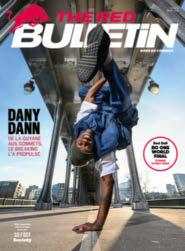
Publishing Management
Sara Car-Varming (manager), Ivona Glibusic, Julian Vater
Head of Media Sales & Partnerships
Lukas Scharmbacher
Editorial Director A lexander Müller-Macheck
Head of Co -Publishing Susanne Degn - Pfleger
Project Management Co-Publishing, B2B Marketing & Communication
Katrin Sigl (manager), Katrin Dollenz, Michaela Kroboth, Bernhard Schmied, Jennifer Silberschneider, Sophia Wahl
Creative Services Verena Schörkhuber-Zöhrer
(manager), Sara Wonka, Tanja Zimmermann, Julia Bianca Zmek, Edith Zöchling-Marchart
Commercial Management Co-Publishing

Alexandra Ita
Editorial Co - Publishing Gundi Bittermann, Raffael Fritz, Michael Hufnagl, Irene Olorode, Mariella Reithoffer, Wolfgang Wieser
Executive Creative Director Markus Kietreiber
Senior Manager Creative Elisabeth Kopanz
Art Direction Commercial & Co-Publishing
Peter Knehtl (manager), Luana Baumann-Fonseca, Silivia Druml-Shams, Erwin Edtmayer, Simone Fischer, Andreea Gschwandtner, Lisa Jeschko, Araksya Manukjan, Carina Schaittenberger, Julia Schinzel, Florian Solly, Sophie Weidinger, Stephan Zenz
Direct to Consumer Business Peter Schiffer (manager), Marija Althajm, Victoria Schwärzler, Yoldaş Yarar
Retail & Special Projects Manager Klaus Pleninger
Advertising Manuela Brandstätter, Monika Spitaler
Production Veronika Felder (manager), Martin Brandhofer, Walter O. Sádaba, Sabine Wessig Repro Clemens Ragotzky (manager), Claudia Heis, Nenad Isailović, Sandra Maiko Krutz, Josef Mühlbacher
Finance Mariia Gerutska (manager), Elisabeth Maier
MIT Martin Bartmann, Christoph Kocsisek, Michael Thaler
IT Service Desk Maximilian Auerbach
Operations Alice Gafitanu, Melanie Grasserbauer, Alexander Peham, Thomas Platzer, Raphaela Pucher
Project Management Dominik Debriacher
Assistant to General Management Sandra Artacker
CEOs Red Bull Media House Publishing
Andreas Kornhofer, Stefan Ebner
Editorial office Am Grünen Prater 3, A-1020 Vienna
Phone +43 1 90221 - 0 Web redbulletin.com
Published by Red Bull Media House GmbH, Oberst-Lepperdinger-Straße 11–15, A-5071 Wals bei Salzburg, FN 297115i, Landesgericht Salzburg, ATU63611700
Executive Directors
Dietmar Otti, Christopher Reindl, Marcus Weber
THE RED BULLETIN
United Kingdom, ISSN 2308-5894
Editor Ruth McLeod
Chief Sub-Editor
Davydd Chong
Publishing Manager
Ollie Stretton
Advertising Sales
Mark Bishop, mark.bishop@redbull.com
Printed by Quad/Graphics Europe Sp. z o.o., Pułtuska 120, 07-200 Wyszków, Poland
UK Office
Seven Dials Warehouse, 42-56 Earlham Street, London WC2H 9LA
Tel: +44 (0) 20 3117 2000
Subscribe getredbulletin.com
Enquiries or orders to: subs@uk.redbulletin.com. Back issues available to purchase at: getredbulletin.com
Basic subscription rate is £20.00 per year. International rates are available. The Red Bulletin is published 10 times a year. Please allow a maximum of four weeks for delivery of the first issue
Customer Service
+44 (0)1227 277248, subs@uk.redbulletin.com
THE RED BULLETIN
Austria, ISSN 1995-8838
Editor
Nina Kaltenböck
Proofreaders
Hans Fleißner (manager), Petra Hannert, Monika Hasleder, Billy Kirnbauer-Walek
Publishing Management
Julian Vater
Media Sales & Partnerships
Thomas Hutterer (manager), Michael Baidinger, Maggie Childs, Franz Fellner, Ines Gruber, Moritz Philipp Haaf, Wolfgang Kröll, Gabriele Matijevic-Beisteiner, Yvonne Mensik, Alfred Minassian, Nicole OkasekLang, Britta Pucher, Nicole Umsait, Johannes Wahrmann-Schär, Ellen Wittmann-Sochor, Ute Wolker, Christian Wörndle, Sabine Zölß
THE RED BULLETIN
Germany, ISSN 2079-4258
Editor
Maximilian Reich
Proofreaders
Hans Fleißner (manager), Petra Hannert, Monika Hasleder, Billy Kirnbauer-Walek
Country Project Management
Lisa Masten
Media Sales & Partnerships
Thomas Hutterer (manager), Michael Baidinger, Maggie Childs, Franz Fellner, Ines Gruber, Moritz Philipp Haaf, Wolfgang Kröll, Gabriele Matijevic-Beisteiner, Yvonne Mensik, Alfred Minassian, Nicole OkasekLang, Britta Pucher, Nicole Umsait, Johannes Wahrmann-Schär, Ellen Wittmann-Sochor, Ute Wolker, Christian Wörndle, Sabine Zölß
THE RED BULLETIN
Switzerland, ISSN 2308-5886
Editor
David Mayer
Proofreaders
Hans Fleißner (manager), Petra Hannert, Monika Hasleder, Billy Kirnbauer-Walek
Country Project Management
Meike Koch
Media Sales & Brand Partnerships
Christian Bürgi (team leader), christian.buergi@redbull.com
Marcel Bannwart, marcel.bannwart@redbull.com
Jessica Pünchera, jessica.puenchera@redbull.com
Michael Wipraechtiger, michael.wipraechtiger@redbull.co
Goldbach Publishing
Marco Nicoli, marco.nicoli@goldbach.com
THE RED BULLETIN
USA, ISSN 2308-586X
Editor
Peter Flax
Deputy Editor
Nora O’Donnell
Copy Chief
David Caplan
Publishing Management
Branden Peters
Advertising Sales
Marissa Bobkowski, marissa.bobkowski@redbull.com
THE RED BULLETIN
France, ISSN 2225-4722
Editor
Pierre-Henri Camy
Country Coordinator
Christine Vitel
Country Project Management
Alexis Bulteau
Contributors, Translators and Proofreaders
Willy Bottemer, Lucie Donzé, Paolo Fornaroli, Valérie Guillouet, AudreyPlaza, Claire Schieffer, JeanPascal Vachon, Gwendolyn de Vries
Tanya Foster, tanya.foster@redbull.com
Todd Peters, todd.peters@redbull.com
Dave Szych, dave.szych@redbull.com

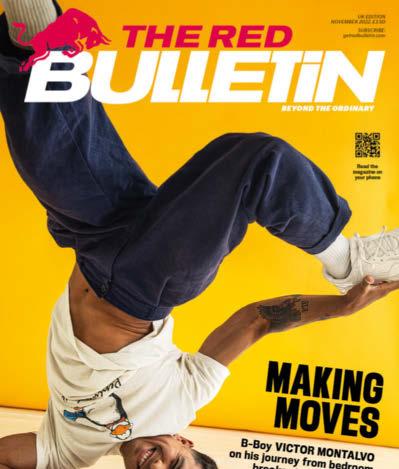
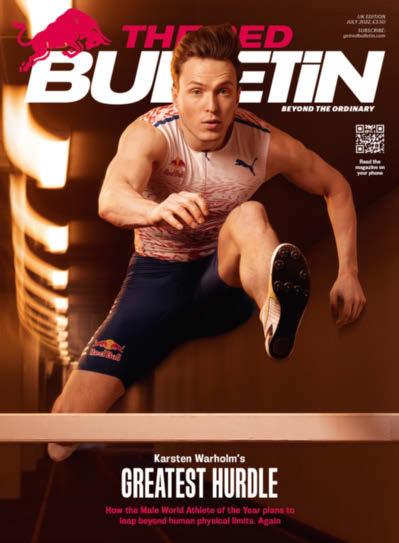
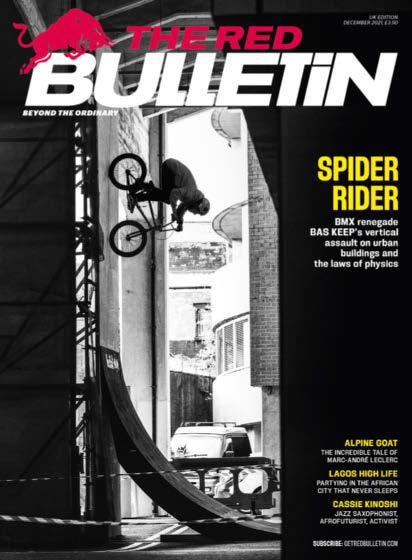




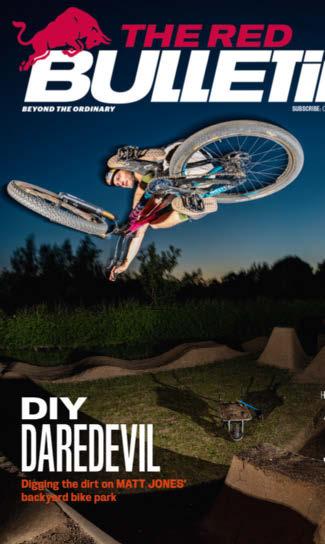
The next issue is out on Tuesday 14 March with London Evening Standard. Also available across the UK at airports, universities, and selected supermarkets and retail stores. Read more at theredbulletin.com
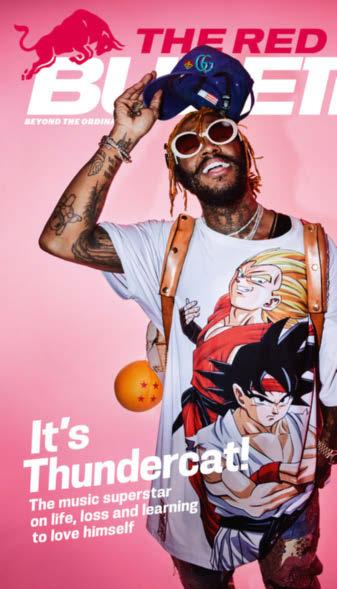
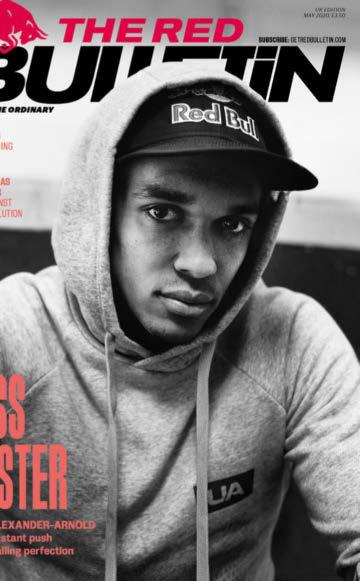

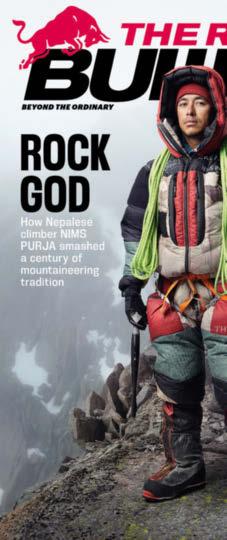

“I worked at an outdoor-gear shop for a year, and I started riding my old mountain bike there, eight miles each way. I might have, in the back of my mind, known that the knobby tyres were less than ideal for city street riding, and one day my shift manager kind of made fun of them. I mumbled something to him about my low rate of pay at the shop, which was true, but what was more true was that I didn’t really care if my bike was fast, or efficient; I just wanted to get some exercise on my way to work. Which I did. I think that in every outdoor sport there’s a blissfully ignorant stage when you’re a beginner and you don’t have the best gear – or even the right gear –and maybe you don’t care, because you’re having so much fun and you don’t know any better. So you just do your thing using what you have, which might include jeans, which I think is great.”
The next issue of THE RED BULLETIN is out on March 14
